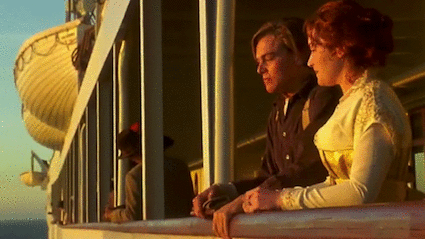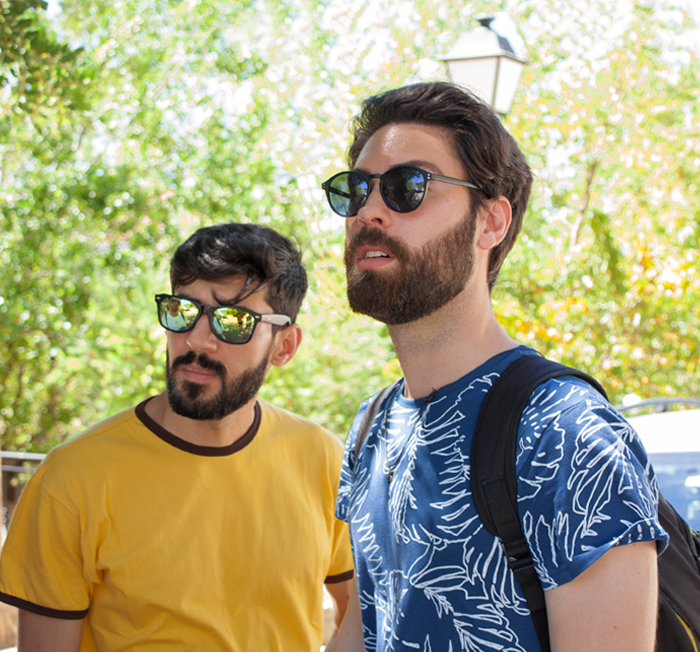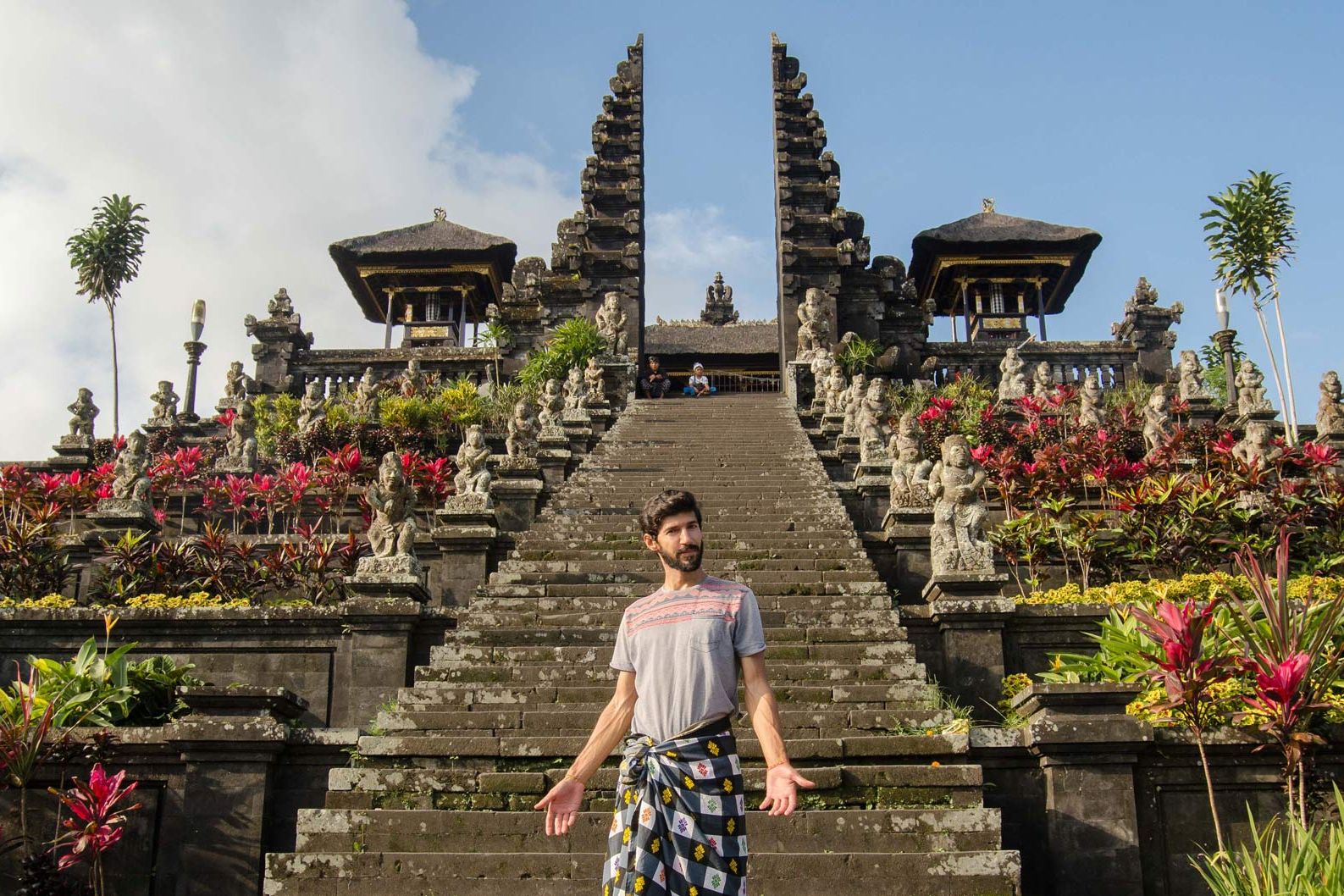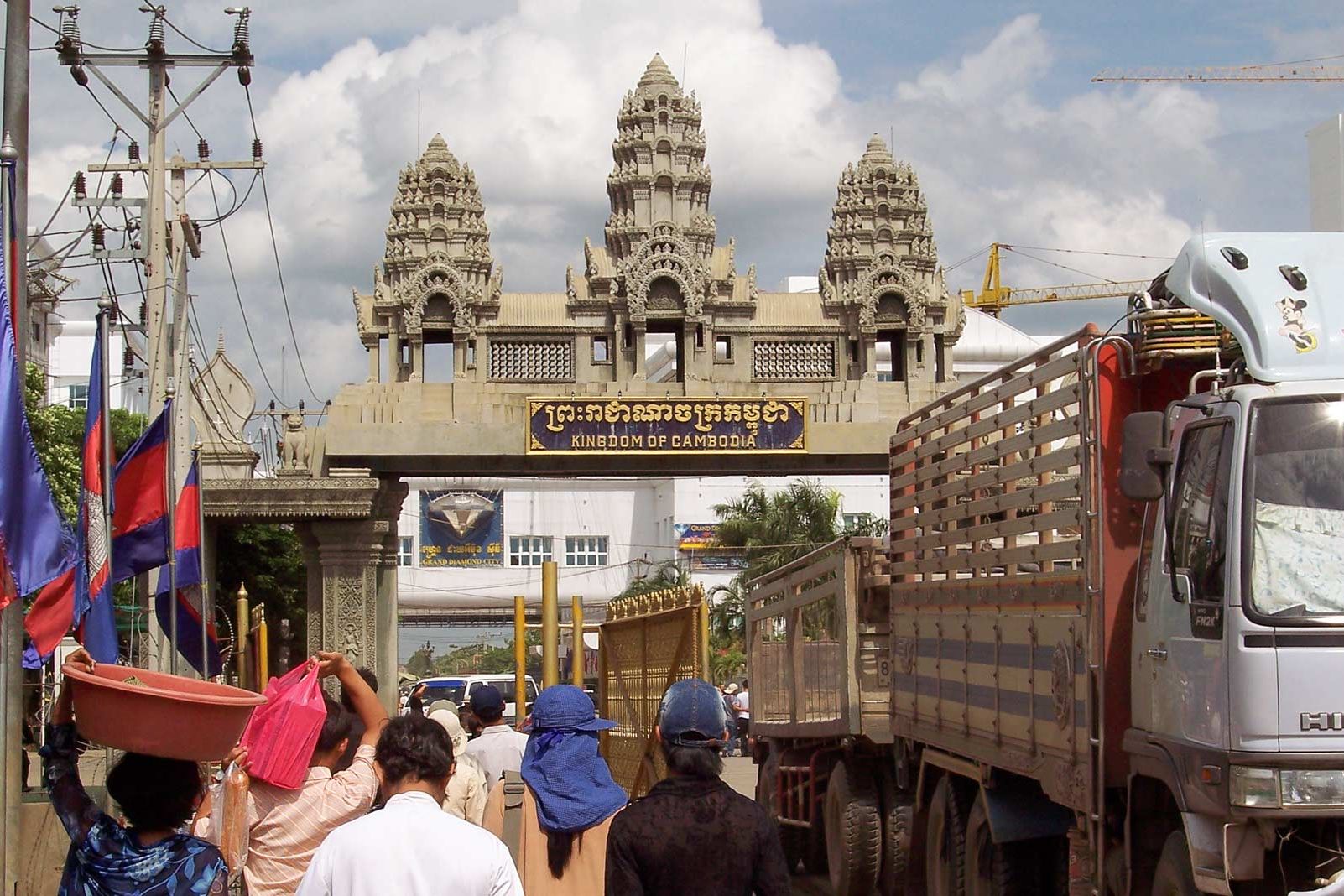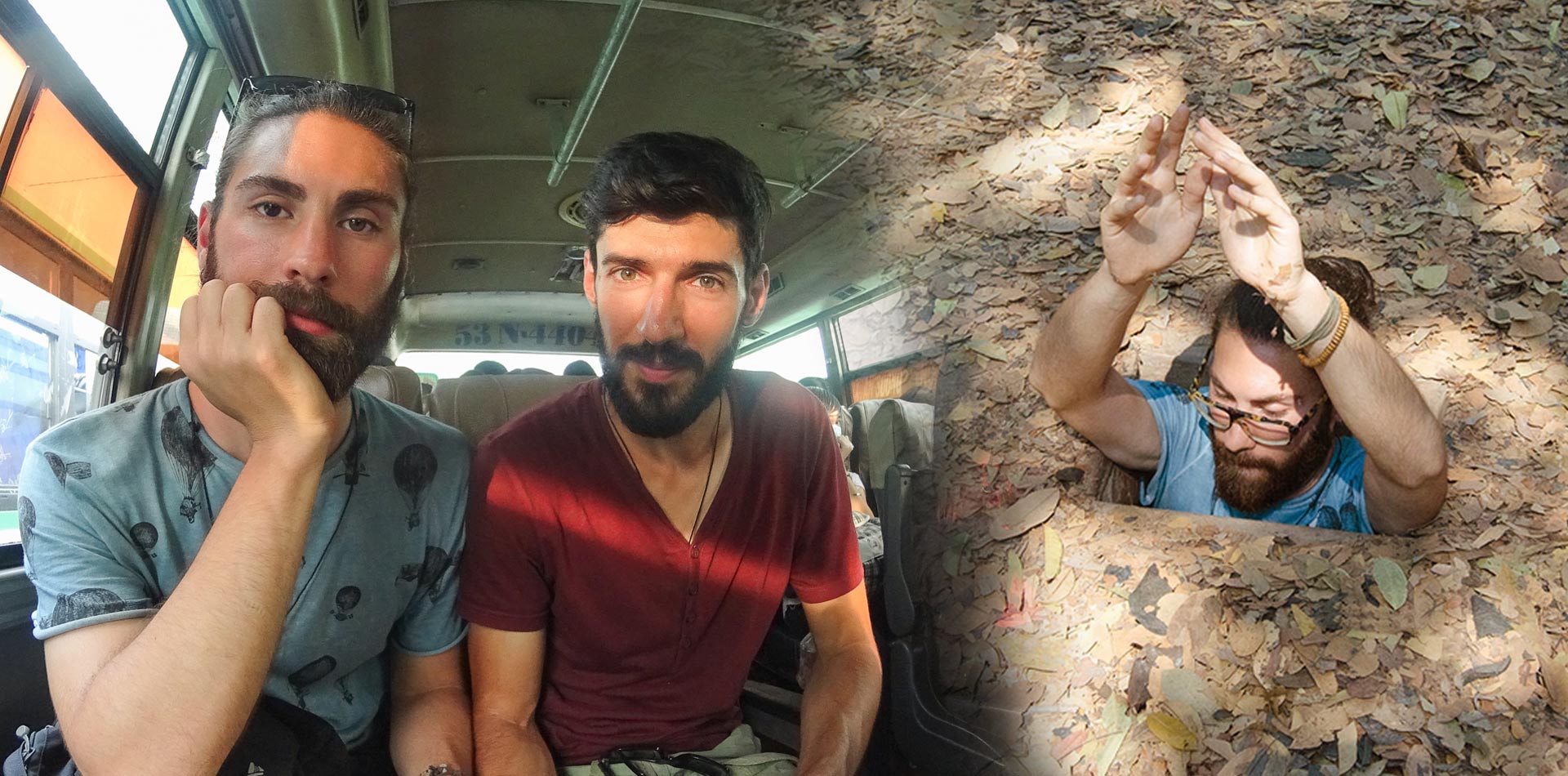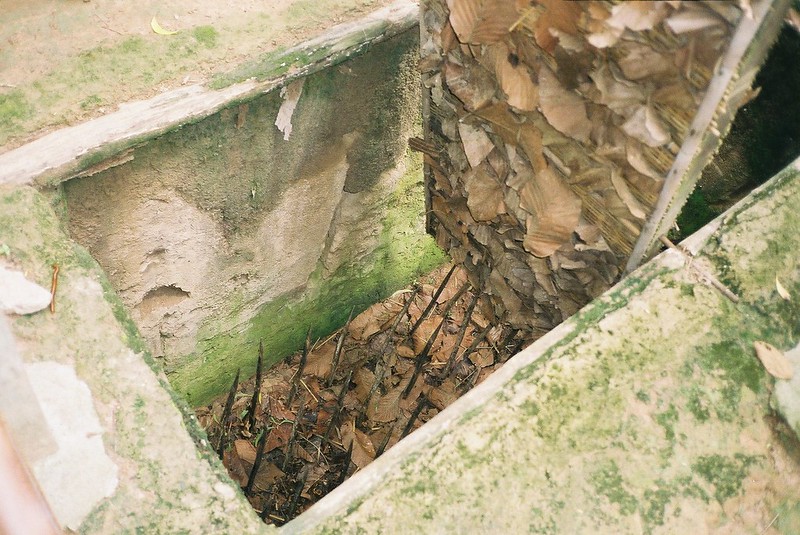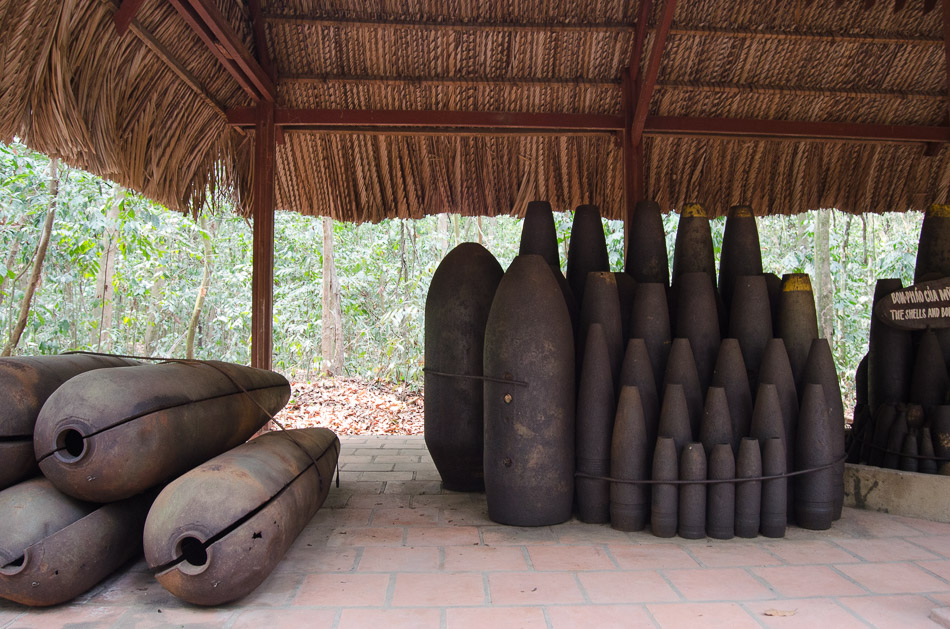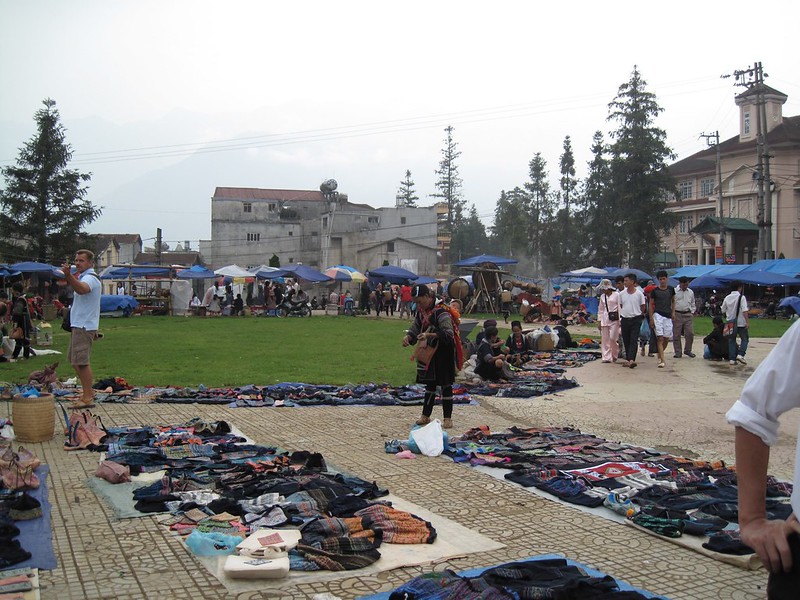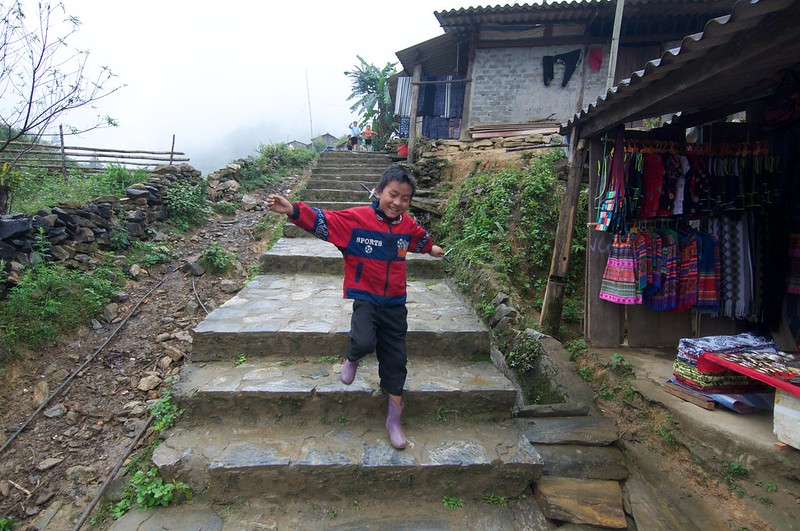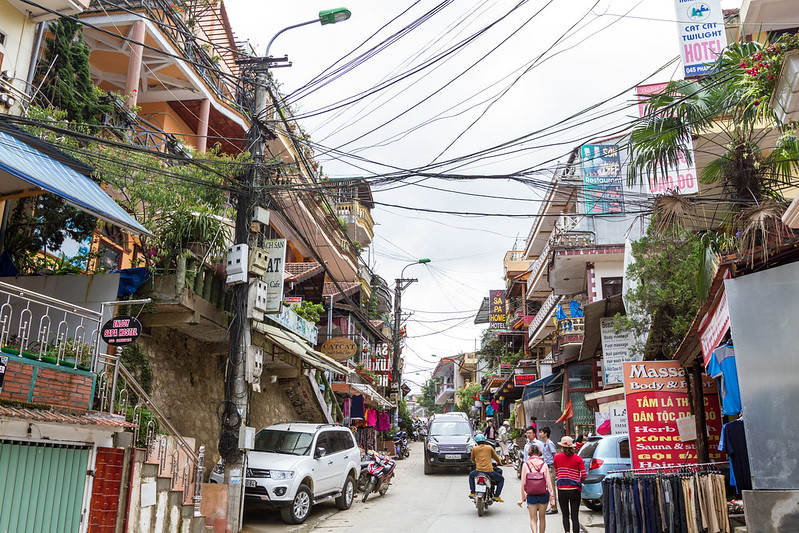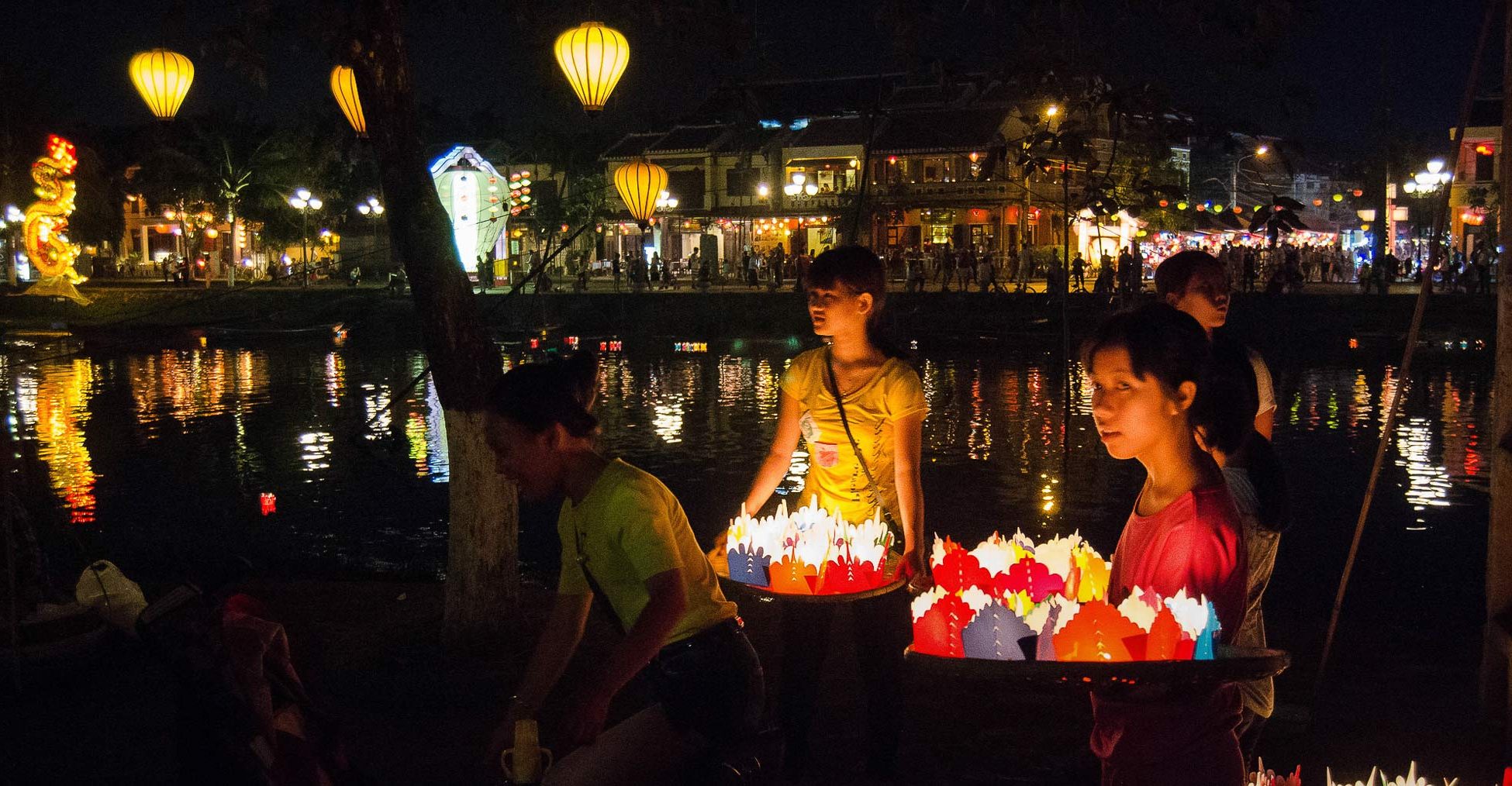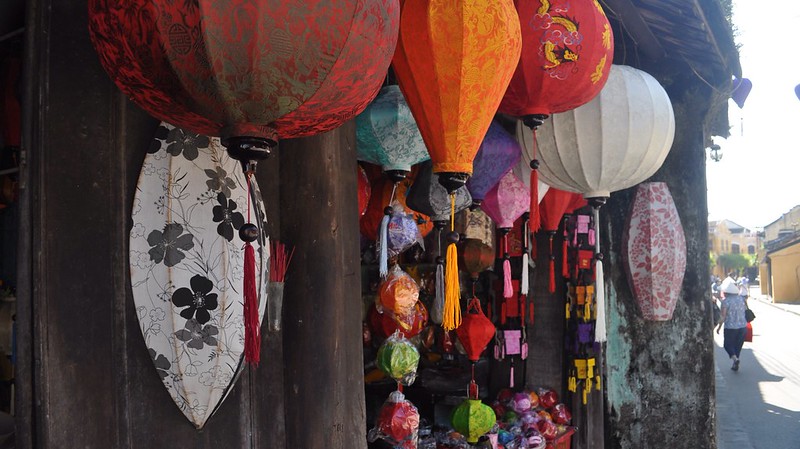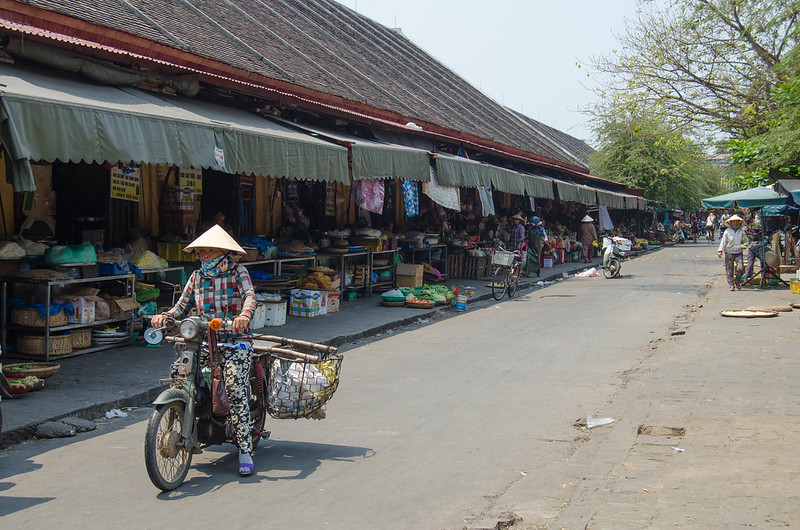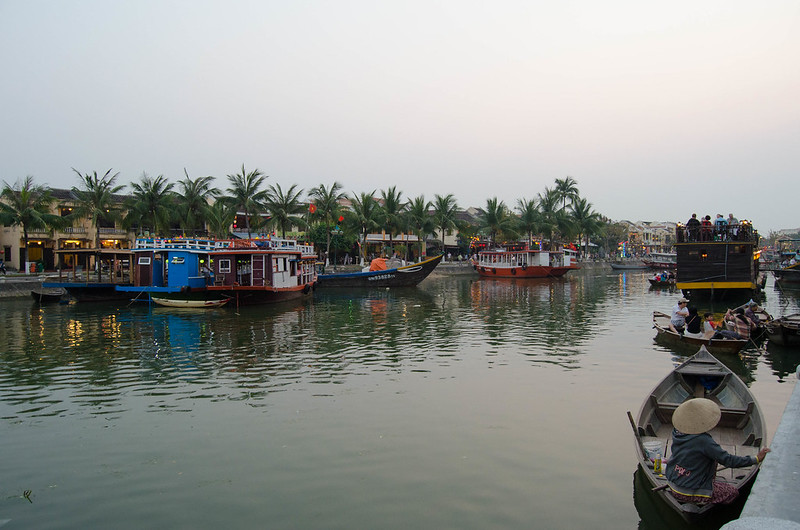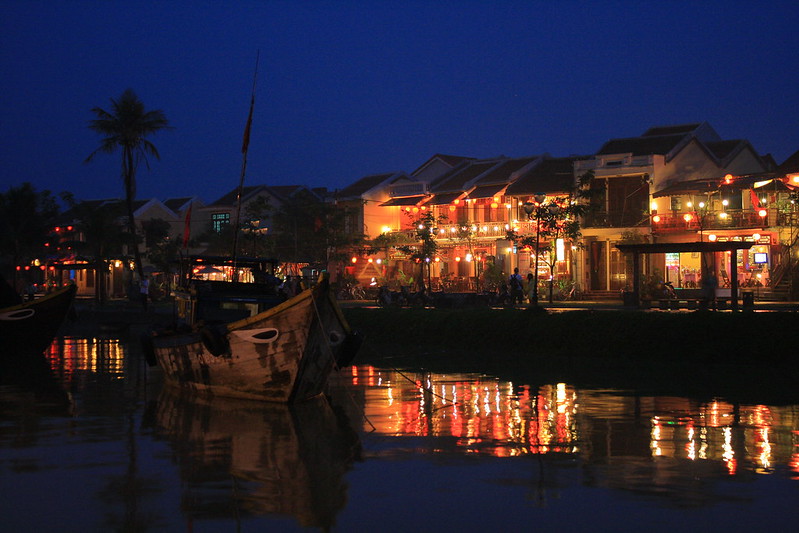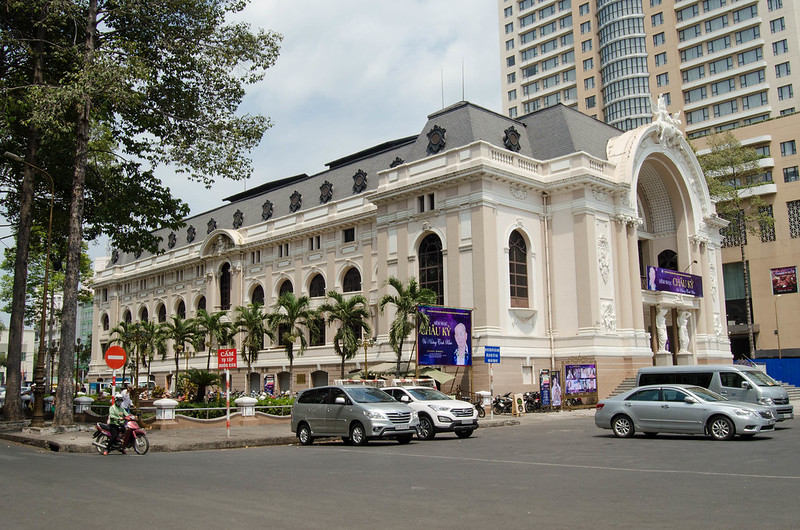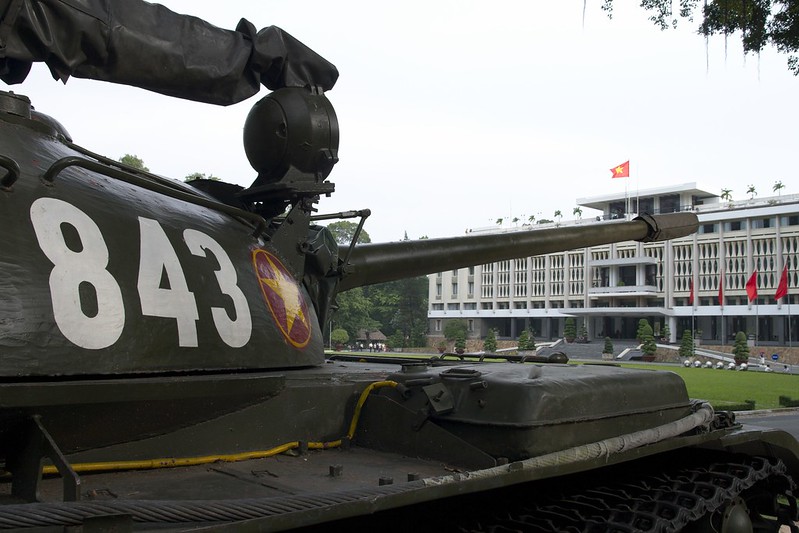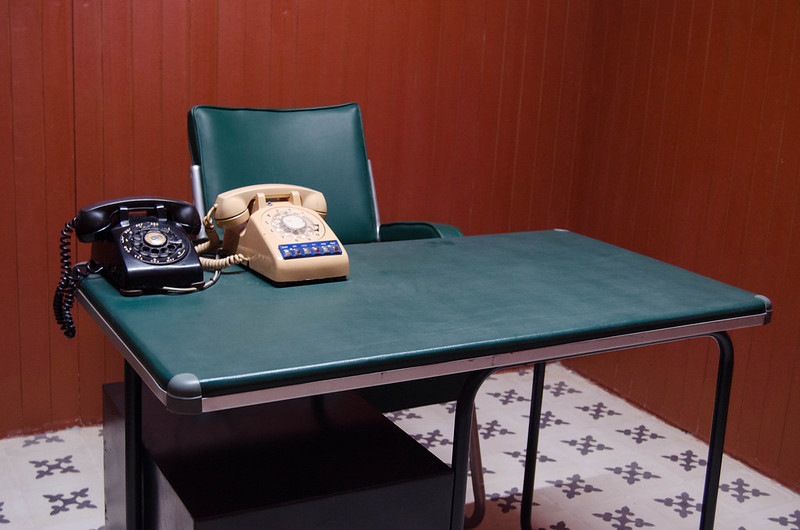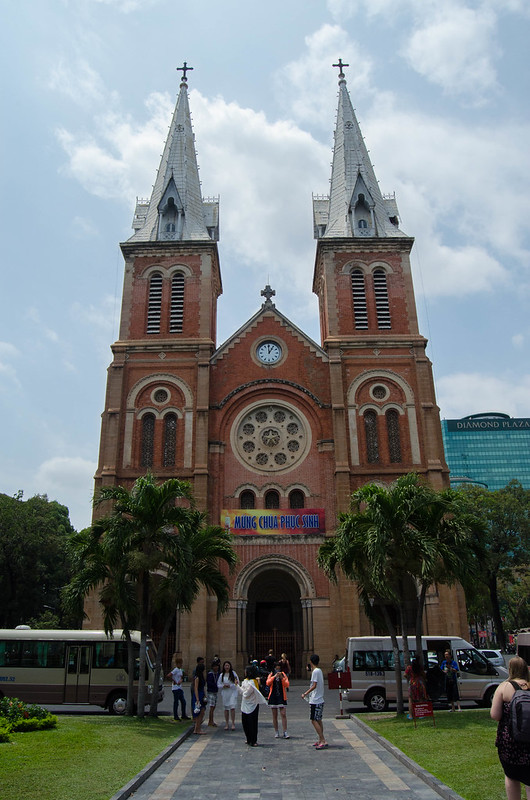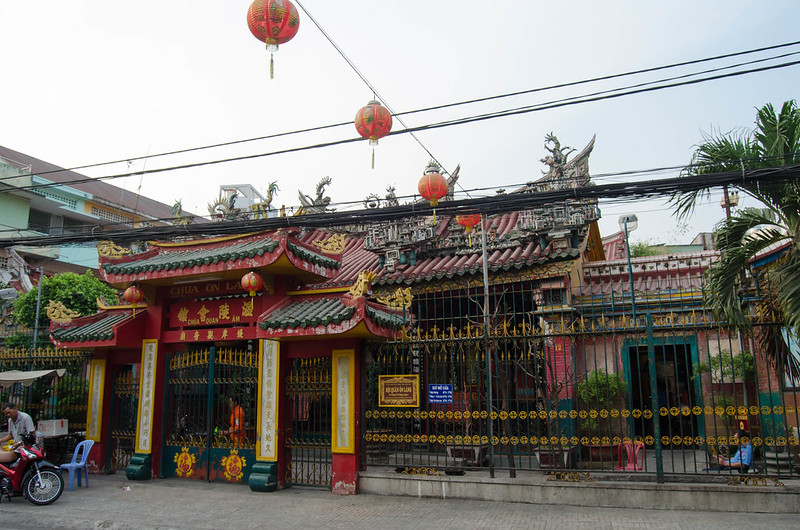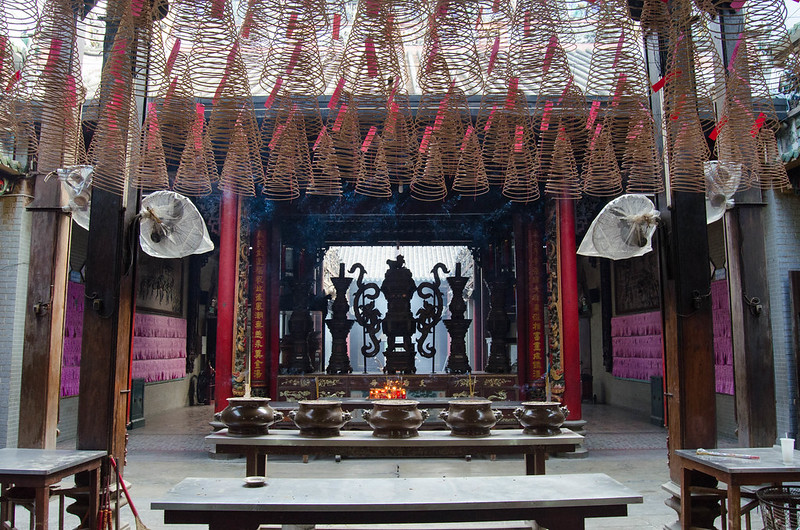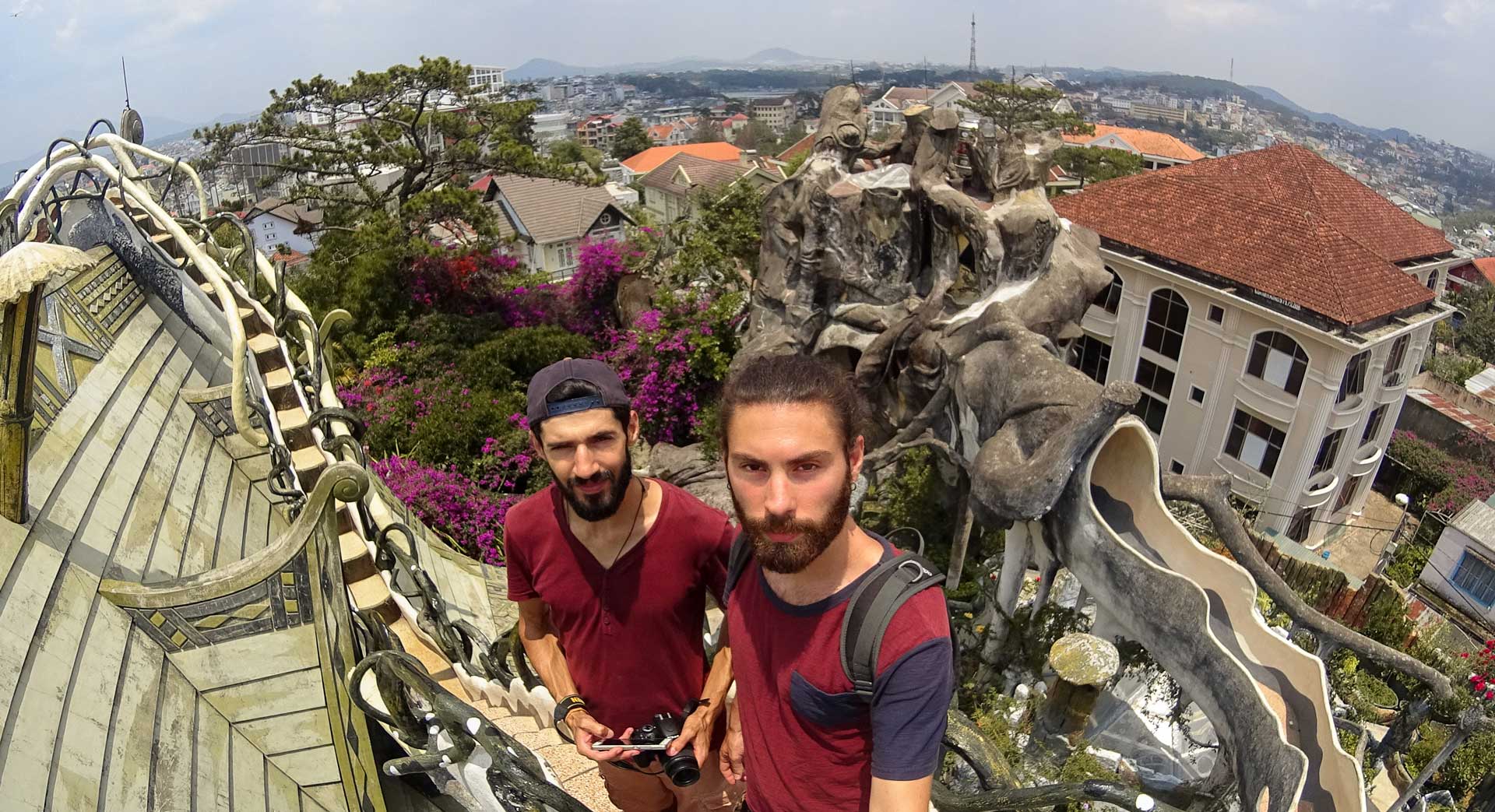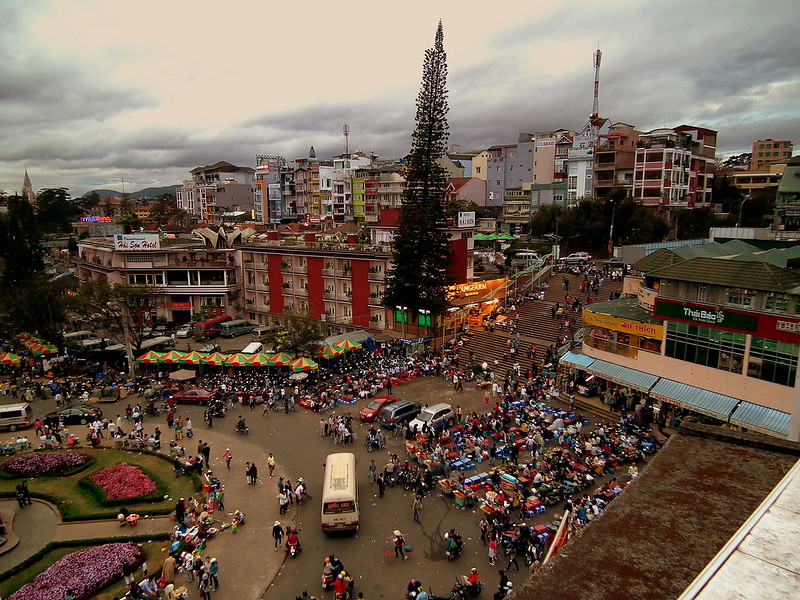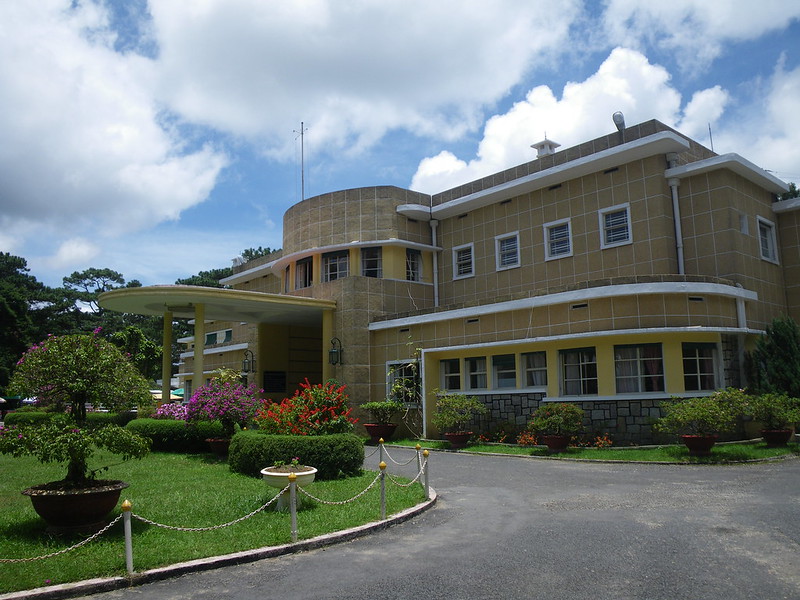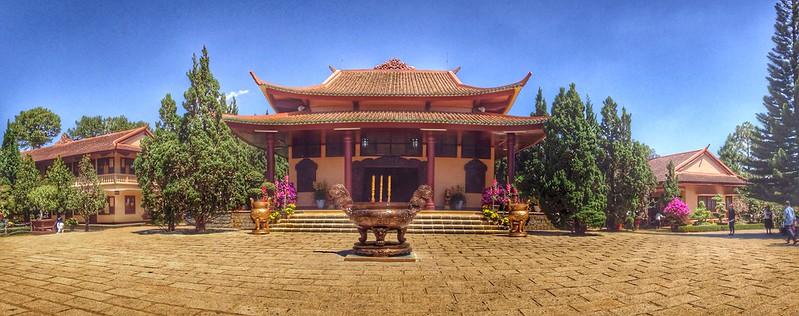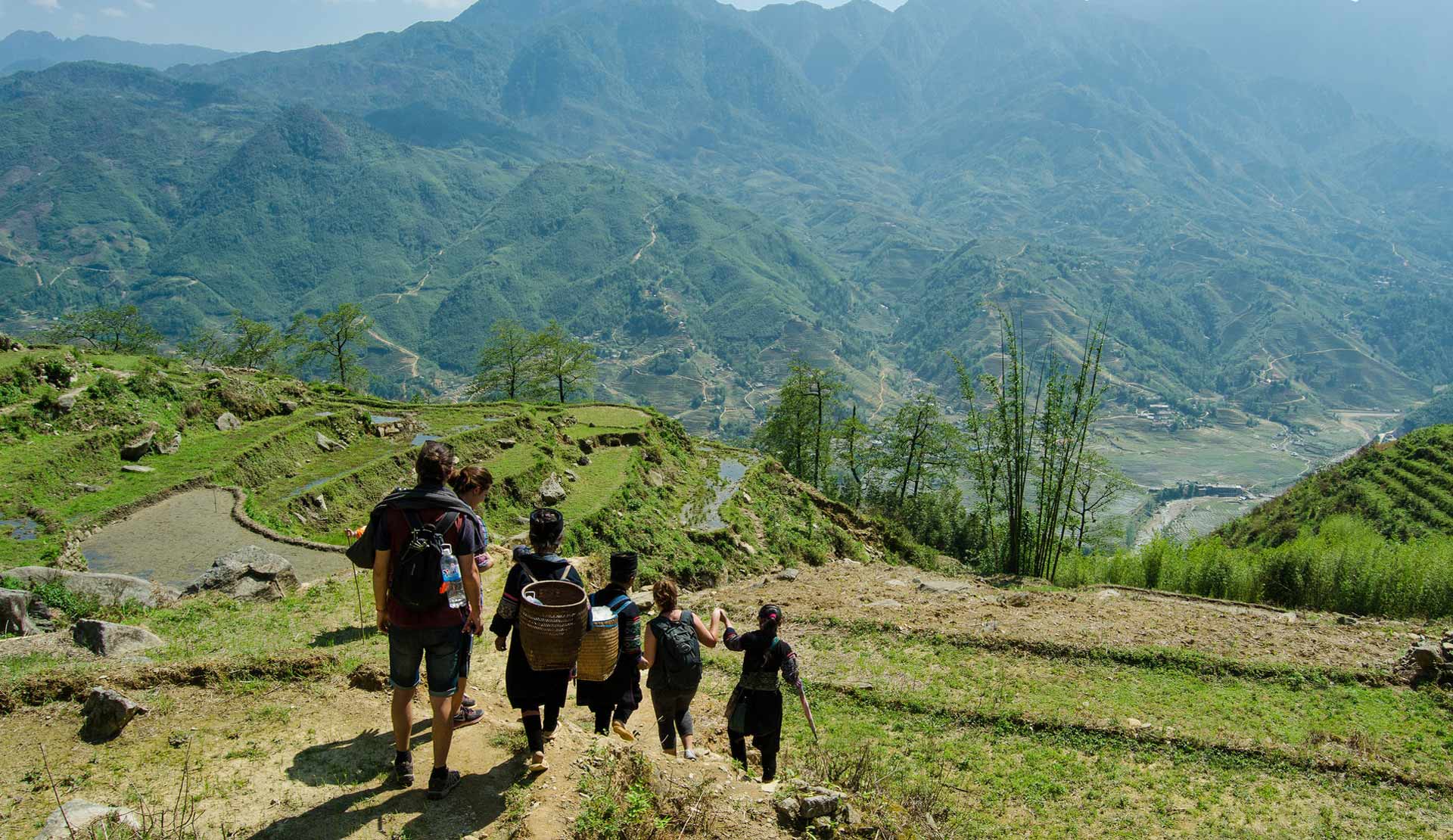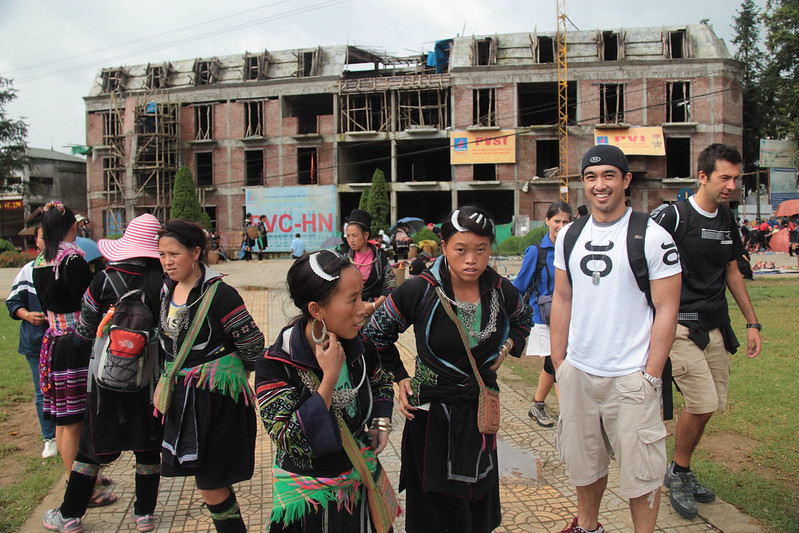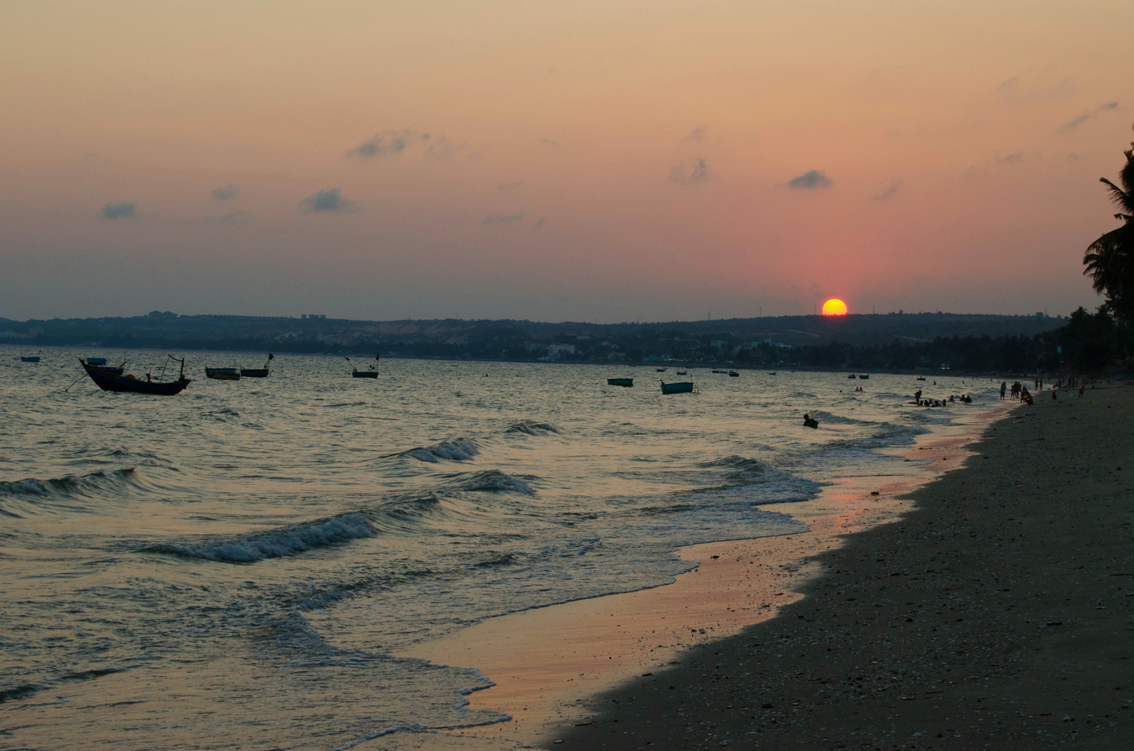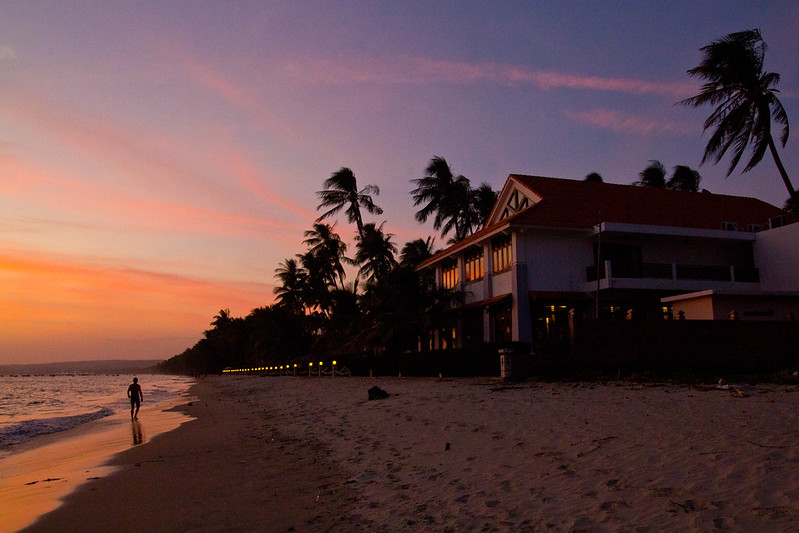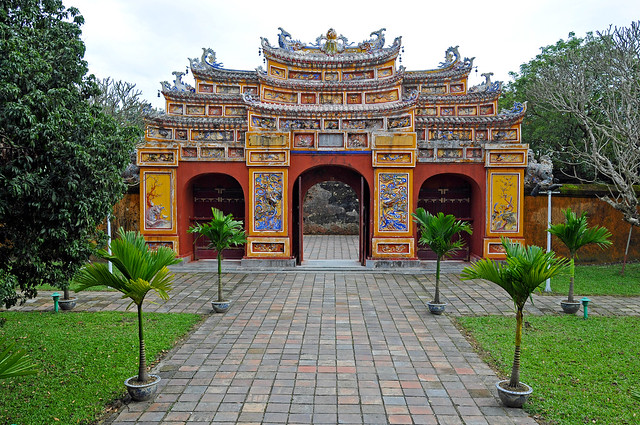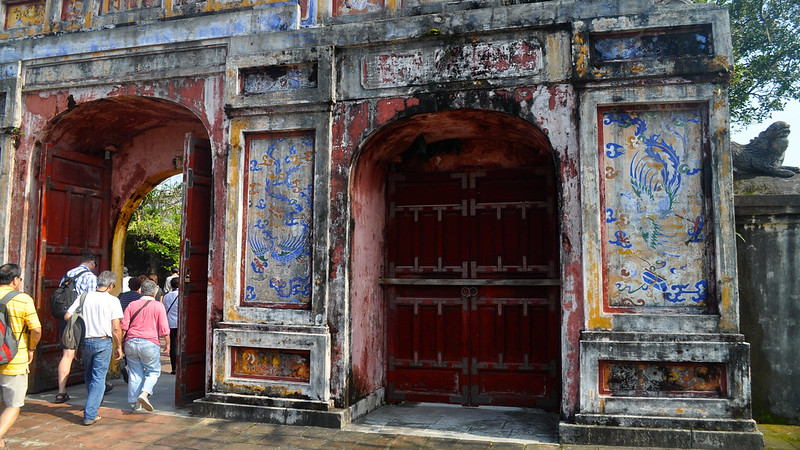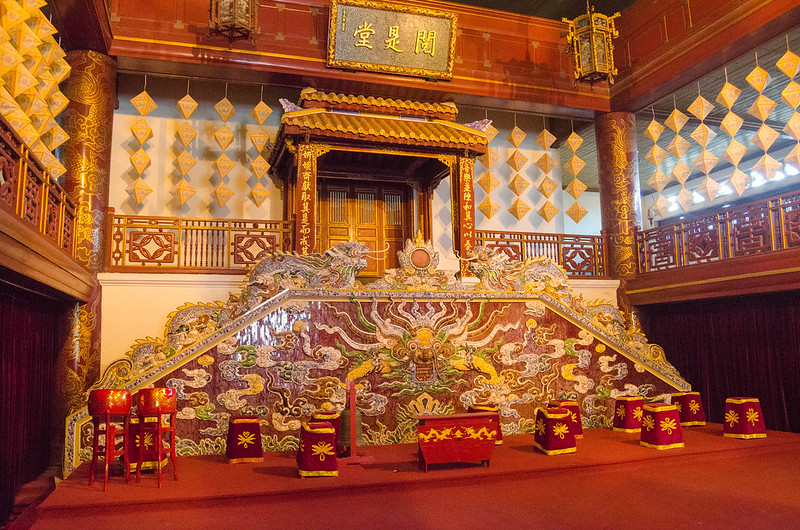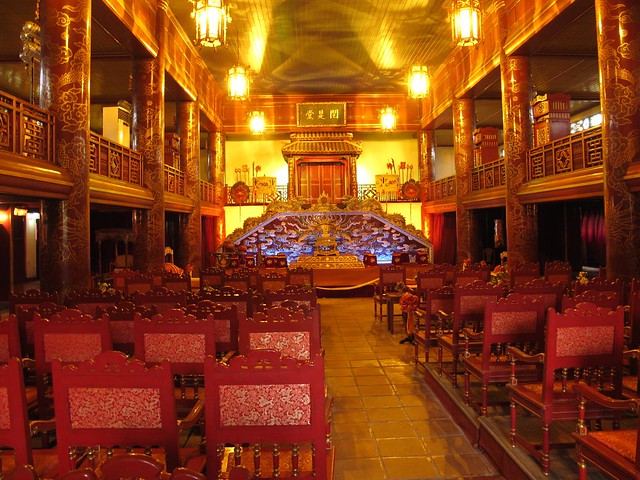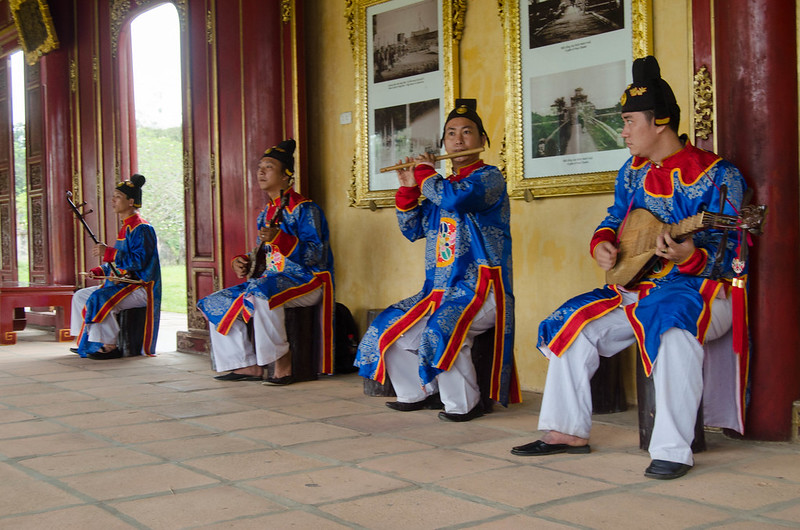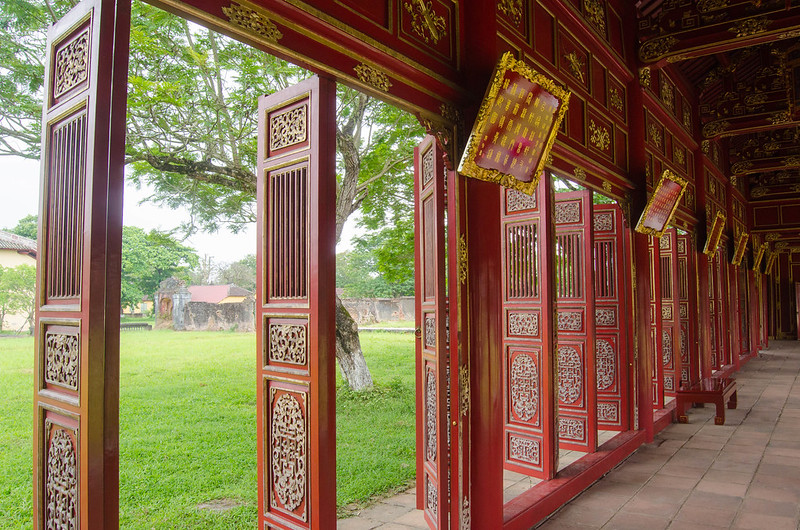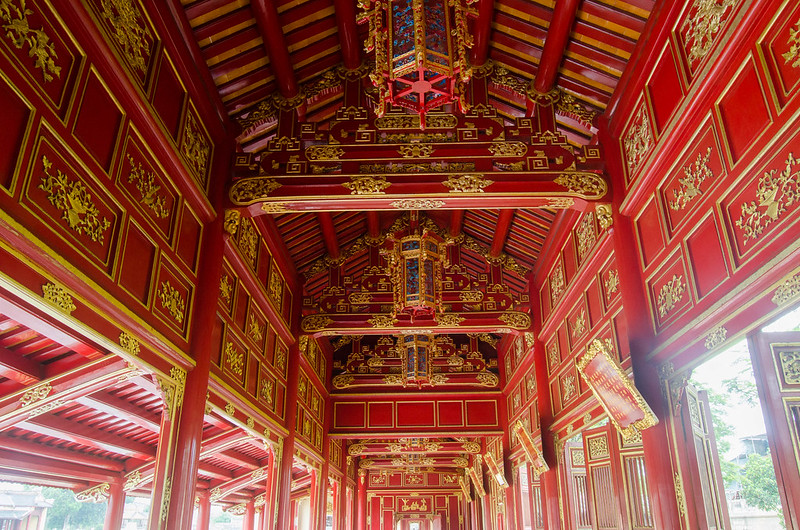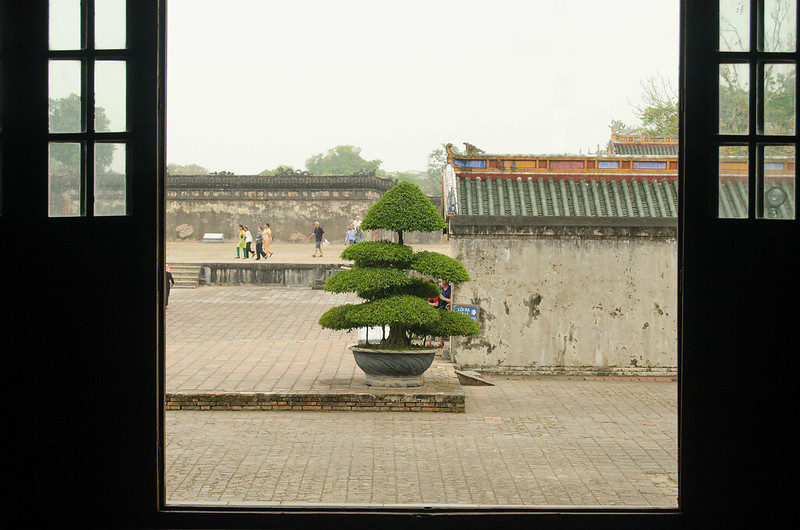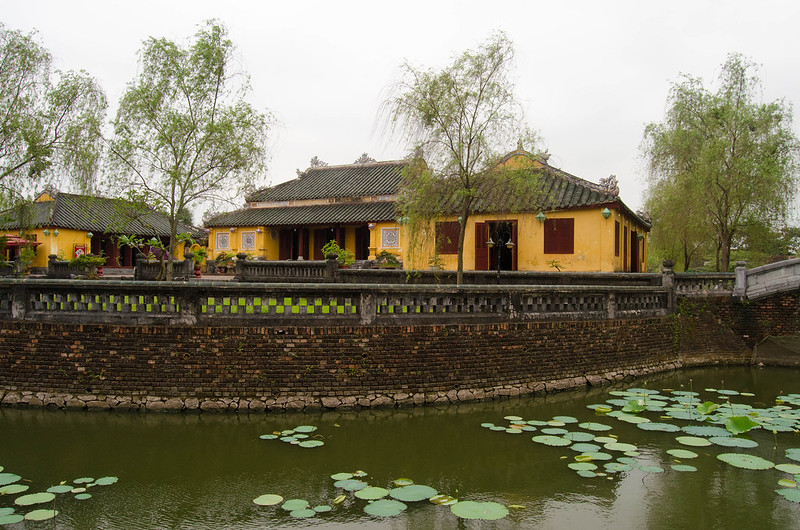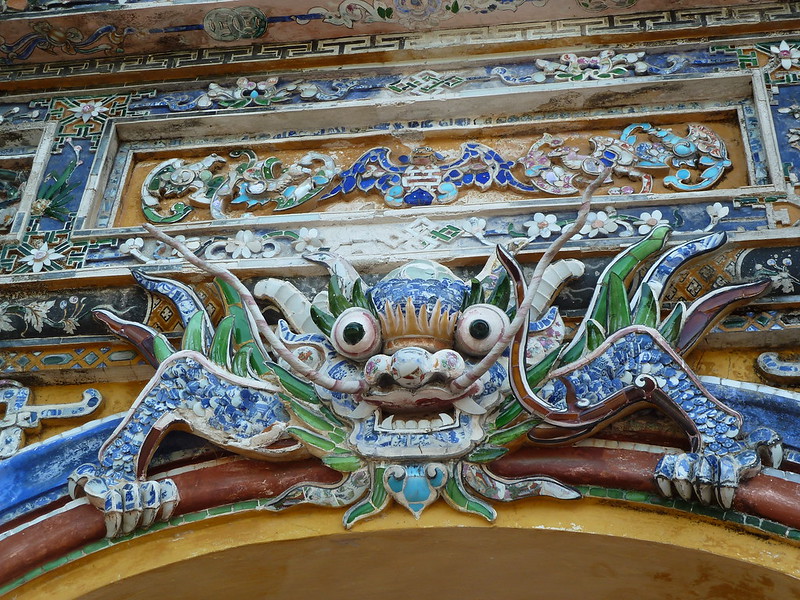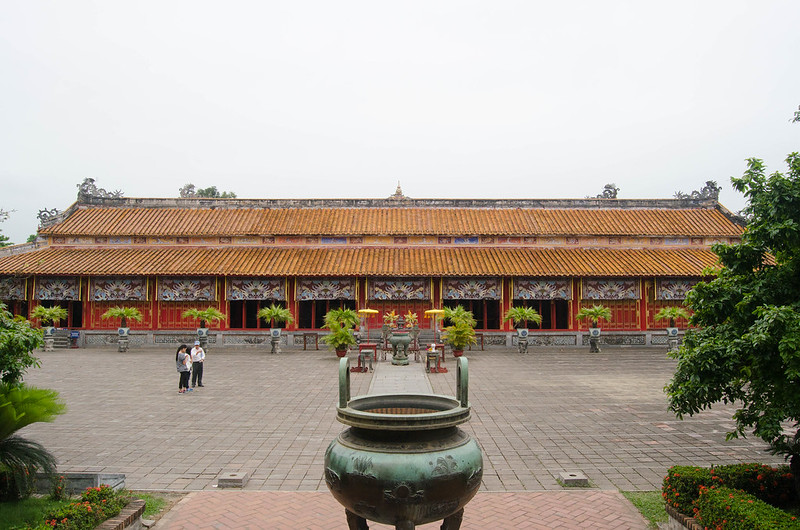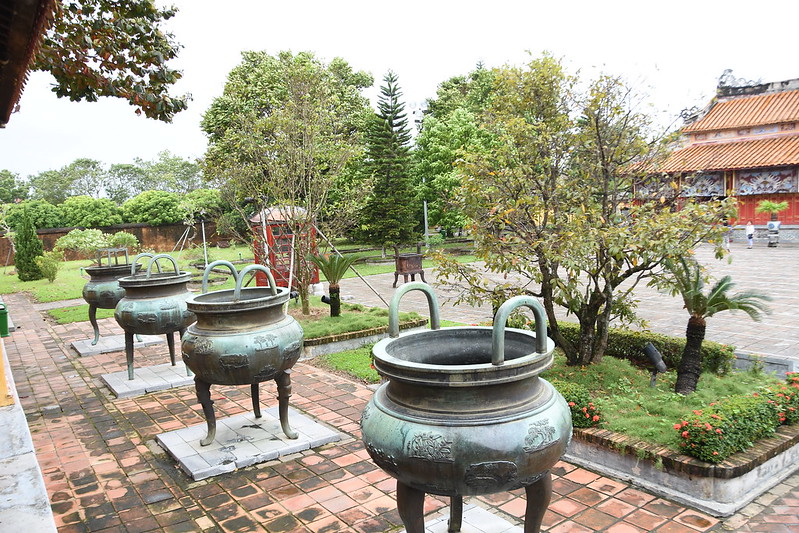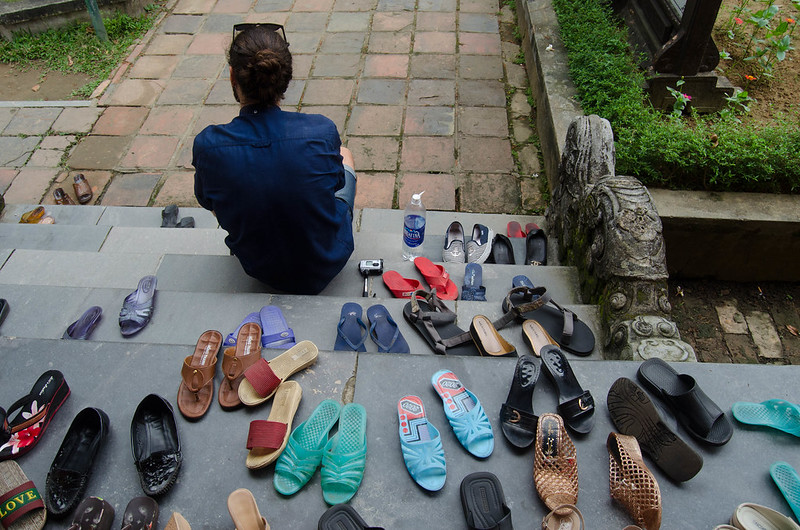Crossing Vietnam - Laos borders overland
Laos Visa on Arrival (2023 update)
According to feedback from some fellow travelers in 2023, it has not been possible to get a Visa on Arrival at the Laos border. We therefore advise you to apply for a Visa at the Lao embassy in Hanoi.
___________________________
Crossing a border by land is always a tedious affair. And yes, we know that airplanes can ease and shorten the entire process, but the money you save on plane tickets makes up for the time spent inside of a bus.
However, previous experiences like the one we had in Poipet, made the subsequent land border crossings stressful for us. And this time was no different.
Land borders Vietnam – Laos (on a Map)
If you want to know how to get from Vietnam to Laos overland, there are 6 different land border checkpoints (check the map below):
• Ngoc Hoi
• Lao Bao
• Cau Treo
• Nam Khan
• Nam Xoi
• Tay Trang.
But if you plan to cross the border by bus, most agencies only use the following 4:
• Lao Bao
• Tay Trang
• Nam Khan
• Cau Treo
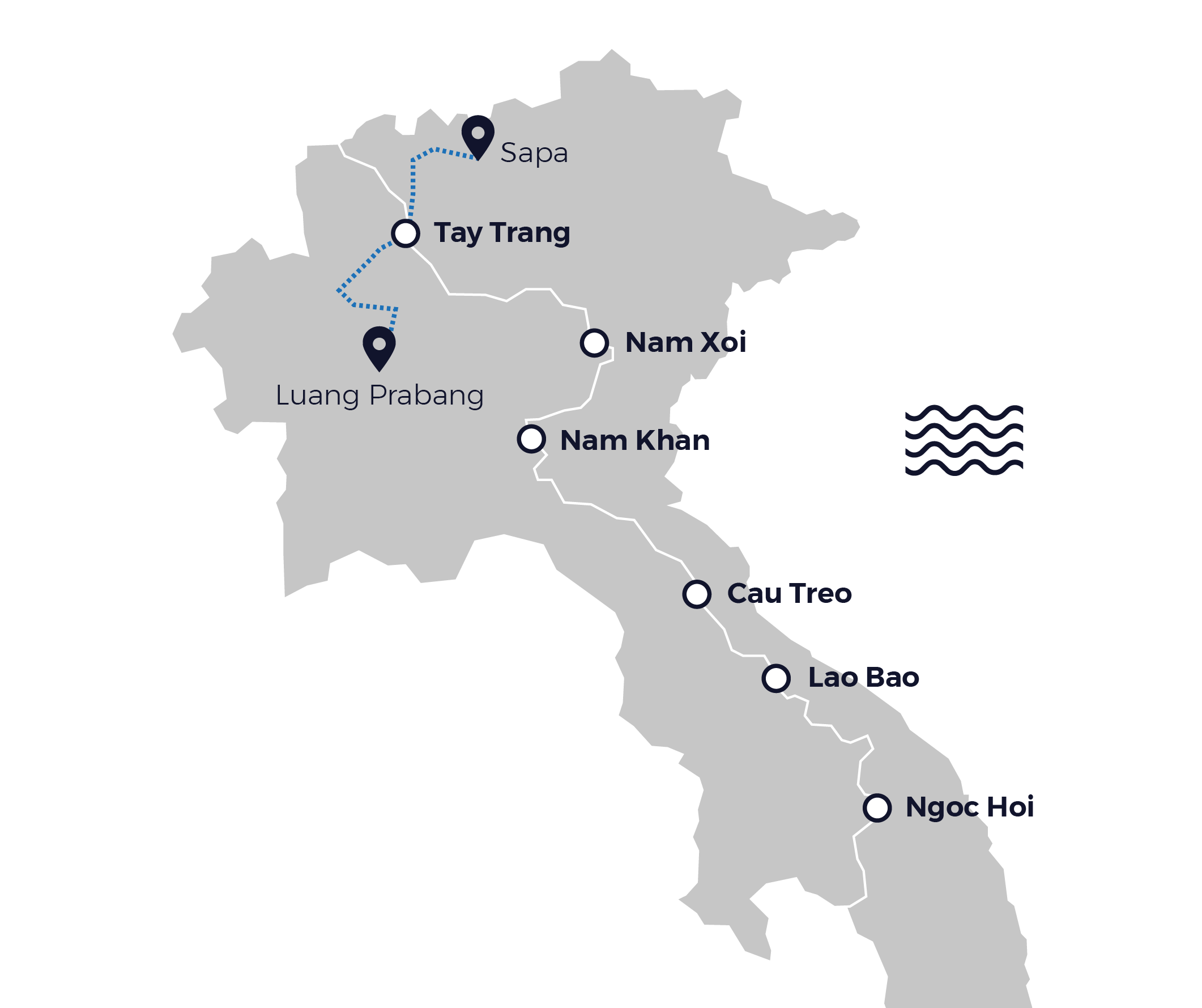
As we were in Sapa (Vietnam) heading to Luang Prabang (Laos), we crossed the Tay Trang border.
When we found out that the bus trip would take 18-hours to make, we decided to split it into two parts. First part: from Sapa to the Vietnamese border city of Dien Bien Phu where we would spend the night. The second part: from Dien Bien Phu to Luang Prabang, Laos.
Sapa to Dien Bien Phu
We bought our tickets for the morning bus to Dien Bien Phu at the bakery Baguette & Chocolat in Sapa for €11,40.
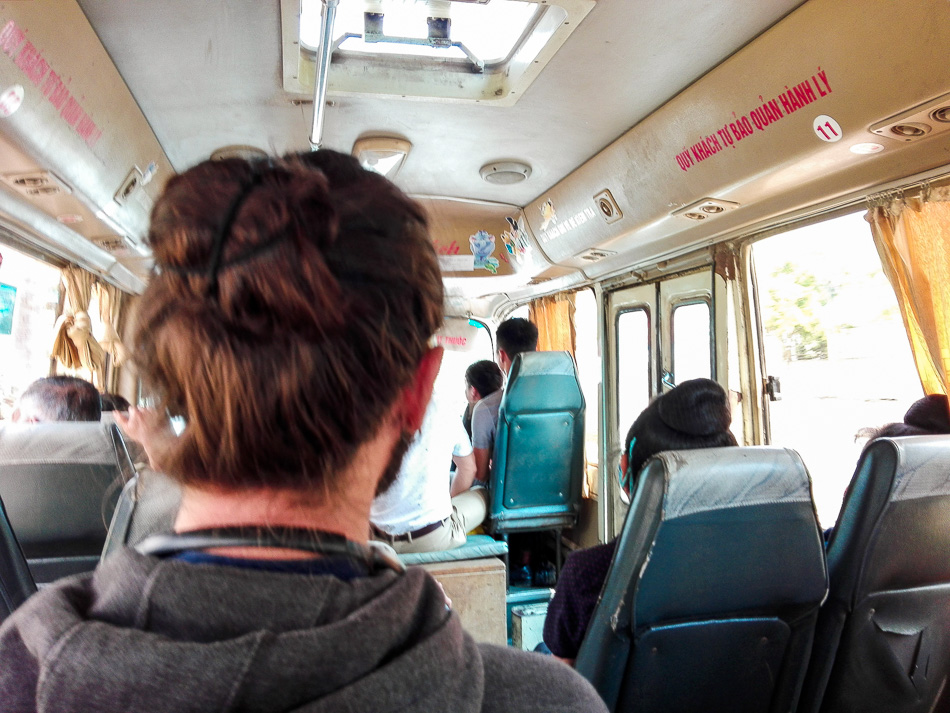
The 8-hour trip was rough. People kept opening the windows to vomit and to spit, so keeping down the banh mi we ate for breakfast was a struggle.
It was like watching this scene from Titanic for 8 hours.
We arrived at Dien Bien Phu bus station late in the afternoon and immediately bought tickets for the next day’s trip: €20,15 each. However, If you prefer to buy your ticket to Luang Prabang online, we recommend www.bookaway.com. Use the code “gravy5″ at checkout to get 5% off the ticket price.
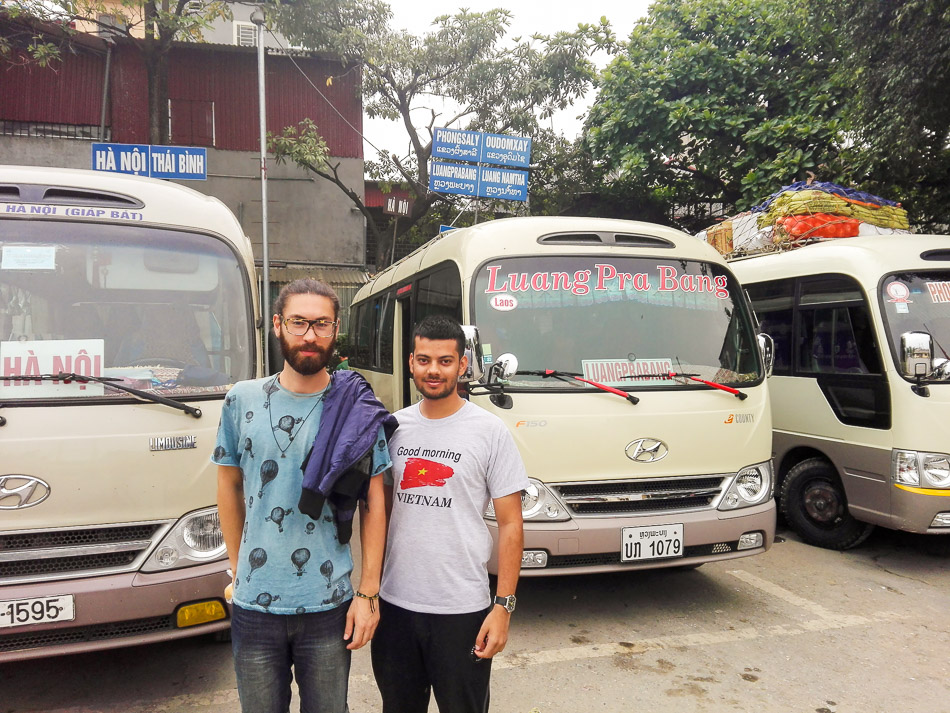
Mário and Avinash (a friend we met on the bus) at Dien Bien Phu bus station.
Border accommodation in Dien Bien Phu
We spent the night at the cheapest (and decent) hotel we found in the area: Huyen Anh Hotel.
Due to our level of exhaustion, we hardly explored the city. Just dragged ourselves through a few streets in search of a supermarket to buy provisions for the next day’s bus trip.
For dinner, we ate at the hotel restaurant. Great portions, really cheap, and surprisingly tasty!

The Vietnamese Border
At 7:30 a.m. on the next day, we set out for Laos in a mini-bus with no leg space. Two hours later we arrived at the Vietnamese border building, grabbed our backpacks, and headed inside.
The queue was long and barely moving as only one guard was doing the checks outs. A rumor spread that he was asking for “farewell donations” from tourists in front of the queue— fortunately, that didn’t happen to us.
The Laos Border
After an exit stamp on the passports and a short mini-bus ride in no one’s land, we reached the Laos border checkpoint.
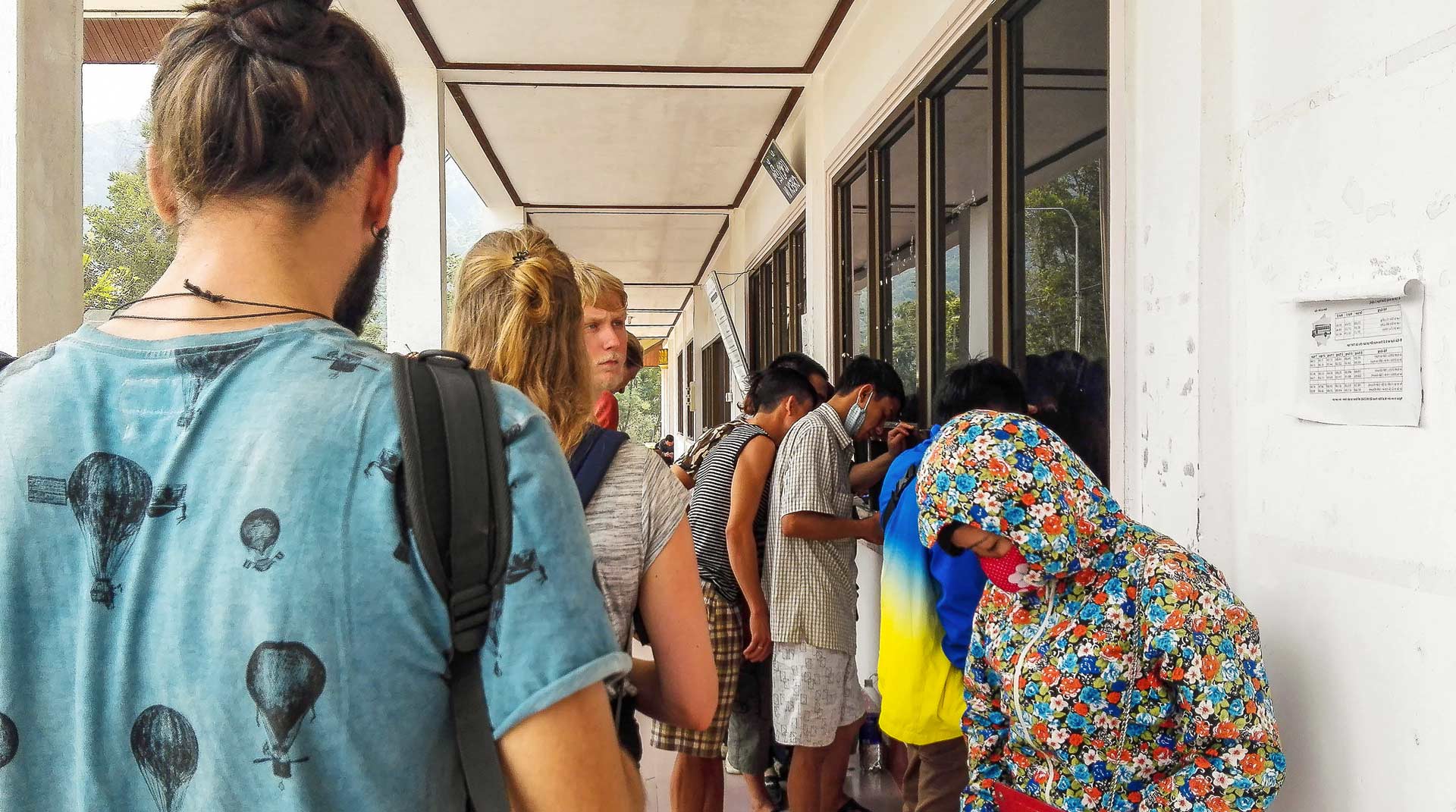
A guard behind the first window gave us some papers to fill with our personal info and the answers to questions like ‘Why are you visiting Laos?’ or ‘Where are you staying?’. Minutes later we handed him the completed papers, our passports, and the €32,5 for the visa fee.
From the fourth window, another guard called our names and asked us for a dollar.
– What for? We just paid for the visa back there.
– It’s a processing fee, sir.
Reluctantly, we paid. But as we reached for the passports, he told us to wait. Another guard called us from the 2nd window and we were asked to pay 2 more dollars.
– Why?…
– Because today is Saturday. It’s a weekend fee.
A group of Canadians also crossing the border were called from the third window, charged an additional made-up fee, and coerced to take new photos for their visas, as the ones they brought wouldn’t do — this service was 5 dollars.
Oh, there was also a fee for sanitary control and infections: a further $1.
Laos Visa on Arrival cost
Remember to check Laos document requirements regarding the entry of international tourists in advance. As far as we know, in Vietnam tourists from all nationalities can get a visa on arrival to Laos — provided they have a legal passport (duh!), a visa-size photo, and the money for the processing fees listed below (2023):
Affghanistan: $40
America: $35
Austria: $40
Bangladesh: $40
Belgium: $35
Canada: $42
China: $20
Denmark: $40
England: $35
Finland: $40
Greece: $40
India: $40
Italy: $40
Ireland: $40
Nepal: $40
Norway: $40
Nederlands: $40
Pakistan: $40
Portugal: $40
Sri Lanka: $40
Spain: $40
Switzerland: $40
Sweden: $40
Turkey: $35
Vietnam: $20
For more information on Visas on Arrival for Laos go to www.laos-guide-999.com/laos-visa-on-arrival
Keep in mind that the same doesn’t apply the other way round. To enter Vietnam from Laos, you’ll need a Visa in advance.
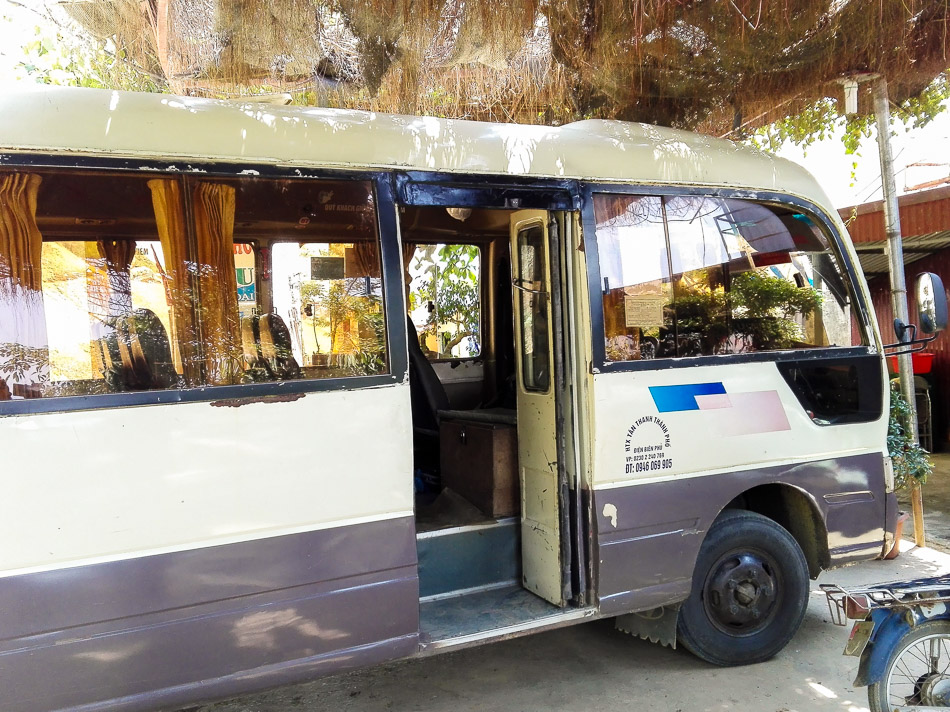
Border crossing expenses
Bus ticket Sapa >DienBienPhu: €11,40
Bus ticket DienBienPhu > Luang Prabang: €20,15
Accommodation at the Huyen Anh Hotel: €3.96
Laos Visa: €32,5
Extra fees: who knows. ¯\_(ツ)_/¯
To prepare yourself for the border crossings to come, read the post 9 Tips & tricks for a smooth border crossing. It’ll help!
If you have any questions or some extra info on the Vietnam-Laos borders, please leave it in the comments below.
Cu Chi Tunnels by Public Bus
Are you planning to visit the Cu Chi Tunnels in Vietnam during your stay in Ho Chi Minh City?
If so, you can do it in 2 ways: paying for a group tour, or spending a fraction of the money buying a bus ticket and doing it on your own. This post is all about the latest.
Which Cu Chi Tunnels to Visit (Ben Duoc vs Ben Dinh)
Most guided tours around Ho Chi Minh City drive tourists to Ben Dinh. The Ben Dinh tunnels are the ones that were reconstructed and widened by the Vietnamese government so tourists could fit in there.
On the other hand, the tunnels in Ben Duoc are a part of the authentic Cu Chi network of tunnels used during the war, and only a few of the tunnels were widened for tourism. Plus, you can get there fairly quickly by public bus, so you should visit the ones in Ben Duoc.
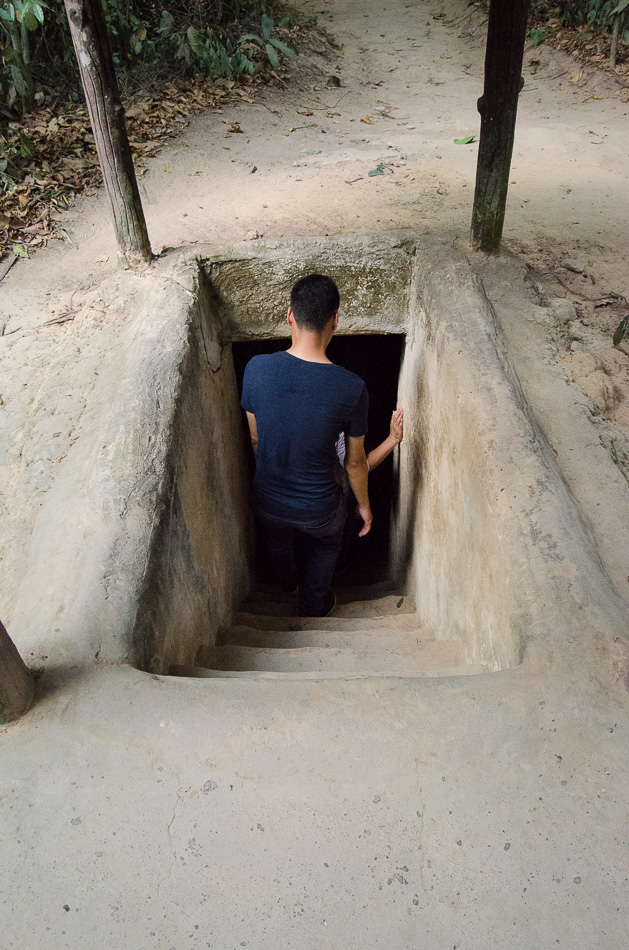
Public Bus to the Cu Chi Tunnels
The bus trip from Ho Chi Minh City to the Ben Duoc Cu Chi Tunnels will take around 2h20.
Go to the Ho Chi Minh Bus Station at the western end of Backpacker Street (Pham Ngu Lao) in District 1. Hop on Bus Nº13 to Cu Chi Station (buses leave every 30 minutes, more or less).
The tickets are purchased inside the bus and cost 20.000 VND / €0.78 / $0.84 USD per person. This is the first part of the trip and it’ll take 1h30.
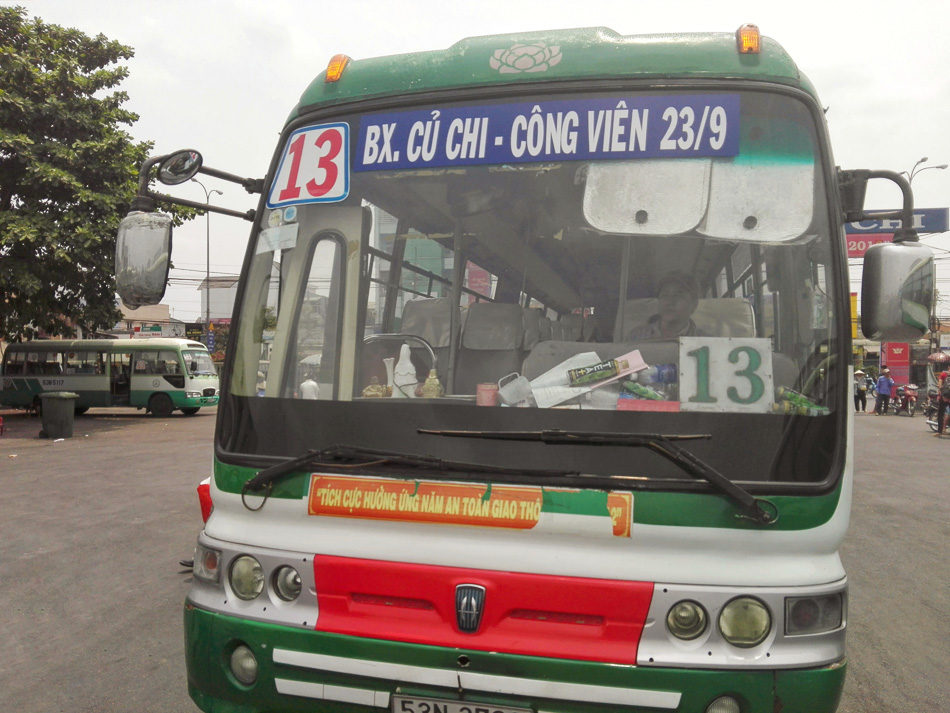
When you reach the Cu Chi Station — and if you want to keep saving money — you’ll have to swerve around the horde of taxi drivers offering their services to the tourists that got off the bus. They’ll say there are no more buses onwards and taking a taxi is the only alternative. That’s not true.
Smile, and look around for Bus Nº79.
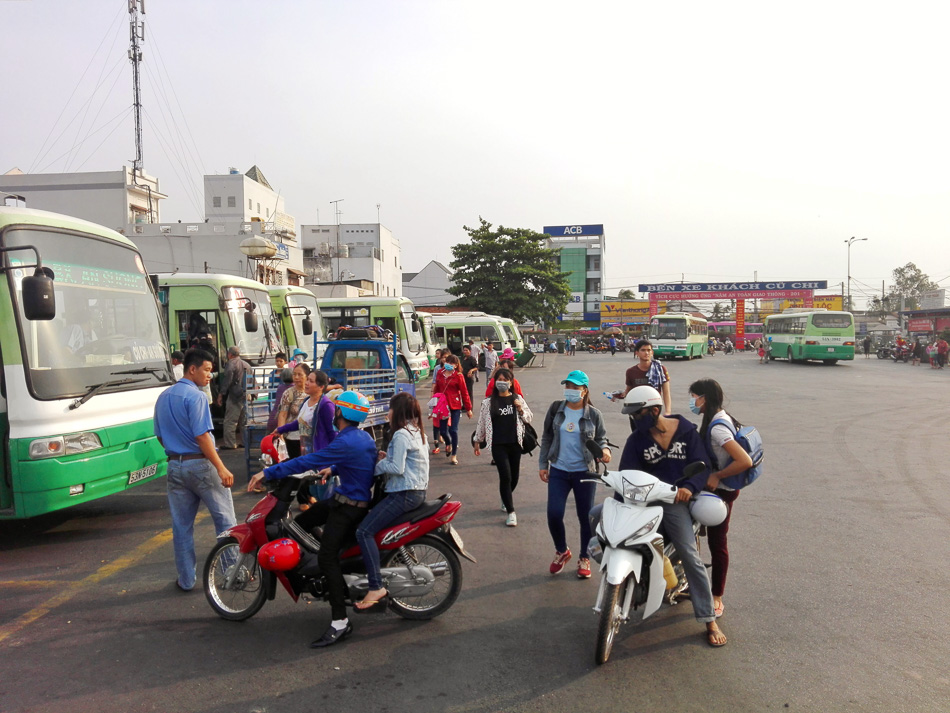
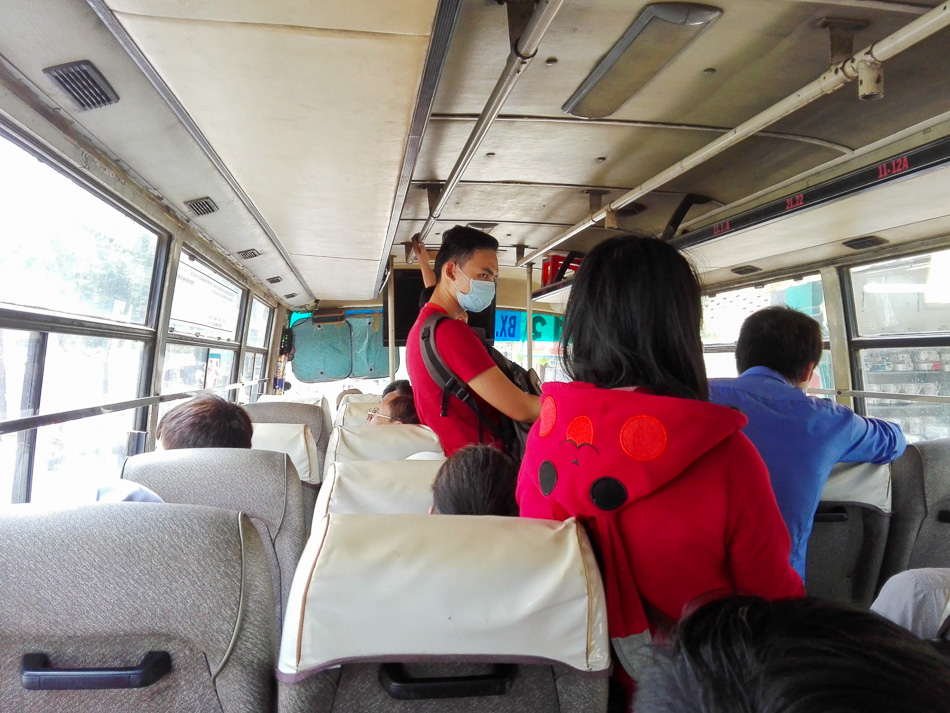
Hop on Bus Nº79 and buy the ticket to Ben Duoc from the ticket agent. This ticket will be a further 7.000 VND / €0.27 / $0.30 USD and the trip will take around 40 minutes. We asked the ticket agent to let us know where we needed to get off and he did.
Nonetheless, after 40 minutes you’ll reach an intersection with two blue traffic signs pointing to Ben Duoc (left) and Ben Dinh (right). The bus will turn left and ten minutes later (around 3kms) you’ll have to hop off. Here’s the spot:
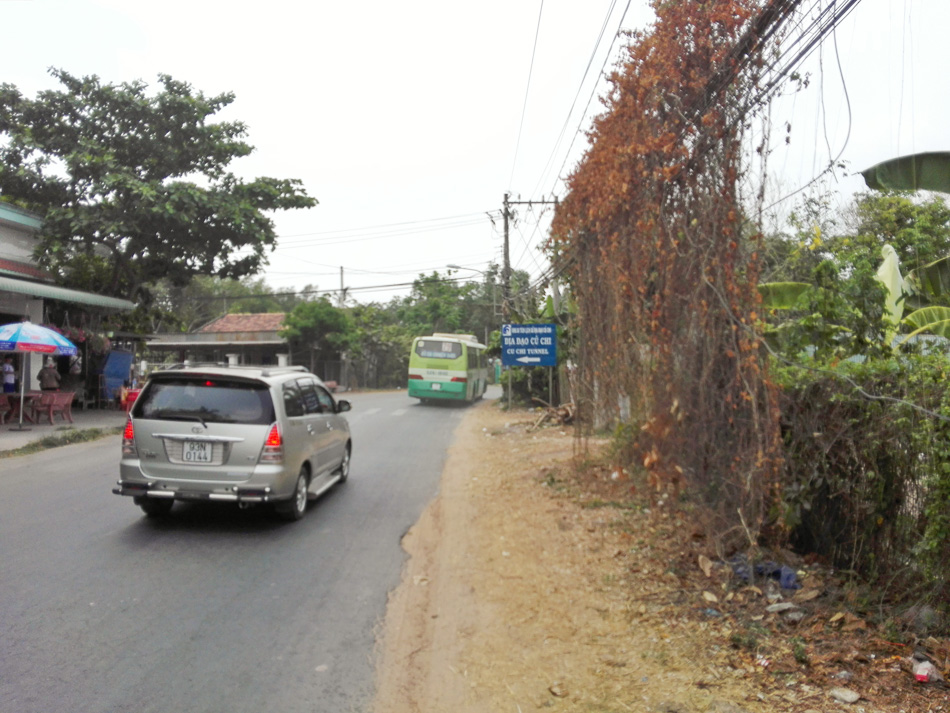
After hopping off, cross the road, walk 0.5 km to the ticket booth, and then another 0.5 km walk to the ticket checking.
If you have any doubts, ask a local! They’re super friendly and know that if you’re on Bus Nº79, you plan to visit the Ben Duoc tunnels. As we mentioned before, only group tours go to Ben Dinh.
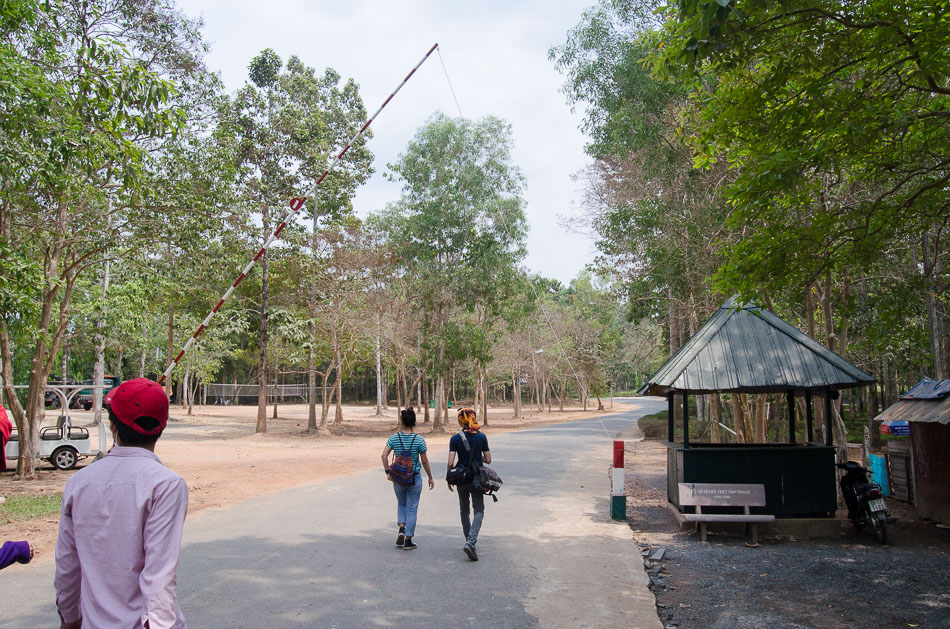
Visiting the Cu Chi Tunnels
Cu Chi tunnels entrance fee: 125.000 VND / €4.95 / 5.30 USD
Tickets will include an English-speaking guide.
After buying the tickets we were directed to a wooden gazebo to watch a short video on the Vietnam War and the key role the tunnels had during war operations.
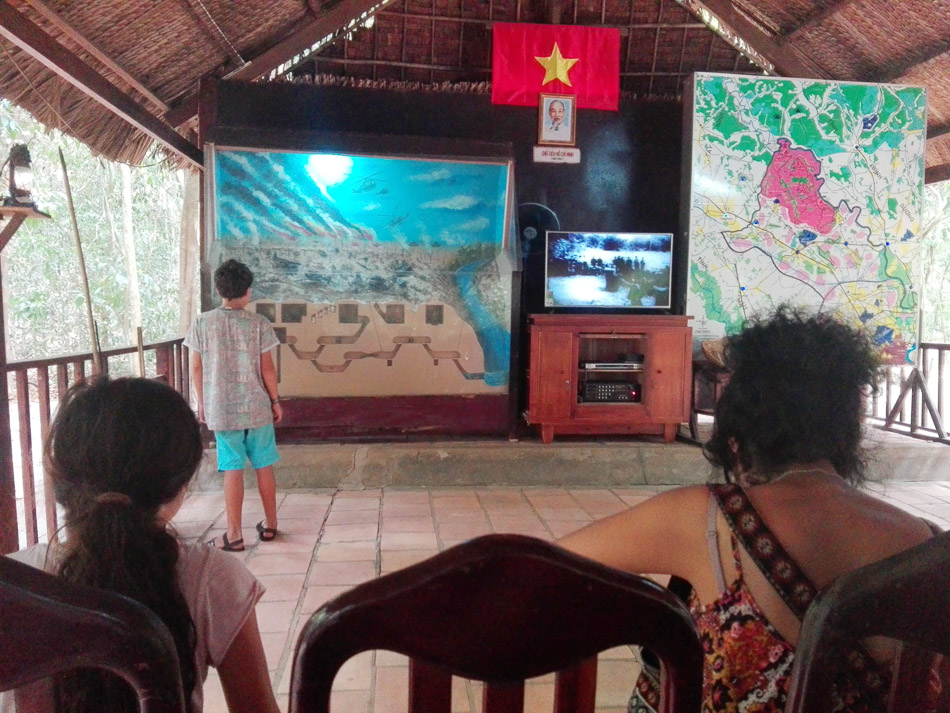
Our guide for the day introduced himself and explained how the tunnels were dug and the underground living conditions the Viet Cong troops had to endure for months.
More aware of what we were about to see, the guide took us on a little journey through the forest, showing us:
- Bomb craters
- Booby traps
- Missiles
- Tunnel ventilation systems are scattered in between trees.
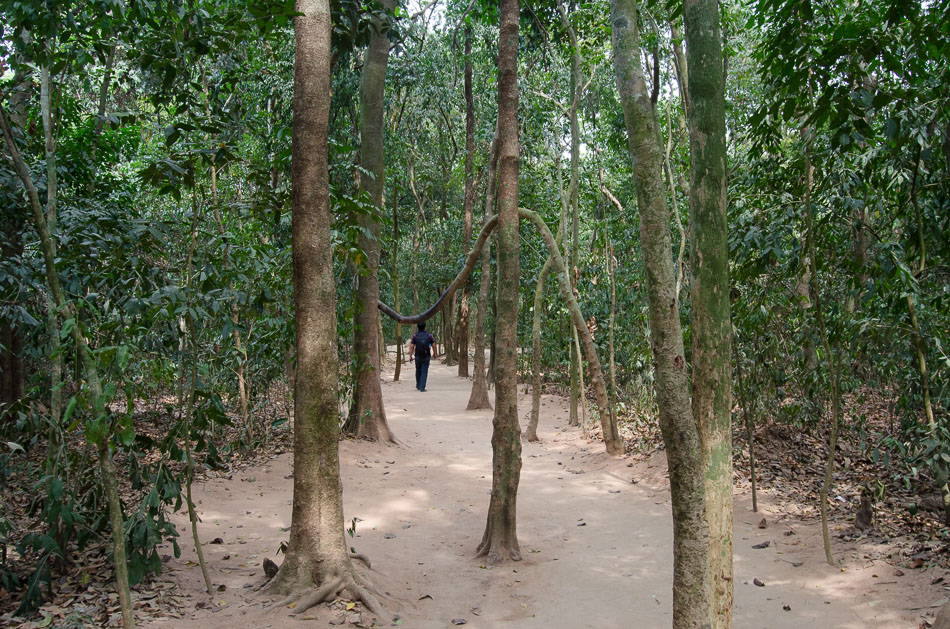
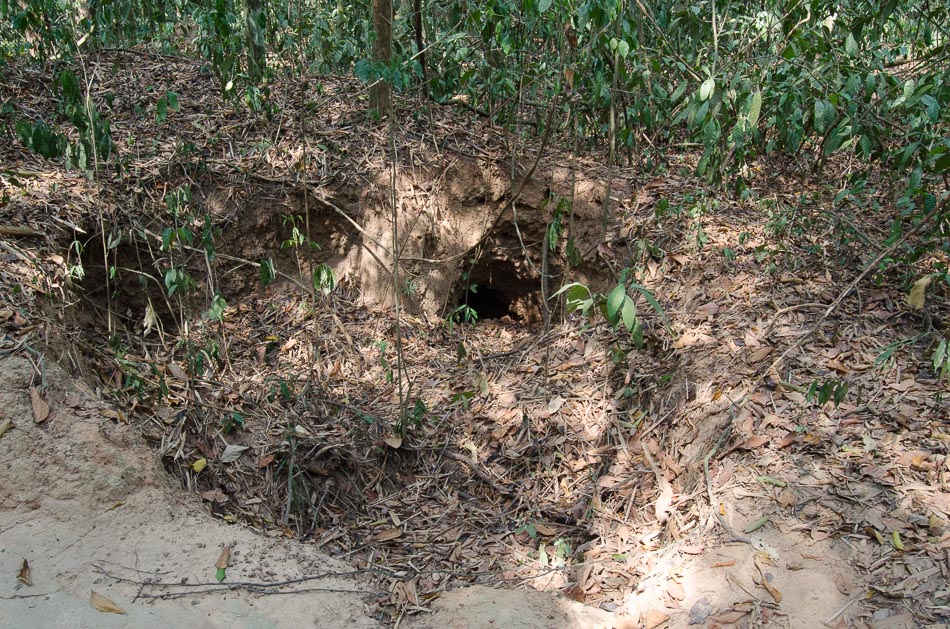
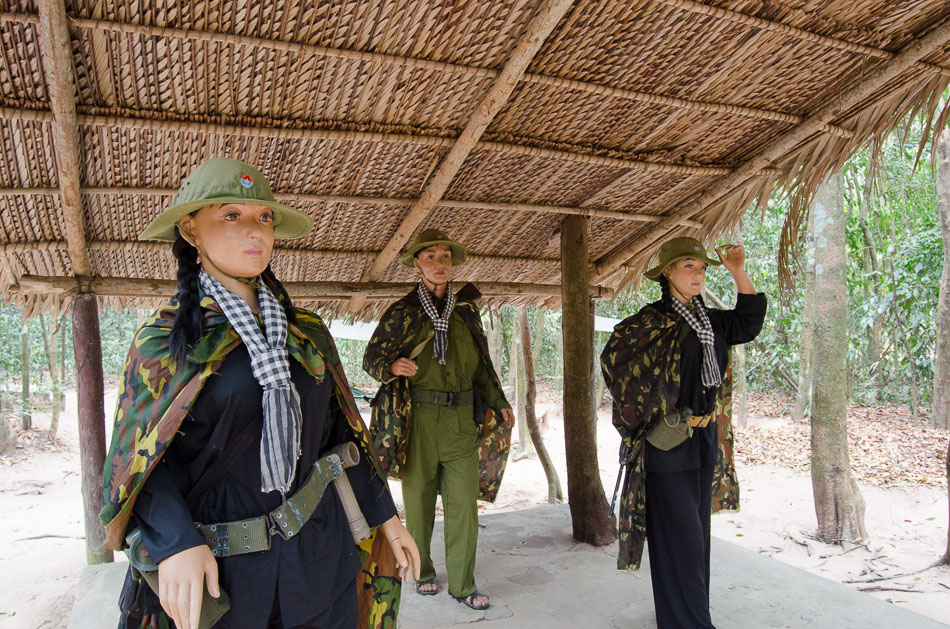
We were all invited to crawl inside sections of the tunnels and it was nerve-racking (especially for two tall guys like Nuno and me).
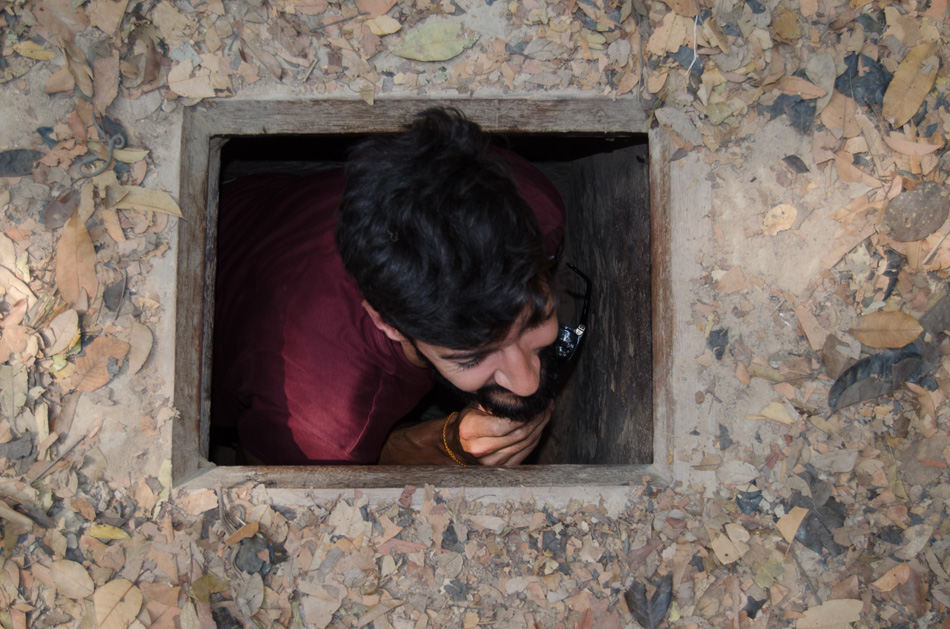
Inside the tunnels, the air was thin and hot. The lights were dim and fruit bats kept flying through people’s hair. If you’re claustrophobic or anxiety-prone, don’t even.
Here’s a short video we made that day:
Afterward, we were called to taste what Vietnamese soldiers ate back then: boiled manioc dipped in salt, sugar, and crushed peanuts.
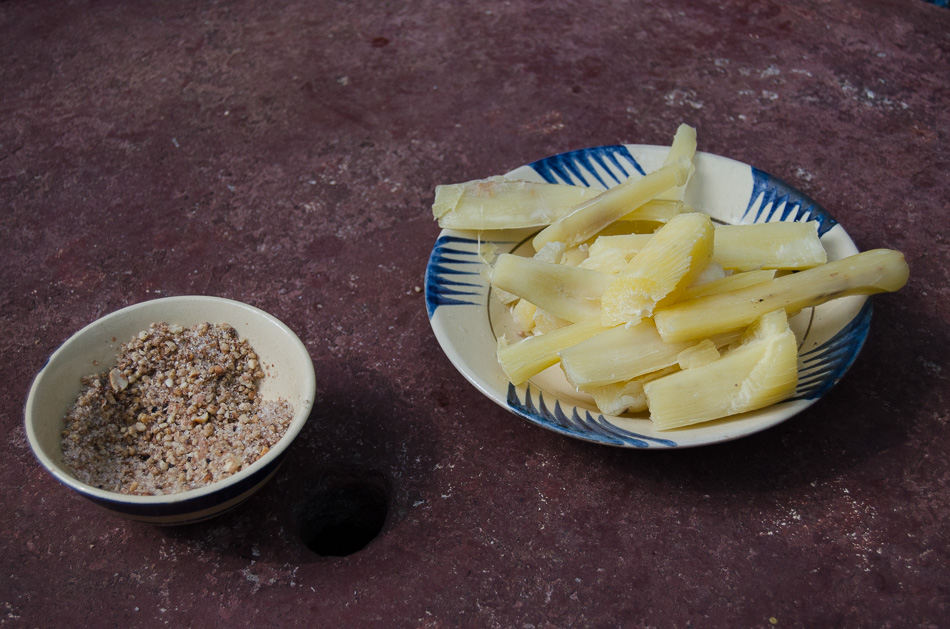
If you’re willing to pay some extra you can fire an AK-47 rifle on a shooting range. In our case, we decided to visit the buildings and gardens around the memorial park. It was nice to see that a battlefield where so many people were killed, now grows beautiful orchids as a form of tribute.
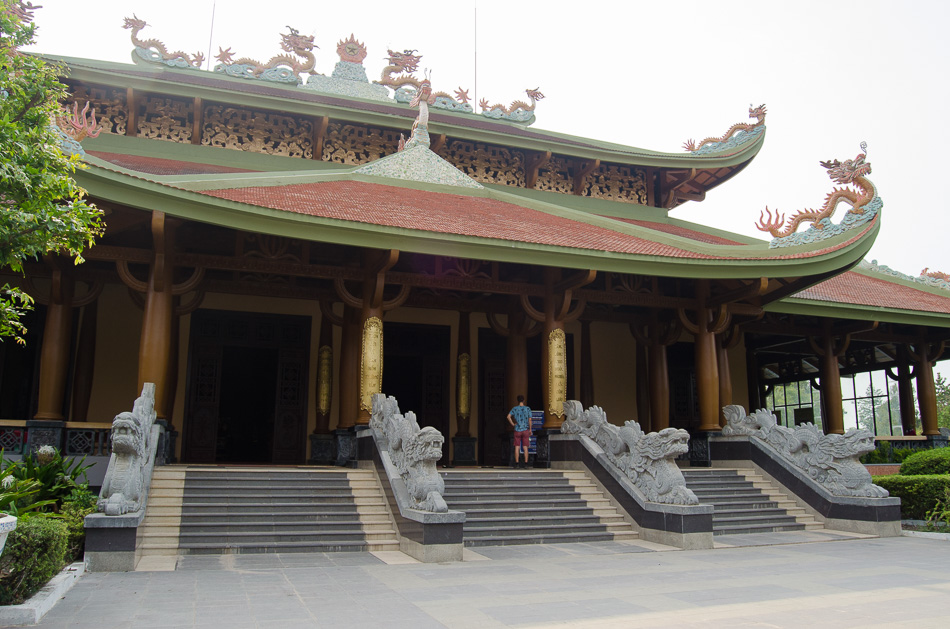
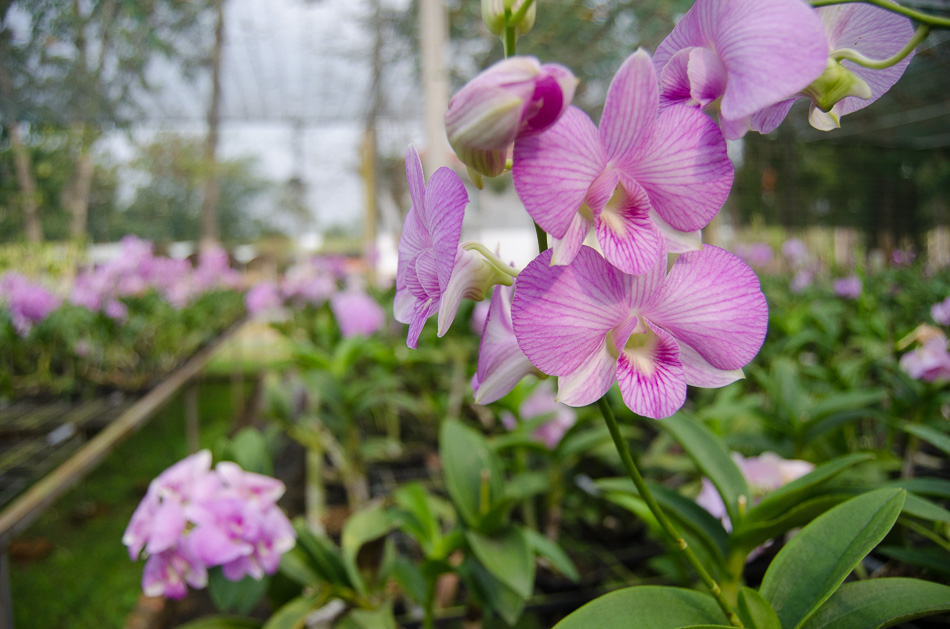
Why were the Cu Chi Tunnels Built?
They’re an underground tunnel system dug by the Vietnamese during the fight for independence against French colonists, then used and developed to fight Americans during the Vietnam War (or American War as the Vietnamese call it). At its pinnacle, the tunnels became a complex anthill with several floors deep, hospitals, living quarters, and communication routes that stretched for more than 250 kilometers long.
Nowadays they’re a reminder of Vietnam’s underground warfare, the determination of its people, and a famous tourist attraction.
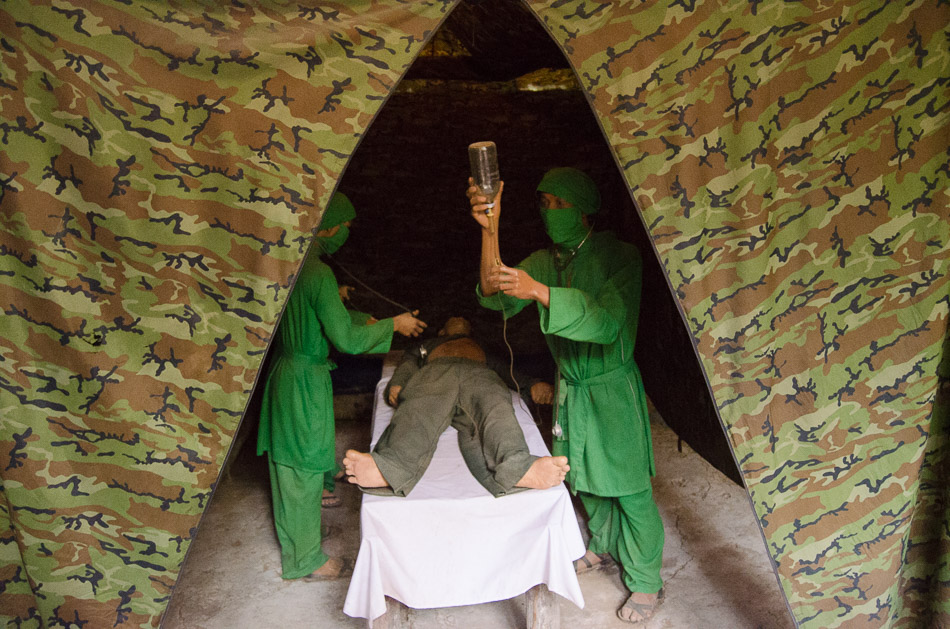
Returning to Ho Chi Minh City
Now that you know how to get to the Cu Chi tunnels by bus, you’ll also need to know how to head back from Ben Duoc to Ho Chi Minh City.
First, have in mind that the last Nº79 bus of the day to HCMC is at 5:30 PM. After that, you’re on your own!
Catch it on the same road you hopped off. Then, at the Cu Chi Station get on the Nº13 all the way back to District 1.
Looking for things to do in HCMC? Check out the post Waking Up in Ho Chi Minh City.
It’s important to mention that the bus rides to and from Ben Duoc were really enjoyable! Experiencing public transports in Vietnam is something you shouldn’t miss, it will make you feel like one of the gang. It’s a great way to chat with locals and meet travelers alike.
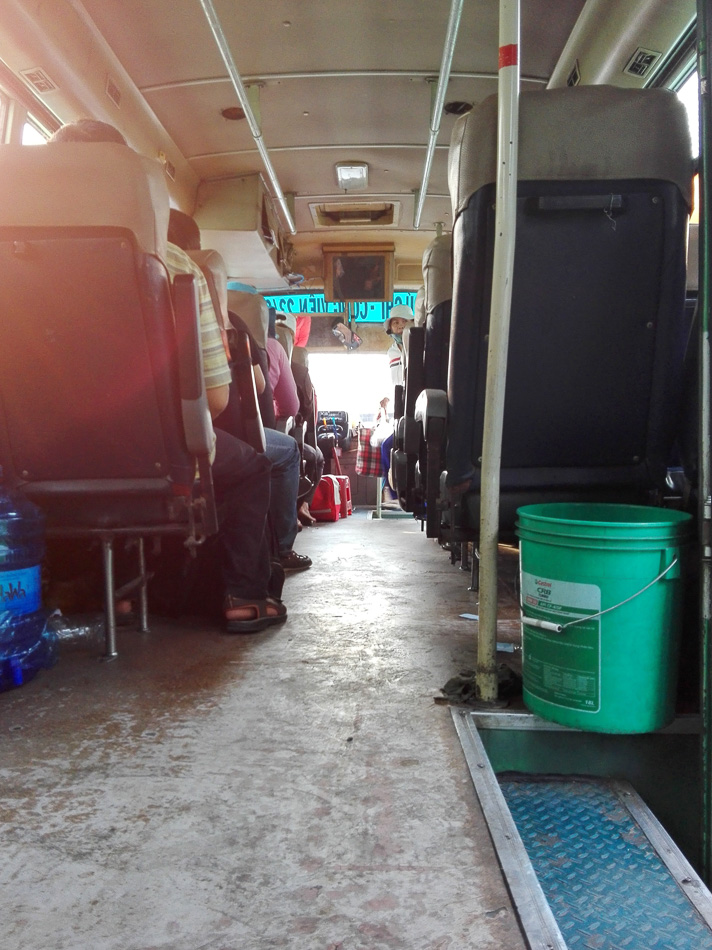
On our way to the Cu Chi Tunnels, we met an Israeli family of 5: mom, dad, and 3 kids with 13, 8, and 4 years old. It was their first time in Vietnam.
The family was traveling for 3 months and the parents were super stoked to be sharing this experience with their kids.
(We’re sharing this to inspire all those parents believing they can’t travel anymore because they have a child. Obviously, travel logistics will be different and WAY more demanding, but it goes to show that it’s possible!)
Why we avoided the Guided Tours
At the reception of our hotel, we saw a bunch of flyers for organized group tours to the Cu Chi Tunnels starting at €6,50 for half a day (entrance fees were not included). Meaning that we would be paying the “tourist fee” for transportation plus getting a time constraint. And even though €6,50 is not that much money, we knew we could do it for at least a third of the money — and actually did it for way less.
If you have any questions or some extra info to share that everybody can benefit from, leave it down in the comments!
Exploring Sapa: a one week travel itinerary
In the high mountains of northern Vietnam—not far from the Chinese border—lies the alluring Sapa region: well-known for its mountainscape, temperate climate, and being home to several Vietnamese ethnic minorities.
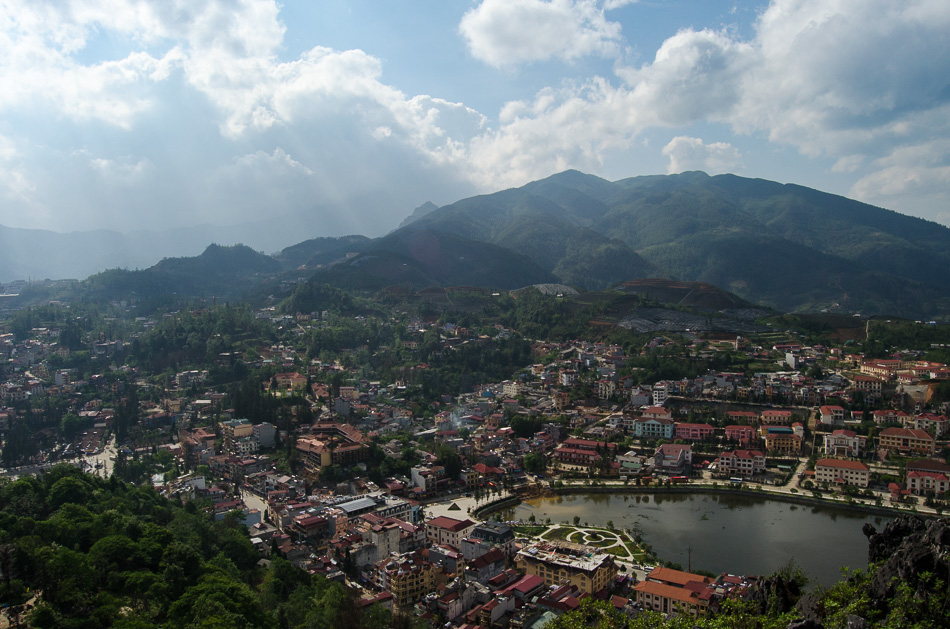
Sapa Weather
We arrived at our hostel feeling a bit antsy from the bus trip. It was too early for bedtime and too late to go out so we went up to the porch, joining a group of other guests eating and playing card games. Suddenly in the distance, a loud thunder rumbled, and in less than 5 minutes a storm was above us. The lightning, heavy rain, and strong winds blew the plates from the tables and the cards from people’s hands, scaring us all to the dorms.
The storms were consistent during the 6 days we stayed in Sapa, greeting us every late afternoon or early evening, and lasting for 30 to 40 minutes at a time. If you’re visiting Sapa between May and September, pack a raincoat.
Just to be sure, check Sapa’s rain forecast here.
Transportation
Our trip from Hanoi to Sapa was on a Queen Bus company bus, it took around 6 hours and cost €9,45. The same trip can take up to 8 hours if done during the night. All buses stop at the New Sapa Bus Station: about a 10-minute walk from the city center.
To buy your ticket online, we recommend going over to www.bookaway.com (use the code “gravy5″ at checkout you’ll get 5% off the ticket price).
For other ways to get to Sapa check here.
Hill-tribe people and Sapa’s daily life
When the bus stopped a large entourage awaited us, only this time the taxi drivers were outnumbered by women dressed in embroidered indigo blue dresses. Right away, these Hmong women started offering themselves as guides for a mountain trek—one of the popular activities to do in Sapa.
You can read all about the Sapa trekking experience here.
Four of them followed us to the city center where more women joined in to sell us handicrafts: “Sir, buy something from me!”. They mobbed us, insisting on buying something or scheduling a mountain trek.
Not being ready to commit there and then on a trekking day, 3 different women gave us their phone numbers on a piece of paper, making us promise we’d call them when we decided to do it: “Pinky promise?”
The central square was packed with hill-tribe women that came from villages around Sapa. The sidewalks were covered with scarves, bracelets, and knick-knacks that they planned to sell to tourists. And because they’ve been doing this for a long time, they tend to be quite sassy at it:
When you say you don’t have any money, they’ll point to the ATM.
If you don’t want to buy anything for yourself they’ll say “Buy for your mother…”
If they see a tourist buying from the competition, they’ll flock over to him and try to sell more of the same.
But even though this constant haggling is annoying, it’s important to understand that Hmong and Dao women are the main earners in their families and depend solely on the money they earn from tourists. Yes, their selling tactics are a bit aggressive, but it can’t be an easy life when everybody else sells the same that you do.
What to do around Sapa
Ham Rong Mountain
Entrance fee: €2.80
Other than the odd Disney and Scooby doo statues scattered throughout, the entire hill is beautifully gardened, and the more you go up the better the view gets.
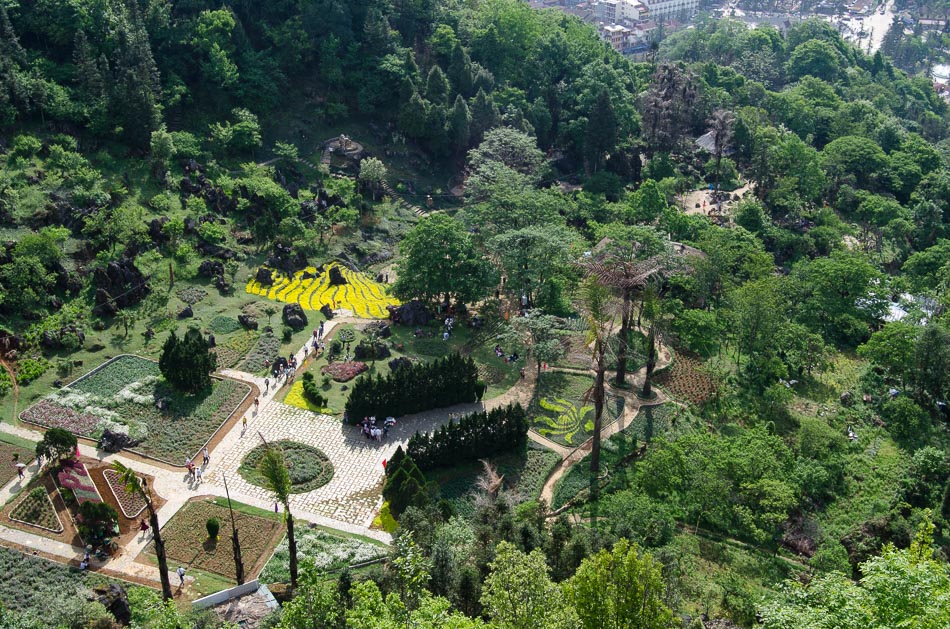
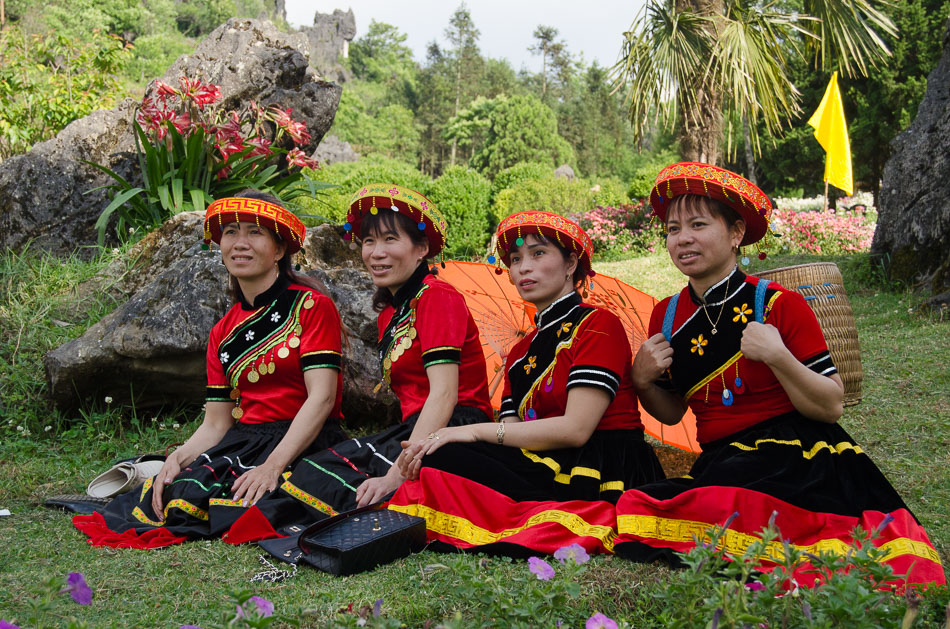
In the center of the park is a venue where you can watch a traditional dance show, however, none of the dancers seemed particularly excited to be there. The show timetable will be printed on the entrance tickets.
At the top—1800m high to be exact—is Sânmây or the cloud yard, where you’ll have a 360º view of the mountains that surround Sapa.
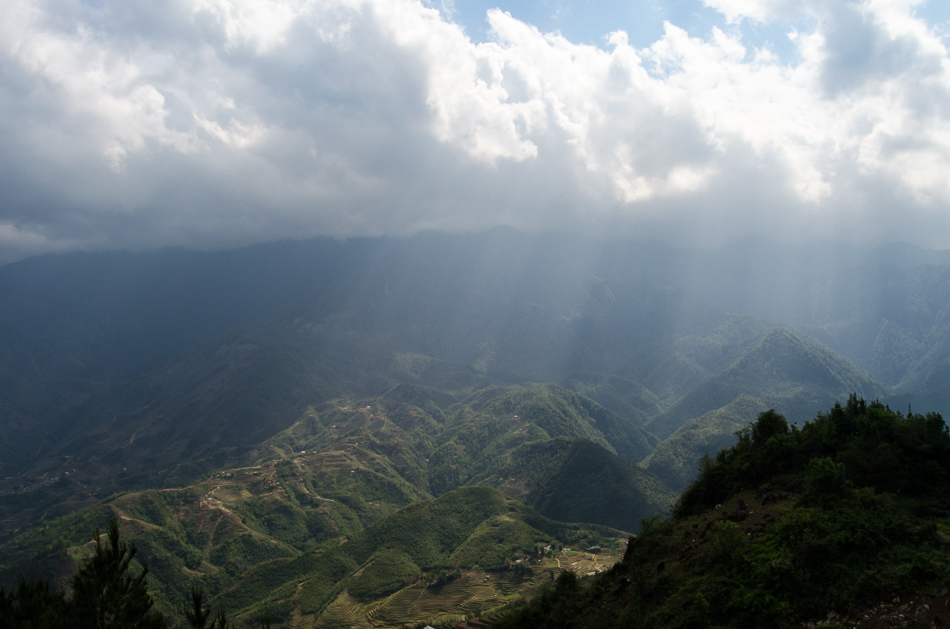
Sapa Culture Museum
Free entrance.
It’s a two-story building right in the city center, showcasing the history of the town and the hill tribes living around Sapa.
It’s a tiny museum desperately needing upkeep with a souvenir shop downstairs.
Sapa Market
It’s a small local market near the new Sapa Bus Station similar to any other Vietnamese market selling fresh produce.
If you tend to get lightheaded at the sight of freshly-killed dogs and horse body parts, avoid the meat section. You’re welcome.
Some stuff just can’t be unseen.
Mountain Trek
This is the most popular activity in Sapa and we wrote all about it here: Easy guide to Sapa mountain trekking.

The Bac Ha Markets
Trying to move around as independently as possible (and knowing beforehand that it could be done), we attempted to outline a trip to the Bac Ha markets by public transport. Finding the correct information turned out to be impossible, so we gave in and booked an organized tour. We paid €10.76 each for an 8-hour tour to the Bac Ha markets, a typical village, and the Lao Cai border.
It took more than 2 hours on a mini-van to get there, arriving almost at noon. By then, the majority of people walking around were tourists, and the few ethnic women that remained were clearly fed up with them and their cameras.
The market was divided into areas of commerce: foods and drinks, textiles, vegetables, meat, and cattle (again, dogs included).
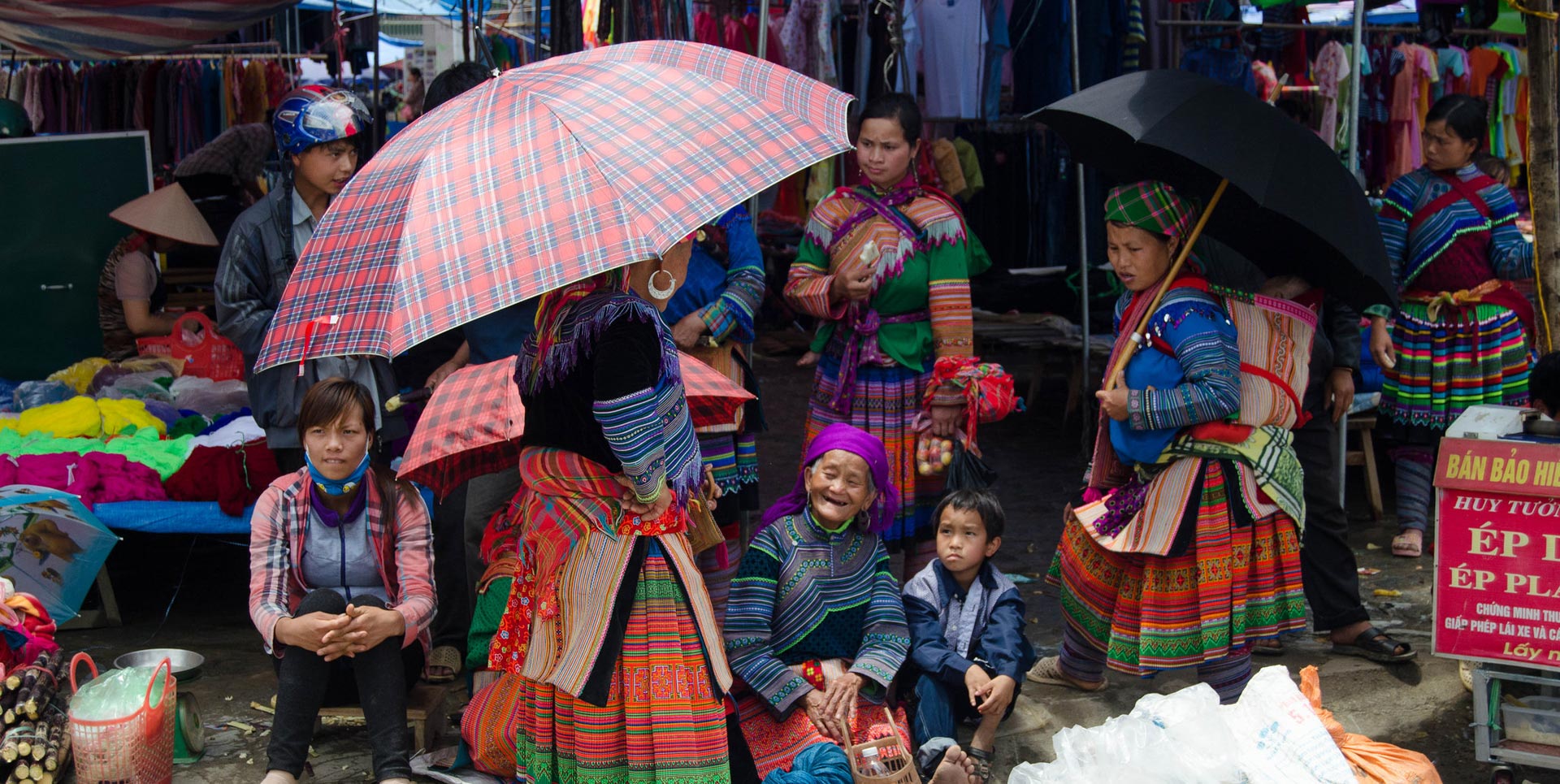
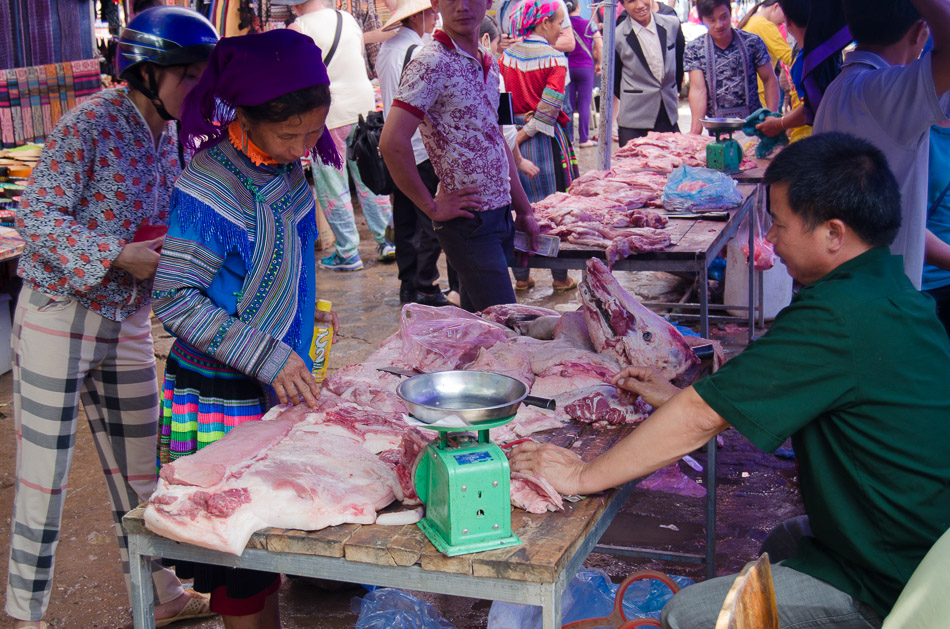
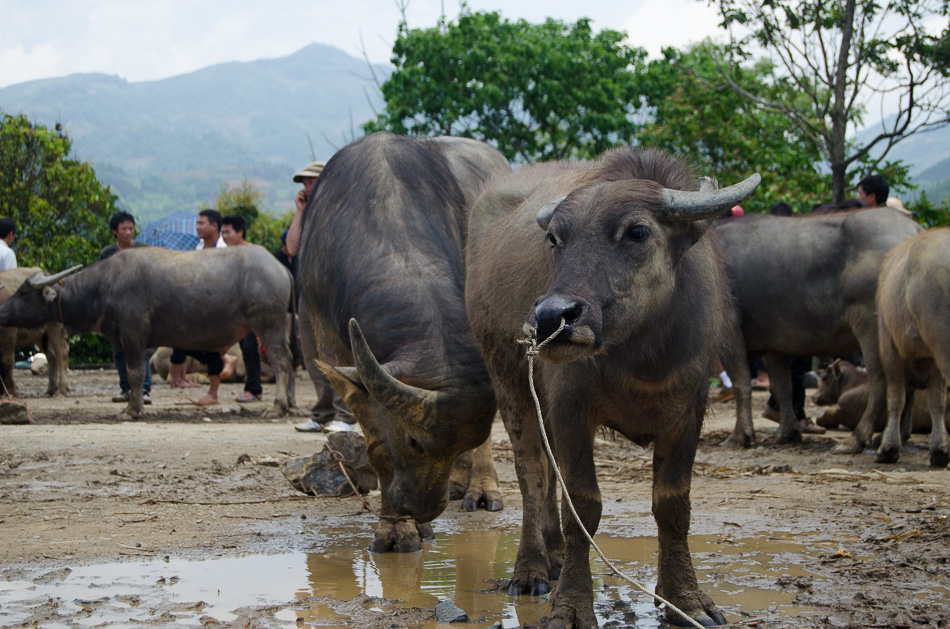
Visiting a typical village
Cat-Cat is the most touristy but the nearest to Sapa. Then there’s Ta Van, Lao Chai, and Ban Pho for a more serene vibe.
Some of these villages require you to purchase a permit in advance at the Tourist Information Center in town—although if you book a trekking tour here (which we don’t recommend) the permit fee is already covered.
By default, this visit should be a part of your trekking experience, so there’s no need to buy separate permits or tours to do it. The Bac Ha market tour that we mentioned before, included a visit to one of these typical ethnic villages, and it was awful. They round up all of us foreigners and bulldozed us into humble tin houses, walking in line and snapping pictures of the people inside as if it was Disneyland. Not cool.

It’s best to do it in a less invasive way and accompanied by someone that actually lives in the village—like your trekking guide. See all that a Sapa trekking experience involves here.
The city center
It looked like a construction site with trucks, dust, gravel, and bricks scattered all over. Hotels, shops, and cafes abound, and you’ll be approached constantly and incessantly by every vendor possible, including children.
Tips for finding Accommodation
We arrived on a Thursday with a one-night reservation at the Go Sapa Hostel—we always book one night first to see how the place is, and if we like it, we extend our stay.
We got stuck in a tiny dorm room with 4 bunk beds, where everybody threw their backpacks and wet towels on the floor. By the next morning, we were out of there. Strangely, all affordable hotels were fully booked for the next 2 nights. It was like every backpacker in Vietnam decided to visit Sapa that weekend.
Resigned to no alternatives, we went back to the Go Sapa Hostel to book one more night: “We’re full. No more rooms”.
Long story short: Sapa is a big weekend destination for Vietnamese people. The prices of hotel rooms triples and availability drops dramatically, so book ahead!
Luckily our desperate-looking faces got us a “room” at the Sapa Ruby Hotel. We slept in the room right by the family altar and where spare furniture was stored. Days later—during the week—we changed to the Sapa Sunflower Hotel: super affordable and with breakfast included.
Food
The banh mi was our food of choice here in Sapa. We ate them for breakfast, lunch, and dinner. They’re delicious, cheap, and can be found in every other food stall around town—each with its own banh mi variation.
Farewell Vietnam!
Sapa was our final stop for 6 days after 1 month of traveling through Vietnam. The calm of the mountains, the fresh air, and the glorious landscapes were the best way to bid farewell to it.
Sapa’s daily expenses (average for 1 person)
Ham Rong mountain entrance fee: €2,80
Bus ticket Hanoi > Sapa: €9.45
BacHa Markets Tour: €10.76
Accommodation: €4
Lunch: €1,52
Dinner: €2,75
Water bottle (1,5L): €0,60
Coffee: €1,16
If you have any questions or some extra info to share, please leave it in the comments below. Thank you!
Hoi An in a weekend
We arrived in Hoi An at dawn to a city still half-asleep.
On the half-hour walk to our accommodation, we saw many paper lanterns hanging from treetops and cables: “we’re definitely in Hoi An”.
If you’re looking for transportation to Hoi An you can check www.bookaway.com and use the code “gravy5″ at checkout to get 5% off the ticket price.
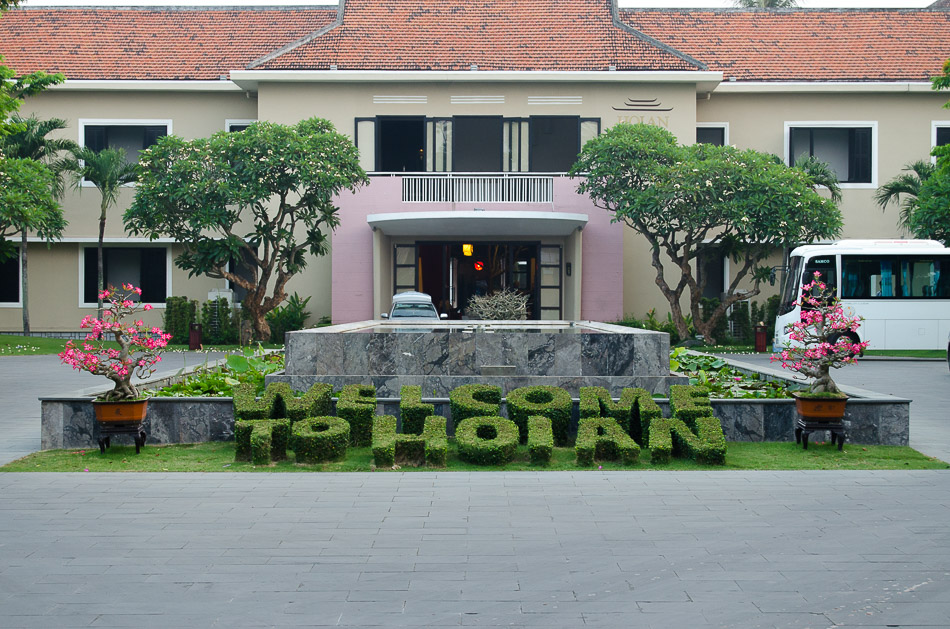
When we got there the doors were still closed, so we decided to sit and wait by a water stream nearby. Our backpacks probably caught the attention of a random lady who approached us asking if we needed a place to sleep. We politely declined the offer saying we already had a reservation, so she left for a few moments just to come back on a scooter to make the same offer ̶ that we declined once more. Maybe she thought we wouldn’t recognize her with a helmet on.
Minutes later she started waving at us from her house, to let us know that her house was right there, on the other side of the stream.
Feeling awkward, we left and went for a coffee.
Hoi An Historic Center / Old Town / Ancient Town
We rented two bicycles from our accommodation to visit Hoi An old town. In 10 minutes we arrived at the entrance, left the bikes away from the bike park assistants, and headed to Chua Phap Bao Pagoda.
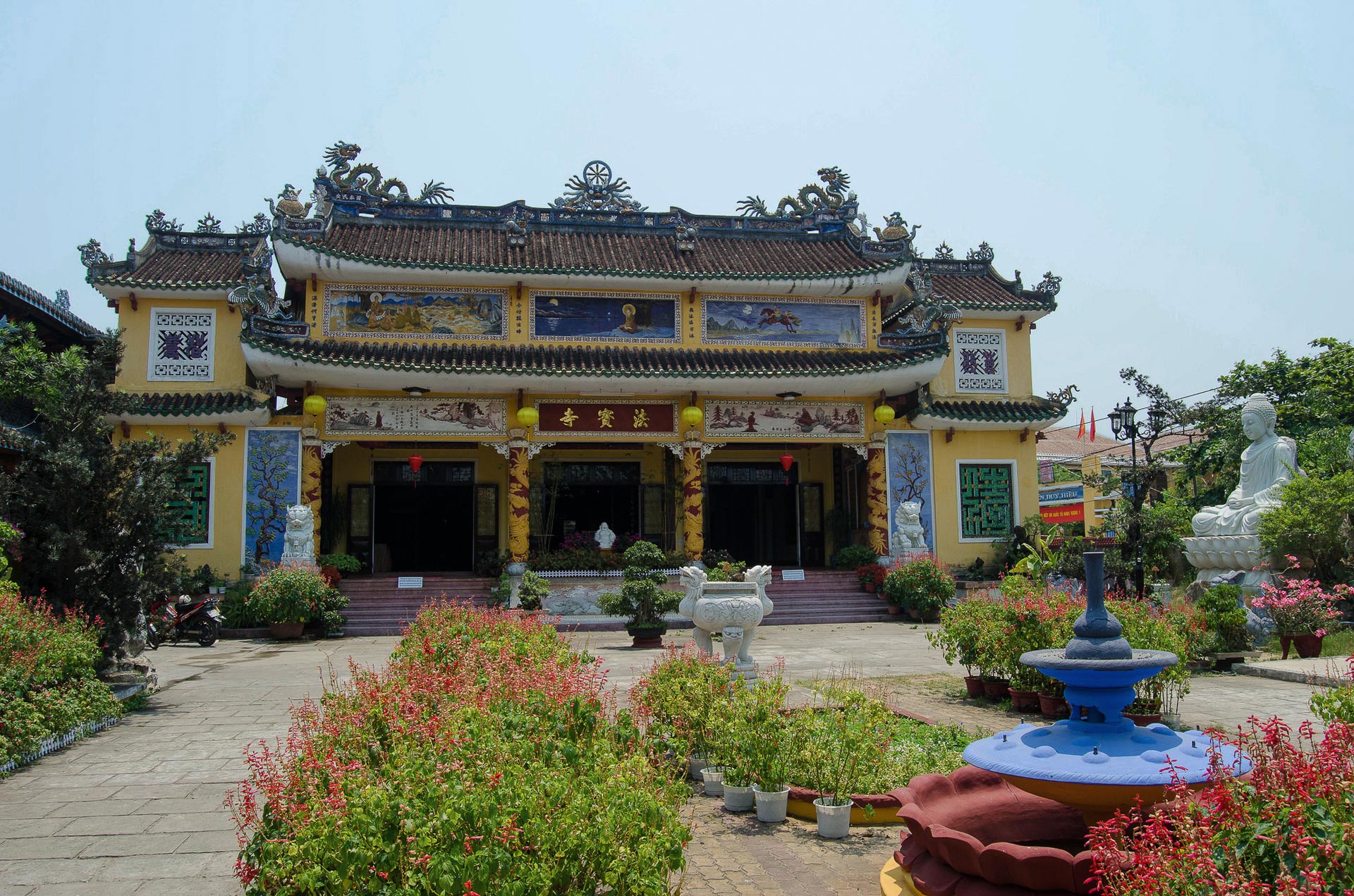
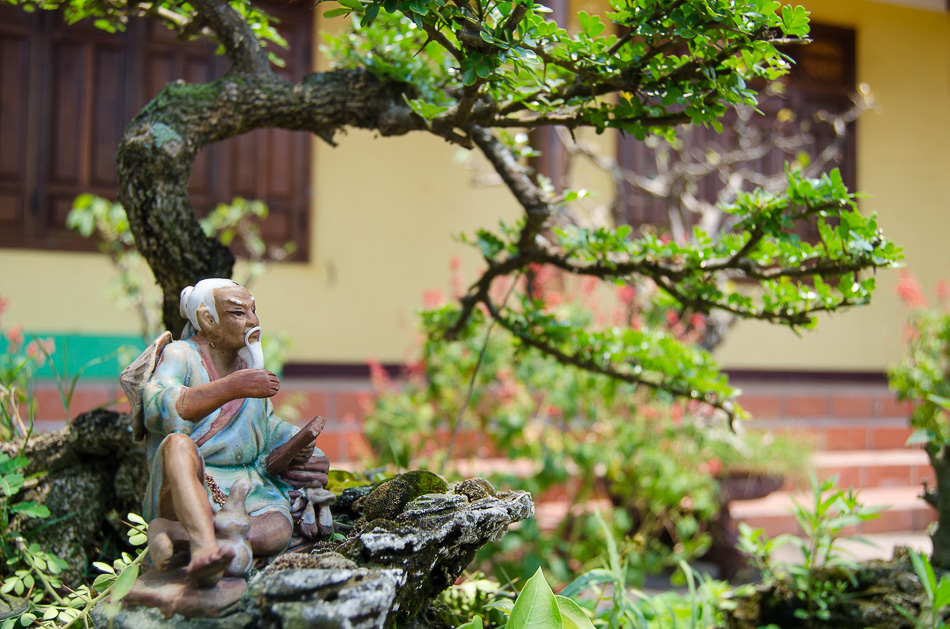
Hoi An was a far Eastern trading port from the 15th to the 19th century. The town is a complex of narrow pedestrian streets colored by bright yellow houses, temples, and paper lanterns. Being the UNESCO World Heritage Site that it is, the streets are overflowing with tourists and unfortunately, a big part of these traditional buildings was transformed into souvenir shops.
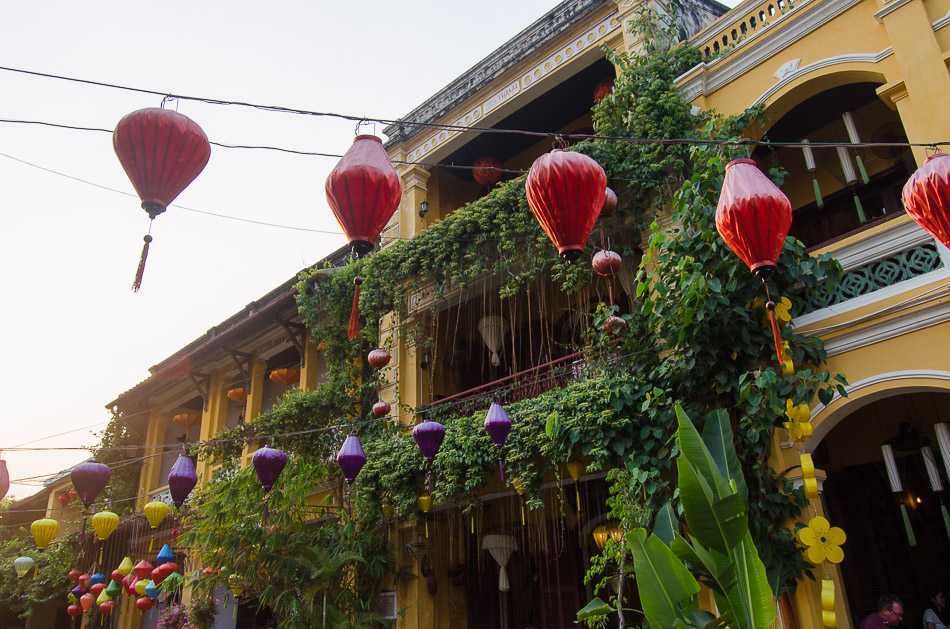
The original street plans and townscape remained intact, but you’ll find many houses serving as coffee shops, tailors, photography shops, knick-knacks shops, and restaurants.
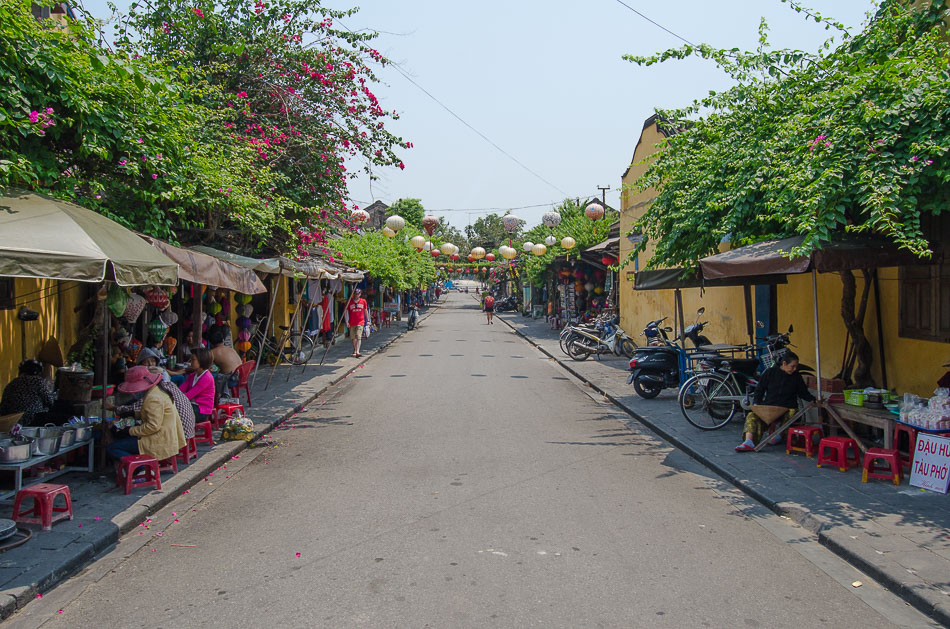
Restaurants here can get a bit pricey, but you’ll find some food stalls away from the main streets. We ate a very decent bowl of cau lao: noodles on some sort of aromatic broth with dough fritters and roast pork on the top, at a fraction of the price of the fancy restaurants nearby.
Entrance fee
To visit the historic center of Hoi An you’ll have to buy a ticket at the Tourist Information Center: we paid 4.74€ each.
The ticket comes with a map of the area highlighting some temples and houses, allowing you to enter 5 different attractions within the historical center in 24 hours. After the first 5, you’ll have to pay for every individual place you decide to visit next. In total there are 22 points of interest listed.
We managed to visit more than 5 without paying any extras, so you might get lucky as well.
It’s a bit hard to define the opening hours of all the places, but we can say that most of them close around 5.30 PM, and some close for lunch.
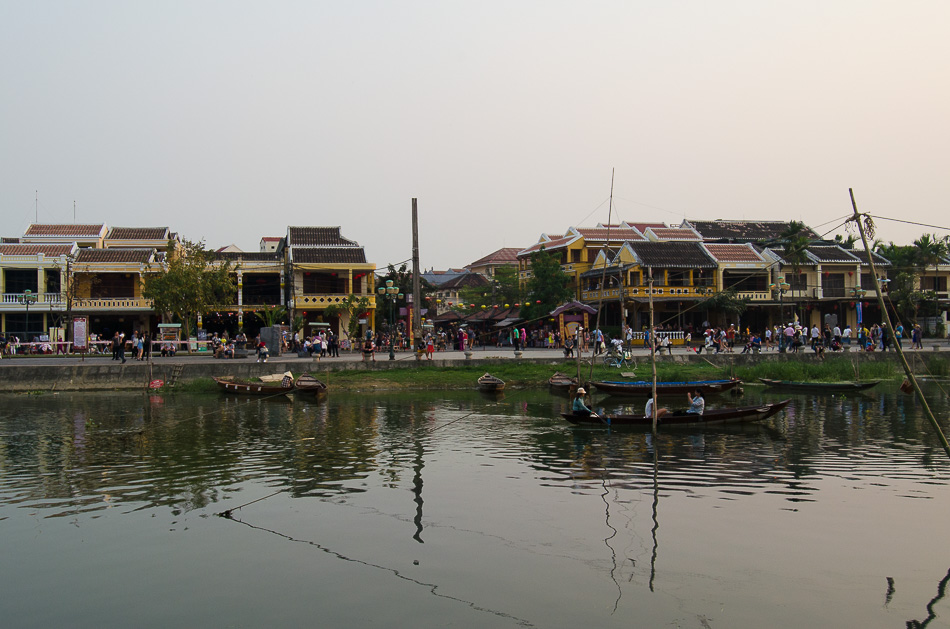
The first one we visited was: Quan Thang. You can skip this one, it’s not worth wasting an entrance because all you’re allowed to see is a dark hall.
Actually, we couldn’t believe that was all, so we kept walking through the lobby until we entered the kitchen at the farthest end of the house. We only realized that wasn’t part of the visit when we were invited out and the door slammed behind us. Rude! 😀
We continued to stroll the streets and visited the beautiful Cantonese Assembly.
Afterward, we went to the Tran Family Chapel and the Tan Ky House (over 200 years old), both with a small guided tour explaining the history and architecture of the houses, concluding on a room turned into a gift shop.
All these traditional timber-frame houses have a mix of Indigenous, Chinese, Japanese, and French influences, and have been passed on to family descendants.
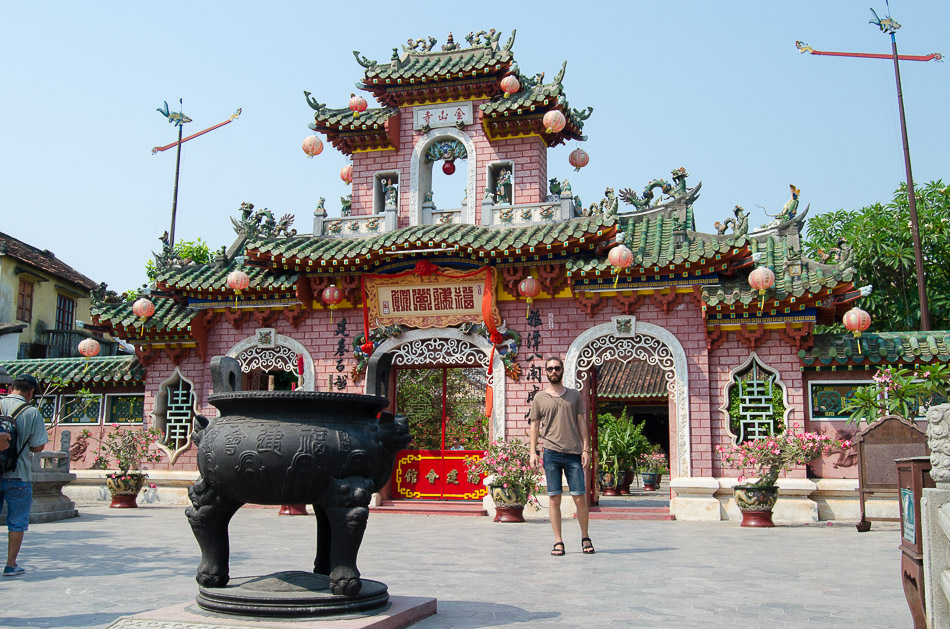
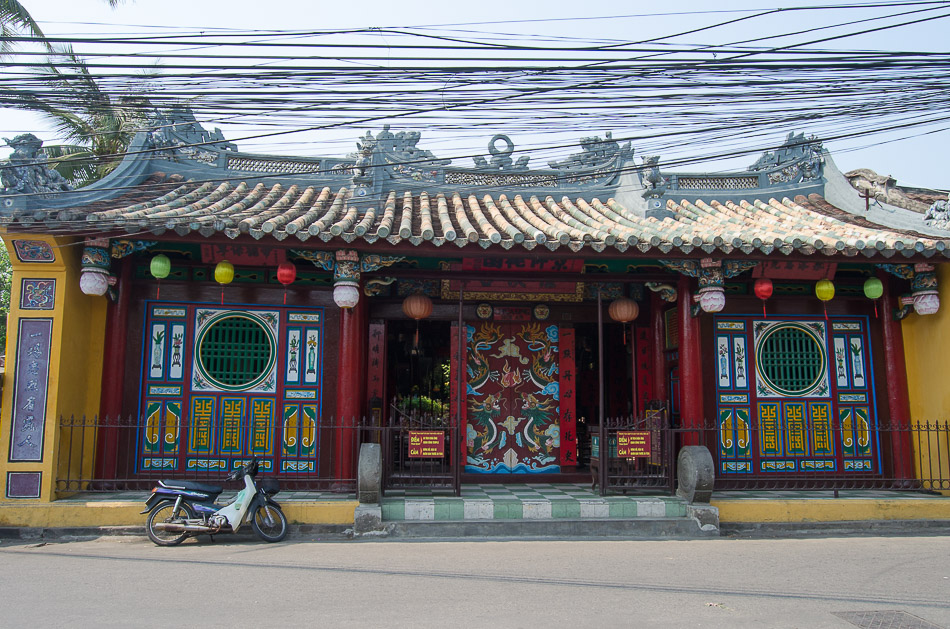
We zigzagged through tourist crossing the famous 18th century Japanese Covered Bridge, it was a bit crowded, to say the least. If you just want to cross it, you won’t need to show your ticket unless you want to visit the adjacent pagoda.


Recommendations
• Museum of Trade Ceramics
• Museum of Folk Culture
• Museum of Sa Huynh Culture
• Quan Thang
• Duc An House
• Full Moon Lantern Festival: there are 13 festivals in 2017, check the calendar here.
The Market
In the late afternoon, we walked towards the local market. While checking some fruits, Mario was approached by a sweet-talking girl who, that allied to his inability to say “no”, managed to drag him to a tailoring stall to sell him a suit. It took him 20 minutes to get out of there, mainly because she didn’t take “no” for an answer and had a solution for every excuse possible ̶ including international shipping.
It reminded us of pushy Bangkok tailors, shamelessly touting to every tourist passing by.
Thu Bon River at night
The historic center is divided by the Thu Bon River. Here, locals in their small wooden boats, invite you in as soon as you approach the promenade.
At night time the river gets lit up by floating paper lanterns sold by young girls all around the riverbank. In the streets hundreds of lanterns create a magical atmosphere, inviting everyone for a night stroll.
You must walk around Hoi An old town at night, there’s plenty to do and to see.
Cua Dai Beach
On the morning of our second day, instead of pedaling towards the historic center, we headed towards the ocean. In the middle of the bike ride that took around 50 minutes, we stopped at a cafe and ended up talking with the owner.
The conversation flowed and eventually, we reached the topic of global warming and the rise of sea levels. The owner of the cafe ̶ a very sweet Vietnamese lady who had never traveled abroad ̶ talked about her childhood on Cua Dai beach that is now partially destroyed. She was a bit surprised to hear that this is a global problem when we told her that the same is happening on the Portuguese coast.
Later on, when we arrived at Cua Dai beach, a big portion of the shore was made of sandbags stacked together to contain the sea.
We spent two days in Hoi An which was enough to feel the area and visit the picturesque historical center. Despite the many tourists, Hoi An managed to convey a really intimate and magical atmosphere.
Expenses
Things tend to be a bit more expensive around here: accommodation, bike rental, and food. Luckily we booked a room with a fridge and ate tons of fruit from the local market (best watermelon ever).
Hoi An Tourist Ticket: 4,74€
1,5L Water bottle: 0,16€
Lunch: 1,55€
Dinner: 3,7€
Accommodation : 5,40€
Coffee: 0,35€
Bus ticket NhaTrang > Hoi An: 7,89€
If you have any questions or some extra info to share, please leave it in the comments below!
Waking up in Ho Chi Minh City
Eager to be on our way to Vietnam, we used the time stuck on the bus to discuss what we were going to do at the Prek Chak-Xa Xia border. The main goal was to follow the advice given to us in Kampot by the hotel clerk
– If you want to cross the border without paying extra tourist fees, ignore the first guard. Walk straight to the second counter, get your passport stamped and move on. The guard on the first counter is there to charge money for a stupid temperature check.
So that was the plan: to show up with a serious face and walk confidently toward the second counter as if we’d been there before.
Didn’t work. We got called immediately to the first counter, had our temperature checked with an infrared gun, and got charged for it. Luckily it was only 1 USD.
Two hours later we reached the Haitien bus station where we waited for a night bus to Ho Chi Minh. Restaurants all around were full of people eating and waiting for departure.
Having a 10-hour bus trip still ahead of us, we decided to eat something on a plastic table and tiny stools right next to the buses: pork noodles à la exhaust smoke. Yum!
If you haven’t booked your bus to Ho Chi Minh yet, go to www.bookaway.com and use the code “gravy5″ at checkout to get 5% off the ticket price.
Our first trip on a Vietnamese sleeping bus
They look like tour buses and can be quite comfortable if you’re not 1.90m tall like we are. Each passenger gets a tiny bunker bed, a blanket, and wifi – if they’re lucky.
Vietnam "sleeping" bus. #neon #vietnam #bus #traveler #travelling #travel #light
A post shared by Mario and Nuno | Travel (@helloplanetgravy) on
The trip ended up taking around 8 hours, with a 20-minute bathroom break at a huge decked-out service station where we tried our first pork steamed bun ever!
At 4:00 AM we arrived at Ho Chi Minh’s District 2 on a mini-van. The city was quiet except for Bui Vien street where tourists stroll around from bar to bar and sinister people covertly sold drugs – 10 seconds in, we were offered cocaine.
Waiting for the sunrise
Tired, we walked to a park nearby and rested on a bench waiting for the sun to come up. Around 5:00 AM the city started to wake up: cars and people moving around, birds chirping and pooping on my leg… We’re off to a good start!
By 5:45 AM the park was packed with locals playing badminton, power walking, and doing Asian Zumba classes. We were surprised to see so many seniors working out. Quite inspiring, take a look at the video:
We stayed in Ngan Long Hotel, about 15 minutes walk from the backpacker’s street – Pham Ngu Lao. Being the first thing in the morning and unable to do an early check-in, we left our bags in the reception and went out to explore District 1.
Ho Chi Minh City is the largest Vietnamese city where something like 9 million people live. The urban part is divided into 19 districts and we were housed in the first.
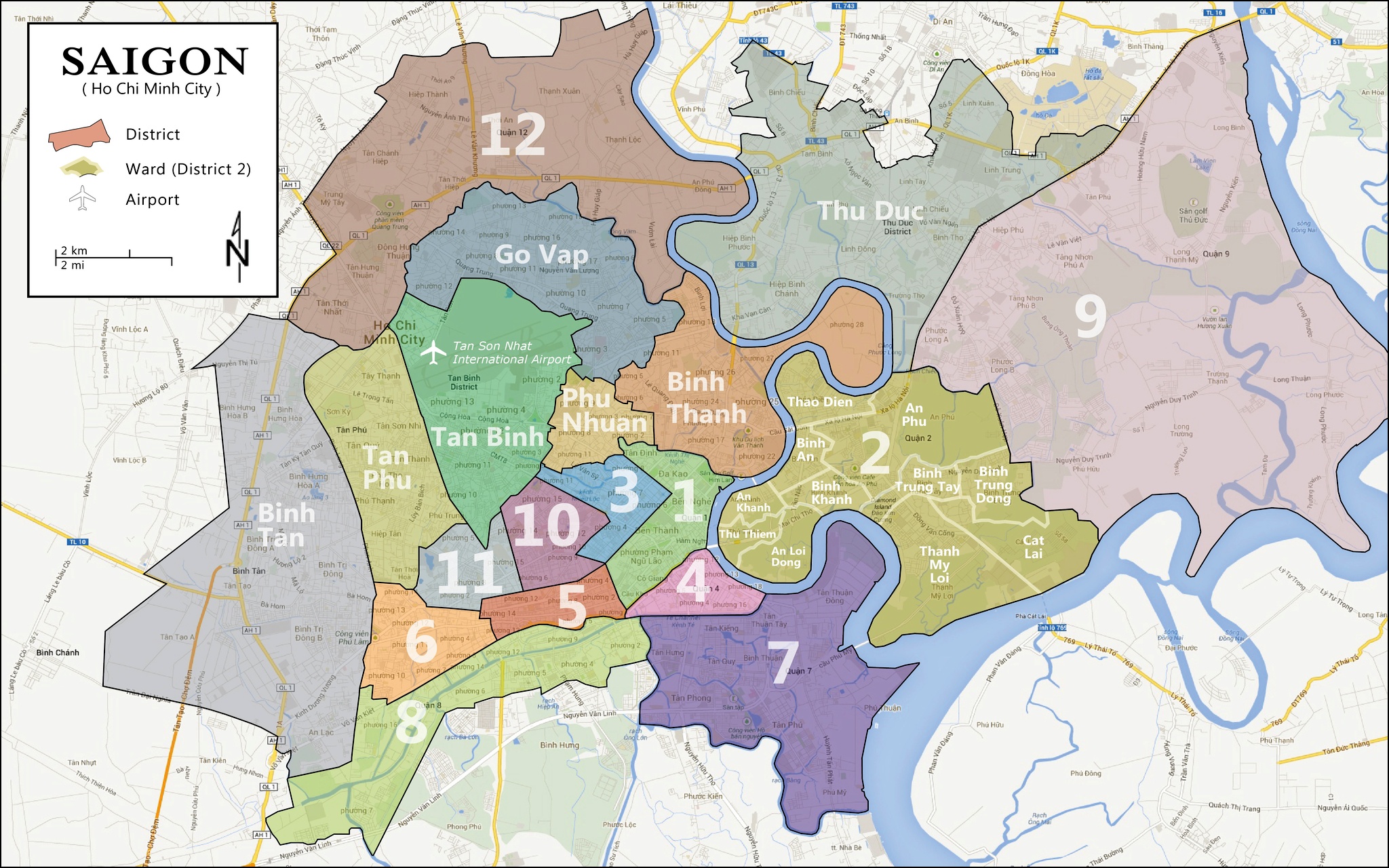
Image by Codie Leseman via CodieMaps
District 1
Around the backpacker’s street in District 1, most businesses are geared towards tourism: Western-style cafés, restaurants, pastries, and souvenir shops.
Narrow streets become wider avenues when you walk towards the river and you’ll find yourself surrounded by financial buildings, fancy shops, and the classic Opera house.
If you’re into books, there’s a massive bookstore called Fahasa on Nguyen Hue Street, filled with English books at Vietnamese prices (like half the price you can find them in Portugal).
We walked along the sidewalk by the river to the Vietnamese History Museum. The museum is located in the same area as the Zoo and the Botanical Garden. The entrance was 0.59€ and inside you’ll find history from all periods of Vietnam: from the pre-historic to the latest dynasties. It’s a “classic-style museum”, not one of those modern ones with interactive panels, video, and sound.
Later we visited the Independence Palace, a building associated with the history of Vietnam’s war, home of the president of the south and the last stronghold to be conquered by the northern army.
The entrance was €1.18 and it took 1 hour and a half to visit the garden and the various levels of the building including the underground bunker. The bunker was built after the president’s own air force bombed the palace trying to kill him.
It’s astonishing to be down there among war maps and 70’s radio transmitters. The place feels heavy and claustrophobic, there’s a weird tension in the air as if one of those old telephones could ring at any moment.
Religious Drive-Thru
After visiting the Palace we walked along the large avenue right in front of it to see The Notre Dame Cathedral. Unfortunately, it was closed on both days we tried to enter.
The cathedral was built with red bricks imported straight from Marseille and today it represents the influence French settlers and Catholicism had over the city—Catholicism is still the second-largest religion in Vietnam.
We were told that on the days there’s mass, locals park their motorbikes around the cathedral and listen to the priest from the bikes, never bothering to go inside.
Still on the subject of French-influenced architecture, right next to the cathedral is the Central Post Office, a very well-maintained building where you can get in for free, enjoy the beautiful interiors and dispatch a few postcards to people back home. The post offices still work and are used by the Vietnamese to this day.
District 5: Cholon and Chinatown
On our last day in Ho Chi Minh, we decided to explore Cholon in District 5 – the largest Chinatown in Vietnam. We wanted to go by bus but couldn’t find the correct information. Luckily we managed to get it from a local girl after some severe hand gesturing and Google translate:
From District 1 to District 5 get the blue bus Nº1. It’s a 5km ride that costs €0.20.
Cholon has an immense Chinese community and it’s like a small town itself. The Chinese influences are all throughout the area creating a unique atmosphere: authentic restaurants, pagodas, and markets like the busy Binh Tay Market where everything is bought and sold, makes up for a great day.
We spent our afternoon sightseeing, walking, eating fruit, and taking pictures. By the end of it, we headed back to the city center in the same bus, the Nº1.
The bus rides and the experience of being pedestrians around town showed us how hectic the traffic is. People crossing the road feinting each other, hundreds of scooters gathering at the red traffic lights, while others speed up and cut corners as the light turns green.
Once a Khmer fishermen village, centuries of conquering, colonization, and political change made Ho Chi Minh City a cultural global center. Locals were friendly and interested in other cultures, approaching us time and time again to make conversation even if just to practice their English.
HCMC travel expenses (daily average for 1 person)
Breakfast: 1,67€
Lunch: 0.59€
Dinner: 2,16€
Water: 0,18€
Accommodation: 5,70€
Entrance to the Independence Palace: 1,18€
Entrance to the Vietnamese History Museum: 0,59€
If you have any questions or some extra info everybody can benefit from, leave it down in the comments!
Dalat: what to do and what to eat
We left Mui Ne on a small bus and headed to Dalat, a city in the Highlands region of Vietnam. Lying on the hills and surrounding Ho Xuan Huong Lake, Dalat’s climate differs from the otherwise tropical climate of Vietnam—the lower temperatures and humidity gave it the name of the “City of Eternal Spring” or how the French used to call it “Petit Paris”.
Getting to Dalat
If going uphill in an old car may be difficult, it’s harder when you do it on an overheated-prehistoric minibus with no leg space. The minibus had air conditioning, it just had to be turned off during 95% of the ride, otherwise, the bus wouldn’t go up.
The trip took around 4 hours through twisting roads and cars overtaking us like in an action movie. On the bright side, the landscape grew greener as pine trees started covering the hills. Up there, coffee plantations and strawberry greenhouses substituted the dragon fruit plains of the lowlands.
Looking for a bus to Dalat? Go over to www.bookaway.com and use the code “gravy5″ at checkout to get 5% off your ticket price.
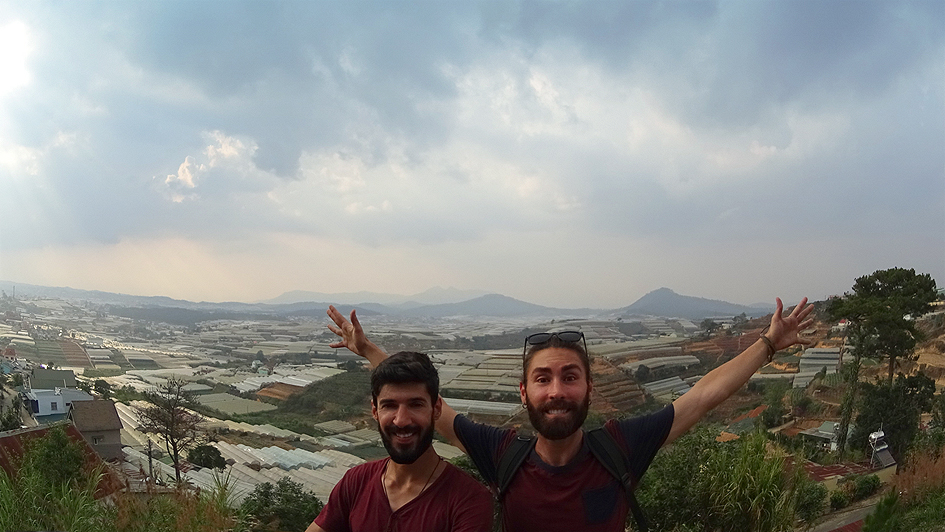
The bus stopped at the door of the Au Phu travel agency in the city center. Apparently, all tourist buses stop here, so as usual, taxi and bike drivers awaited.
What to do in Dalat
On our 3-day stay in Dalat, we rented two mountain bikes at Groovy Gecko Adventure for €3.30 each, for half a day. It was the best deal we found in the city and the bikes were pretty good.
Linh Phuoc Pagoda
On the first day, we pedal for 40 minutes to the Linh Phuoc Pagoda—a complex of temples different from what we had seen so far. The decoration was of Chinese inspiration, more figurative, detailed, and adorned with pieces of colored tiles.
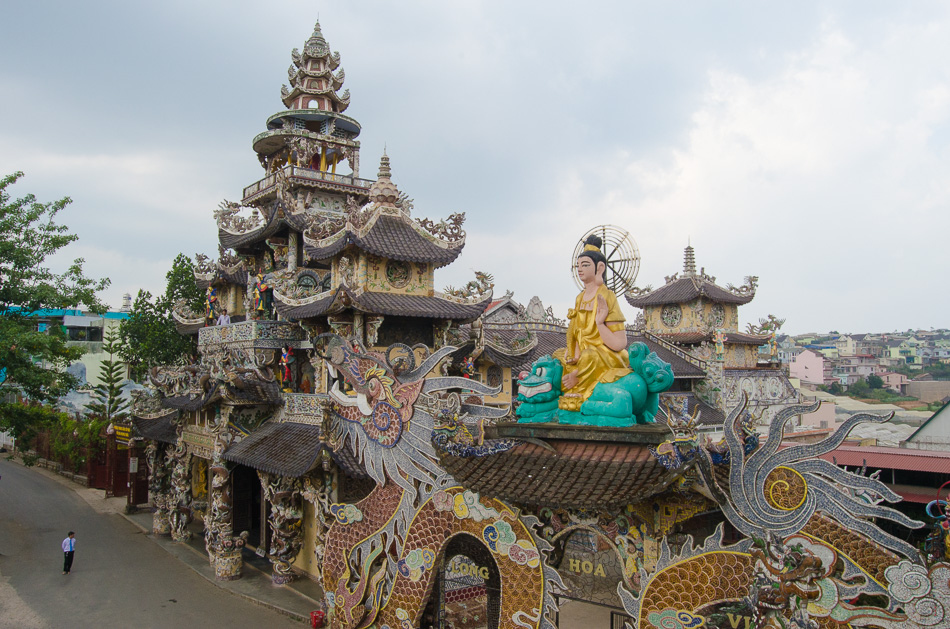
There are towers to climb, giant statues of gods and goddesses, wax monk figures, and winding glaze dragons to see. Unfortunately, we weren’t allowed inside the main hall because we were in shorts, so consider that before you go.
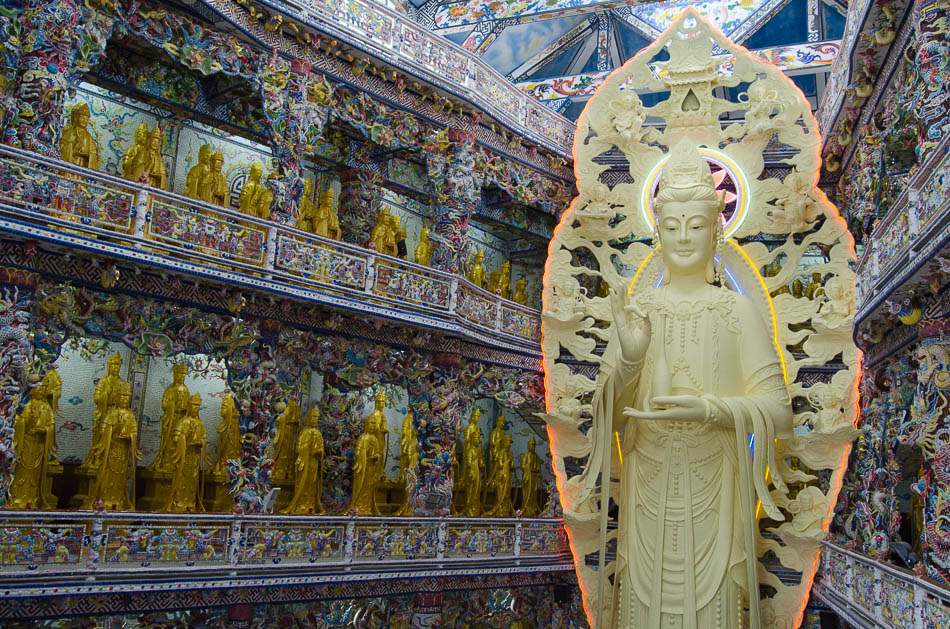
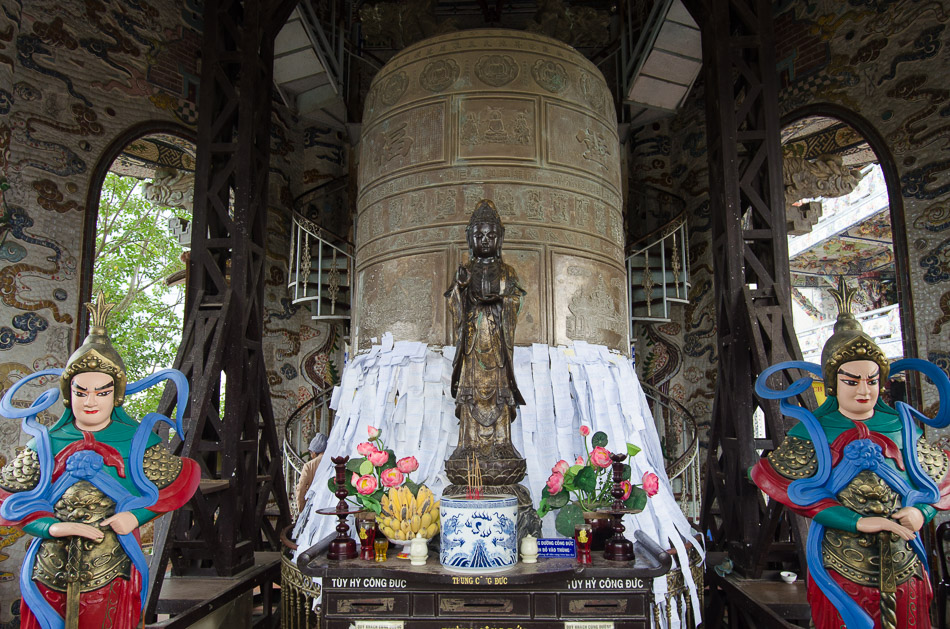
You can grab something to eat at the restaurant inside the complex for little money. They sell dumpling soup, soda, fruit, and ice cream.
Thap Cham Railway
On our way back to Dalat we stopped by the Crémaillère Railway Station, an art-deco building from the 30s that these days only operates a 7 km trip, connecting Dalat to the village of Trại Mát.
Later on, we biked to the Xuan Huong Lake in the city center and rested our legs in the grass while watching the sunset.
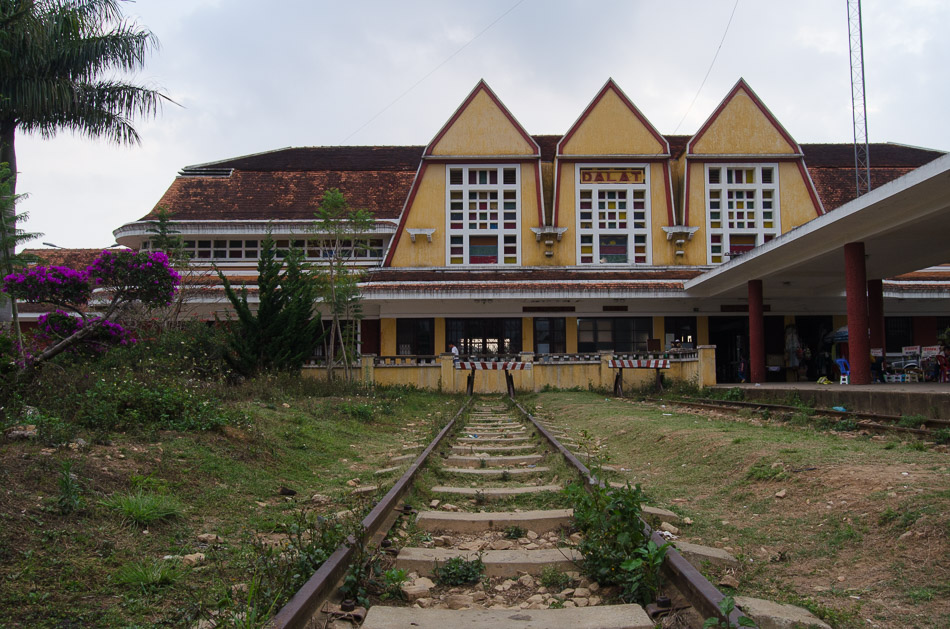
Visiting the city center
As the night began to set, the central square transformed into a proper Asian night market. The streets came alive with hundreds of people captivated by neon lights from restaurants and street food stalls, and by the perfect piles of fruits, cheap clothes, and knick-knacks.
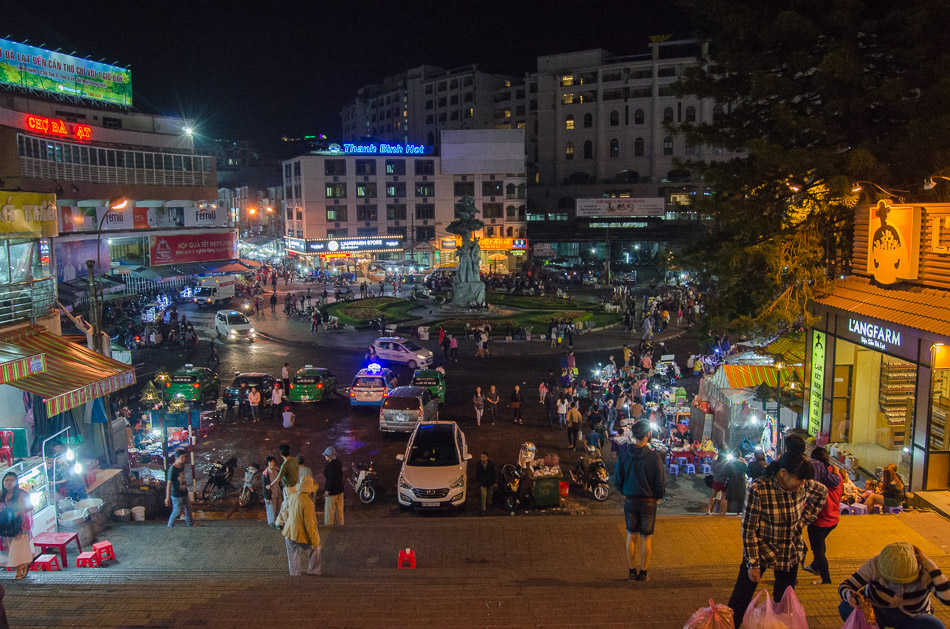
Crazy House
The next day we visited the Hang Nga or ‘Crazy House’, the bizarre private home of an imaginative architect that is now a hotel and a tourist attraction.
A post shared by Mario and Nuno | Travel (@helloplanetgravy) on
The house keeps augmenting to follow the plans of its creator, financed by the revenue generated by ticket sales: €1.64 for one person.
Bao Dai Summer Palace
Further up the mountain in the middle of a pine tree forest is the Bao Dai Summer Palace, one of the residences of the last king of feudal Vietnam.
The entrance fee was €0.62 (plus an additional fee if you want to take photos), and it grants you access to the 52 rooms of the palace.
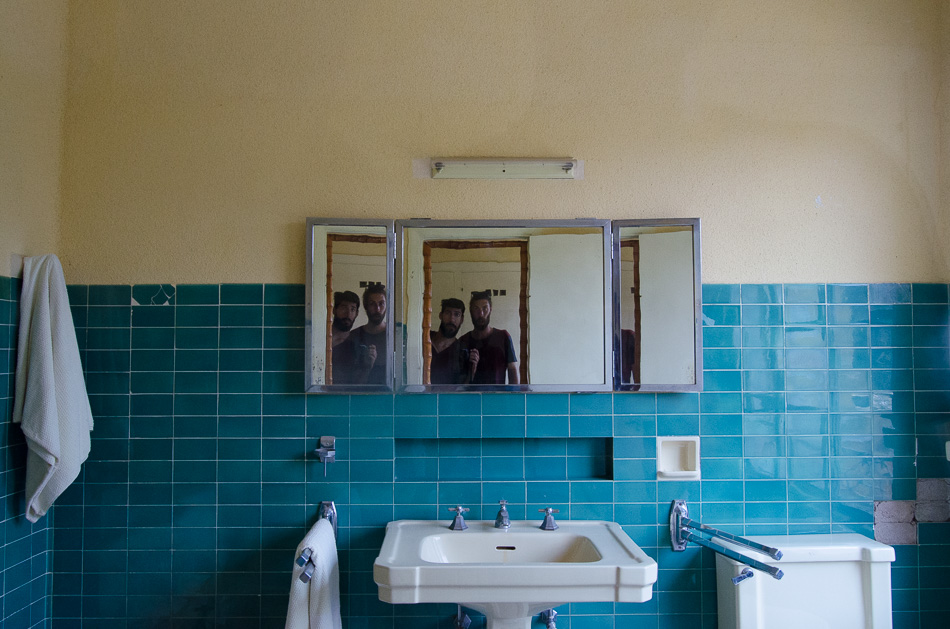
It was fascinating to see the home of the royal family, their objects, and the portraits on the walls. The visit ended in the downstairs kitchen and through a gift shop full of generic souvenirs.
Truc Lam Pagoda
We kept pedaling to the Truc Lam Pagoda, a delightful Buddhist monastery amid pine trees and gardens in pristine conditions. The pagoda is maintained by monks and nuns that reside there.
We spent a good hour staring at the lake and the surrounding mountains. There was a scent of incense in the air and big metal wind chimes ringing in the breeze. You can’t get more ZEN than this, it was beautiful!
Thien Vien Van Hanh
On the third day, we only had the chance to visit the Thien Vien Van Hanh pagoda in the morning.
A post shared by Mario and Nuno | Travel (@helloplanetgravy) on
The rest of the day was spent at a cafe drinking hot tea while it rained like crazy. It was a big tropical storm that lasted all afternoon and flooded our hotel room.
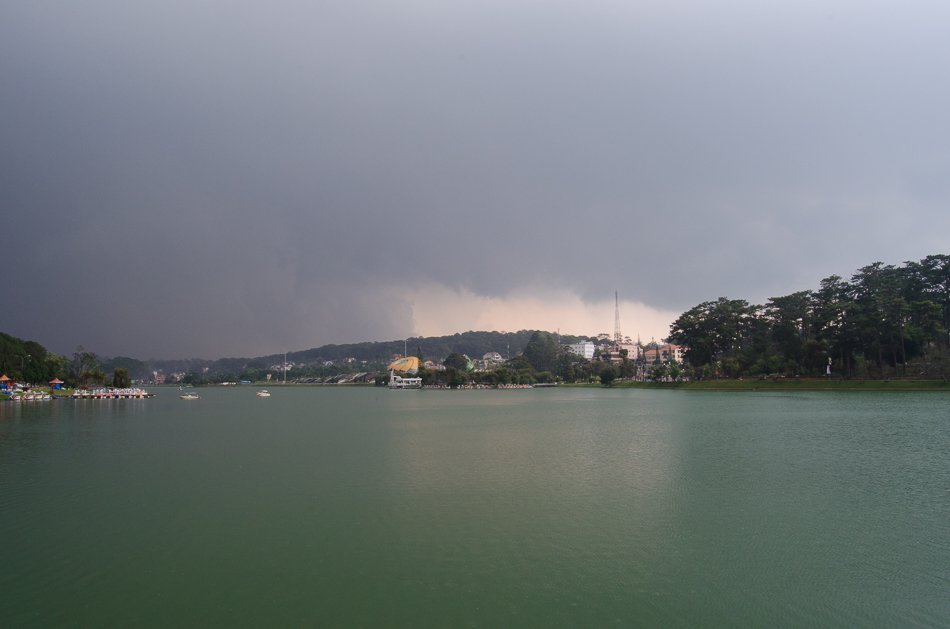
What to eat in Dalat
Here in Dalat, we ate several things for the first time.
Like this flat pizza/crepe hybrid, with egg, sausage, and chives sold in the central square at night.
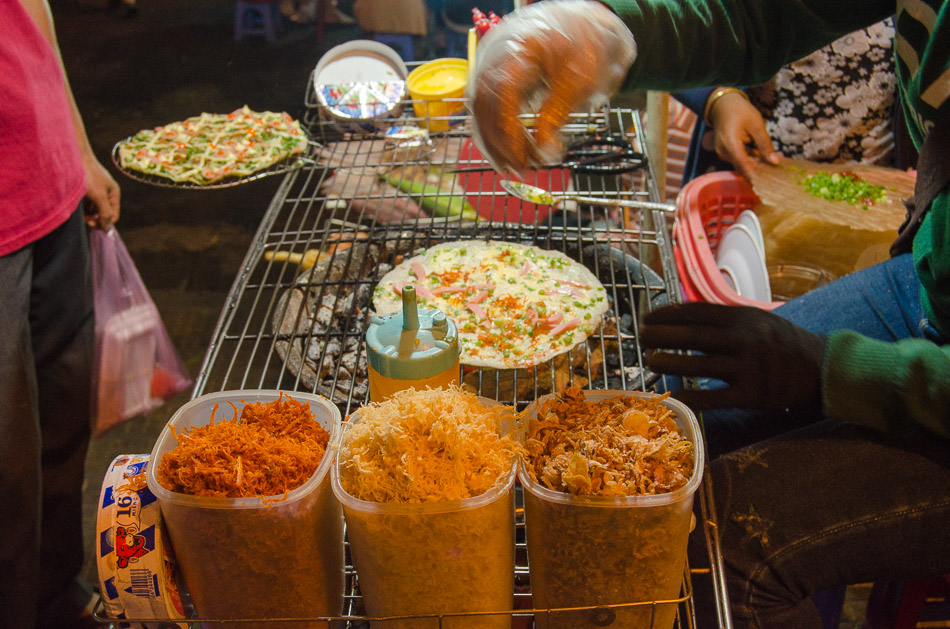
BòNé
It was late at night and we couldn’t find a place to eat that looked “trustworthy”. Eventually, we passed by a restaurant with people cooking at the forefront: sausages, fried eggs, coriander, and sizzling meat. Table for two, please!
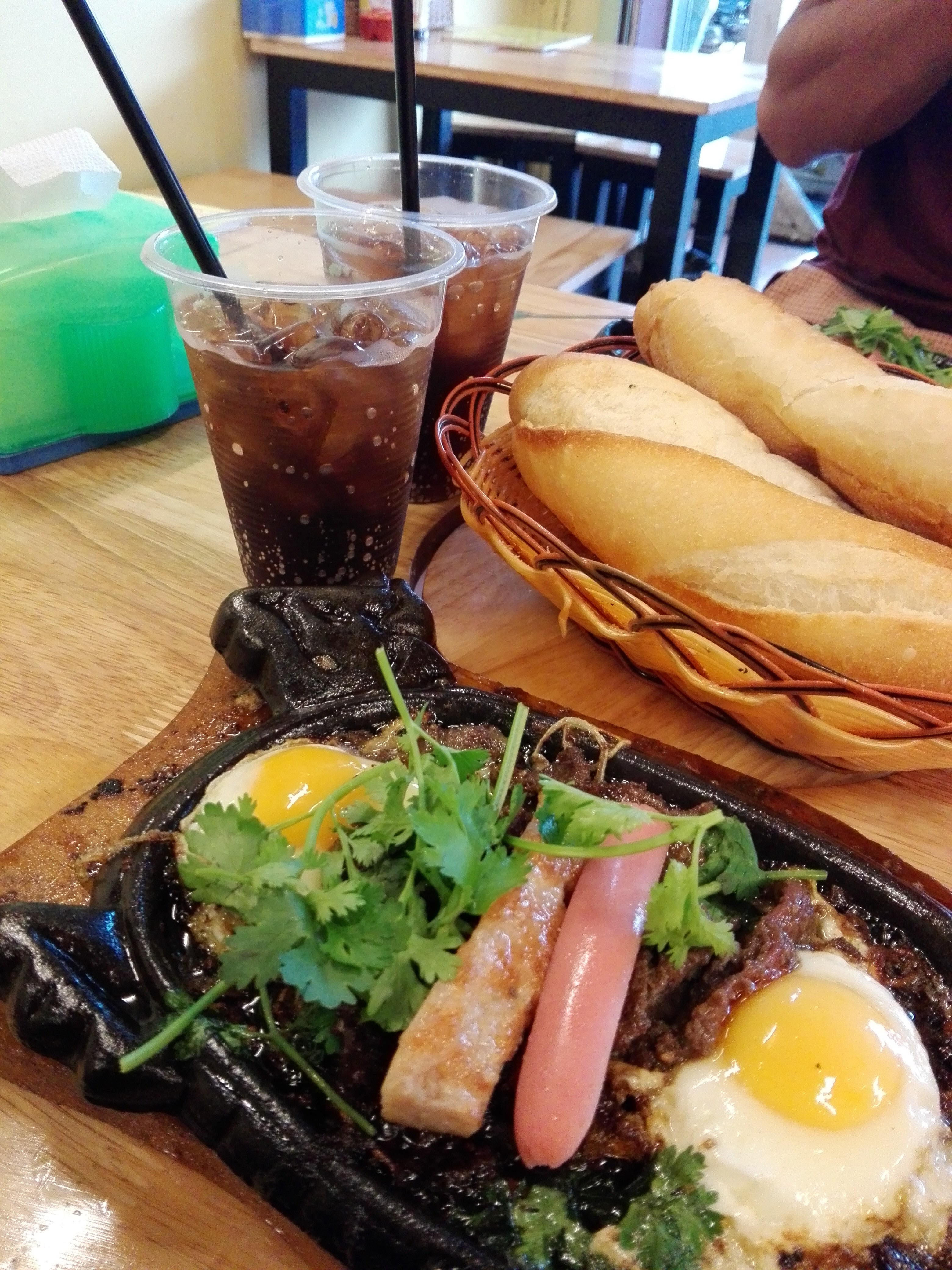
The restaurant Bò Né 3 Ngon was dripping oil from the walls and the floor was a slippery slide. Not one word on the menu was written in English and no one from the staff spoke it. When we asked them a question, they pointed to the menu on the wall (same menu we had on our hands but with bigger letters). We shrugged and ordered a “Number 2” because the restaurant smelled delicious and we like surprises.
Bakeries
Nuno and I are big bread lovers and luckily, Dalat has several bakeries, most of them doubling up as restaurants. They have a huge selection of bread and other baked goods, all super affordable.
Fried cakes and milk
One night walking around secondary streets, we noticed some locals gathering near a food stall, sitting on the characteristic tiny Vietnamese chairs.
It smelled sweet so we curiously approached the stall. Behind it, a Vietnamese lady was selling assorted fried dough cakes and different kinds of warm milk. You can pick 3 or 4 cakes and one glass of milk, sit down on the tiny plastic chairs and eat.
And so we did!
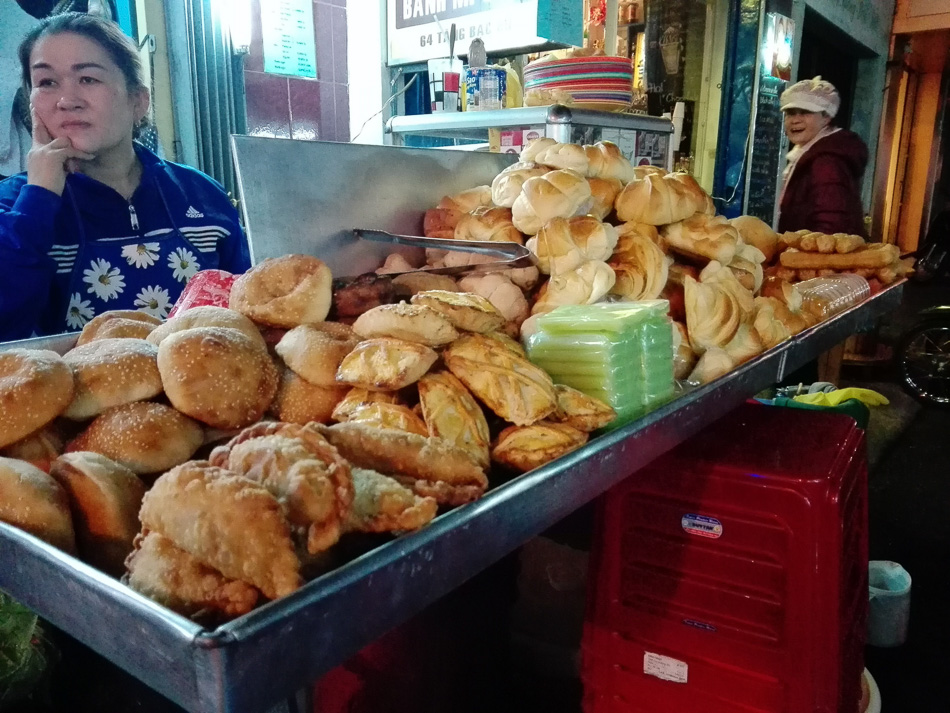
If you’re visiting Vietnam and need to freshen up from the heat of the lowlands, climb the mountain and check this friendly city.
Dalat travel expenses (Daily average for 1 person)
Bus Mui Ne/ Da Lat: 4,43€
Breakfast: 0,87€
Lunch: 1.05€
Dinner: 2,43€
Water bottle: 0,20€
Coffee: 0,53€
Hotel: 3€
Crazy house Ticket: 1,58€
Bao Dai Summer Palace: 0,59€
Bikes: 3,30€
If you have any questions or some extra info everybody can benefit from, please leave it in the comments below!
Easy guide to Sapa mountain trekking
As soon as you set foot on Sapa, you’ll be bombarded on all sides by trekking opportunities. So there’s no need to book a trek in advance because resources abound.
In this guide, we will delve into the whole Sapa trekking tour process:
• How to book it
• Treks to choose from
• Prices
• Equipment
• Our experience at it
Booking a trek in person or by phone
Two months before arriving in Sapa, we were recommended a local guide by a Portuguese backpacker we met in Kampot. We followed her suggestion and called Mama Mae — the local Hmong guide she told us about.
The booking process was simple: you can do it directly with the local guides as they approach you in the street, or by phone since they’ll hand out their numbers if you’re not ready to commit on the spot. You can also do it through your hotel, the Sapa tourism office or any tour operator around town.
You can book one of the following options:
• Half day trek
• Full day trek: includes one meal
• 2-day trek with homestay: includes two meals and a few drinks, a bath, and a bed for the night (usually at the guide’s family house)
• Some tour operators like Buffalo Tours or Sapa Sisters offer up to 5-day trek options
Then you’ll set up the day, time and spot where the trek starts.
The payment is usually done at the end of the trek.
Price tables
Booking directly through a local guide will cost a fraction of what you’ll pay to a tour operator. Still, every guide has her own fee and these are some of the offers we got:
Mama Bau: 14€ for one day trek and 28€ for 2 days + homestay.
Mama Susu: 11,50€ for one day and 28€ for the 2 days + homestay.
Mama Mae: 11€ for one full day
Tour operator fees start at 35€ for one day
If you’re an experienced hiker you could do the trek on your own, but by hiring an experienced guide you’ll be helping the local communities and learning about them. Besides, no one knows the hillside as they do.
Let’s do this!
Nuno and I met Mama Mae at 9 in the morning, near the Gothic church in the city center. The two of us joined a group of four American girls and three other Hmong women that walked alongside us the entire trek.
Mama Mae spoke very good English but the other Hmong women did not. We figured that they must accompany tourists as a way to practice their English, so eventually, they can become guides themselves.
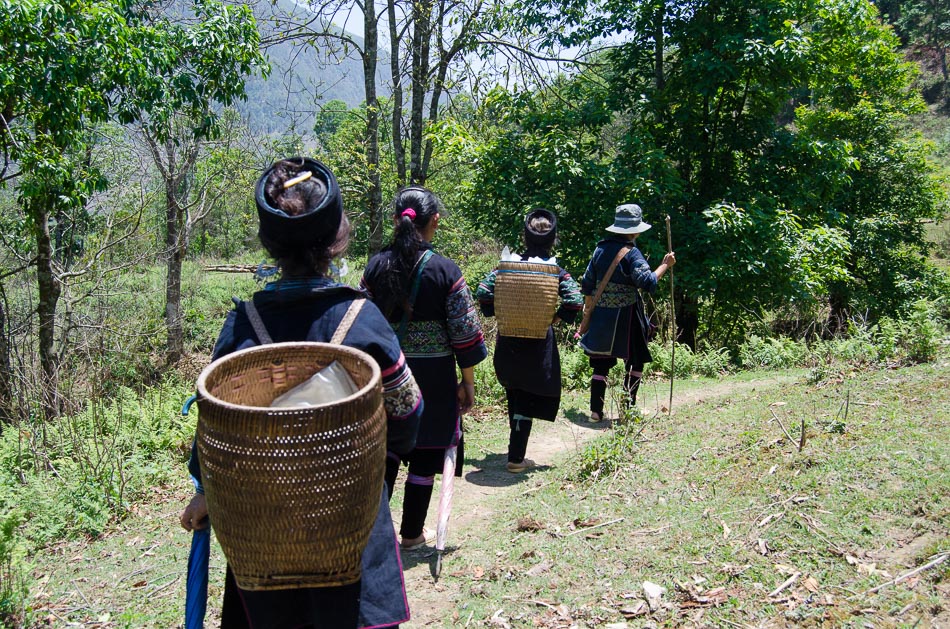
Take plenty of water
It was a beautiful warm and sunny day in opposition to the stormy days before. We were super excited to be out and about exploring nature, and having a genuine taste of the Vietnamese rural life.
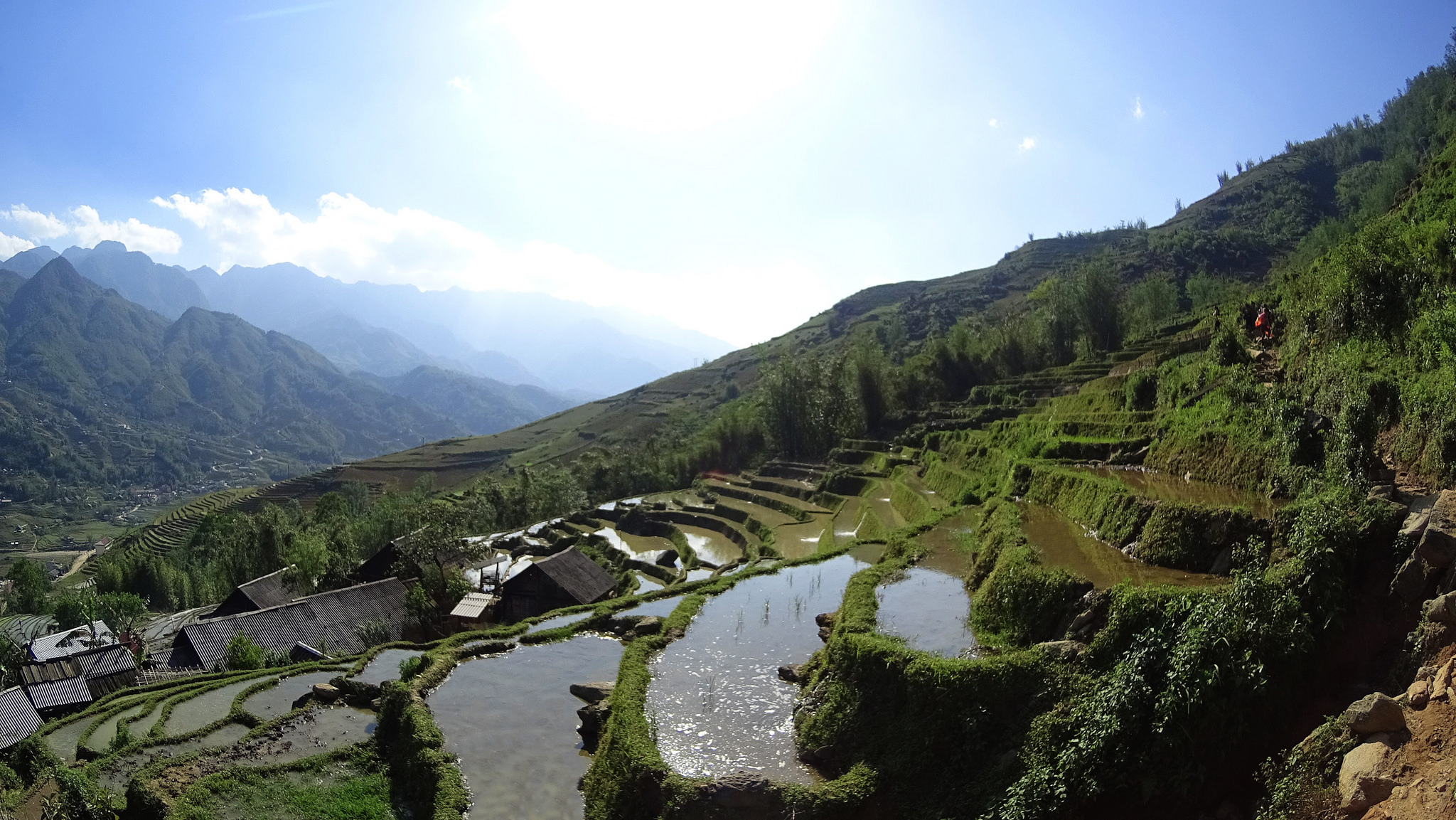
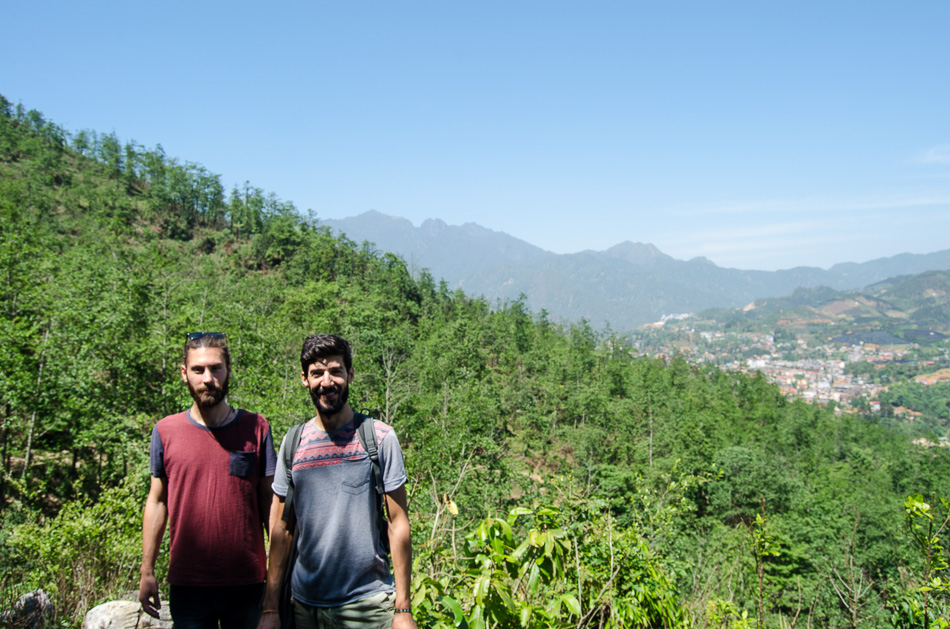
However, two hours in, we realized that 1,5L water bottle wouldn’t last long for two grown men hiking a mountain and descending through muddy rice terraces. Not to mention that Mama Mae got thirsty too, so we ended up sharing our water with her—because we’re gentlemen.
Take plenty of water, you’ll need it. There aren’t any shops in the hills, only in the villages.

Soul cleansing views
The scenery was breathtaking—everywhere we looked was like a panoramic screensaver!
Not only Mama Mae took us to the best lookout spots in the mountains, but we also saw water buffaloes, piglets, tea and cannabis plantations. We talked for hours about Vietnam, her family and ours. She was like an open book.
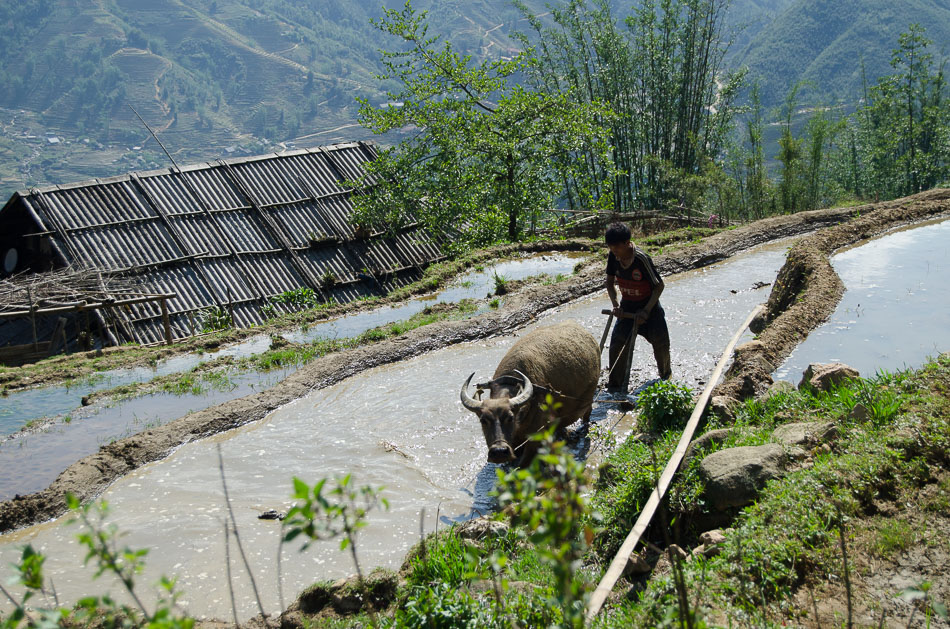
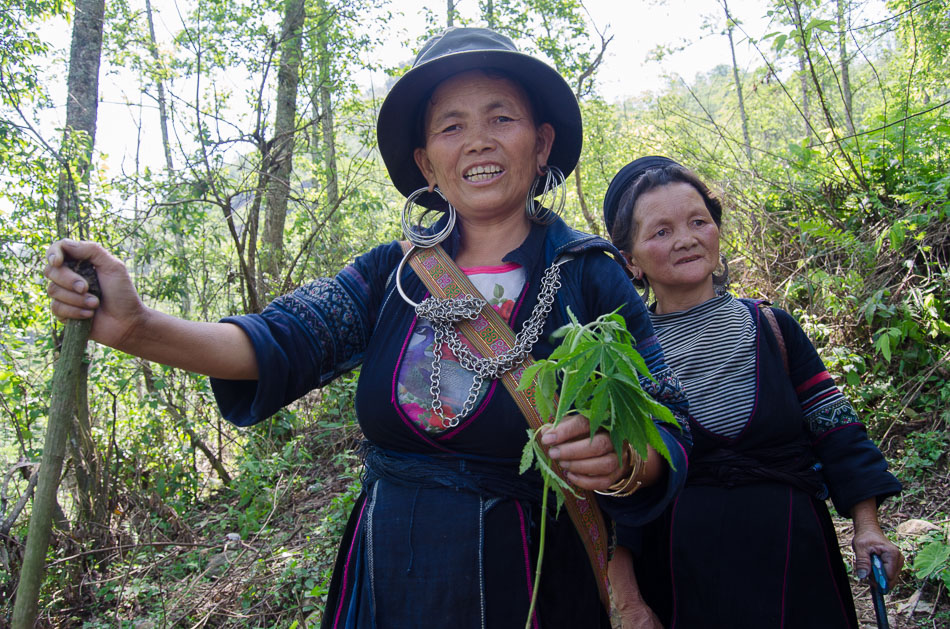
Meanwhile, the other 3 Hmong women kept walking by our side asking time and again:
– Where are you from?
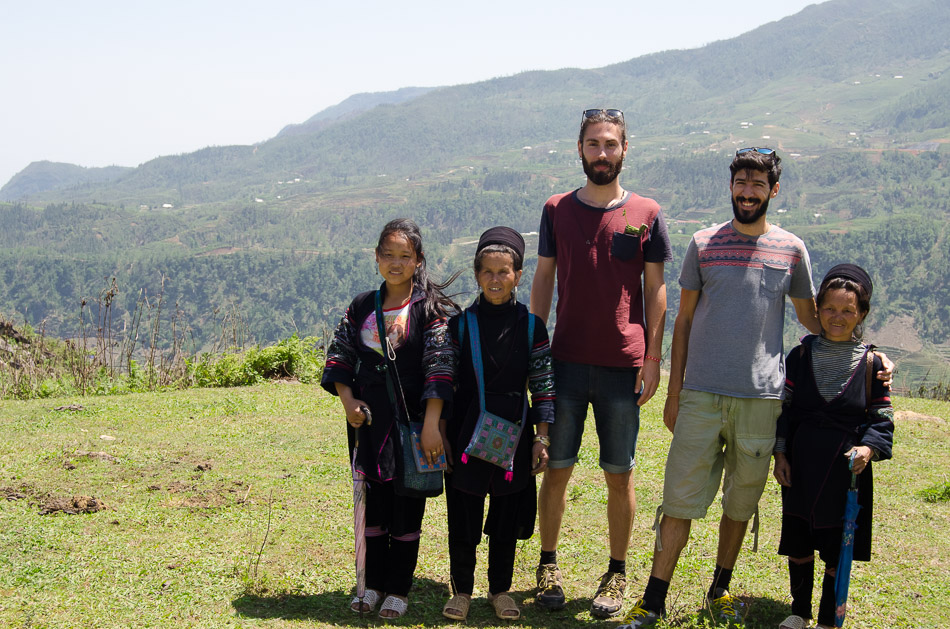
At noon, we stopped for lunch at a humble restaurant where other hikers were. Mama Mae provided us with a noodle soup and some pieces of fruit, but the drinks we paid ourselves. After lunch, we walked a few more hours to her house, where the first day of trekking ended. We met the husband and granddaughters as she prepared some tea for us: Lipton, believe it or not.
After tea, she explained how she makes indigo blue dye from plants.
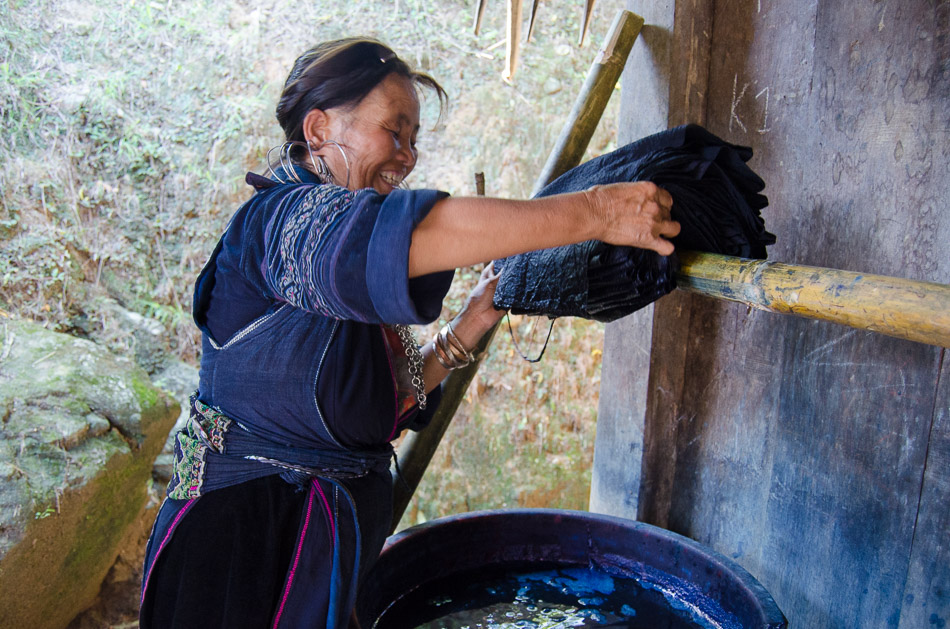
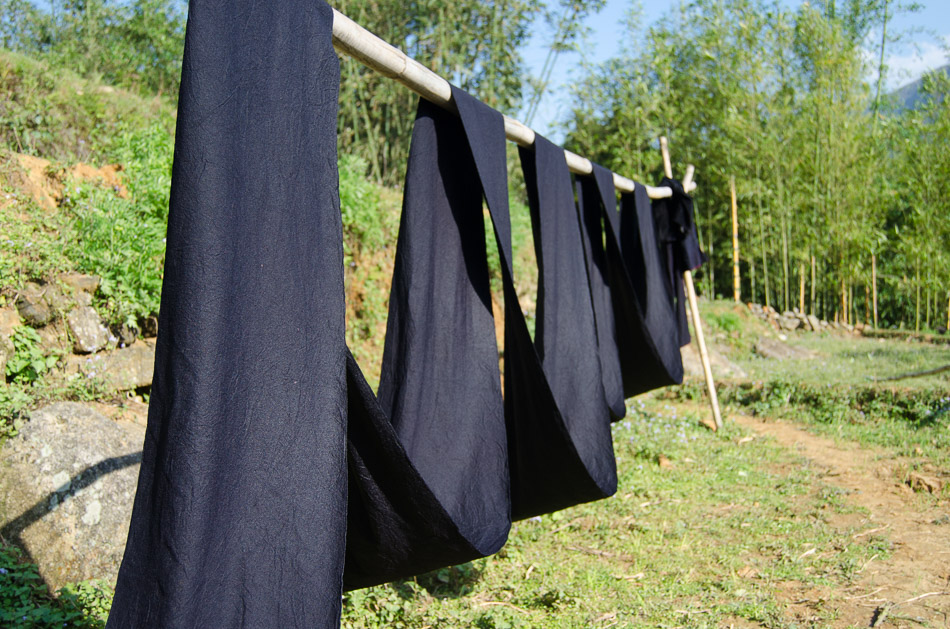
True colors
The other 3 Hmong women that followed us around came with a goal in mind: to sell. To sell as much as possible.
After a subtle sign from Mama Mae, they pulled out all sorts of knick-knacks from their wicker baskets: bracelets, wallets, shawls, and whistles, along with an aggressive selling tactic. They turned into unfazed vending machines that didn’t take “no” for an answer.
Back to Sapa on a motorbike
Having finished our full day trek, Mama Mae took us to the center of her village, calling two motorbike taxis to take us back to Sapa: 2.00€ each, paid by ourselves.
The ride back to Sapa alone was amazing. It’s not every day that someone can ride through valleys in Vietnam, with the sun setting behind the mountains and the last sunbeams reflecting on the rice paddies. That’s something we’ll never forget.
Trekking equipment
Keep it light and simple.
All you’ll need is a comfortable pair of sturdy shoes, light clothing, and a camera. Remember to take plenty of water, snacks, sunblock and you’ll be good to go.
As a side note, Sapa has plenty of shops that both rent and sell trekking gear.
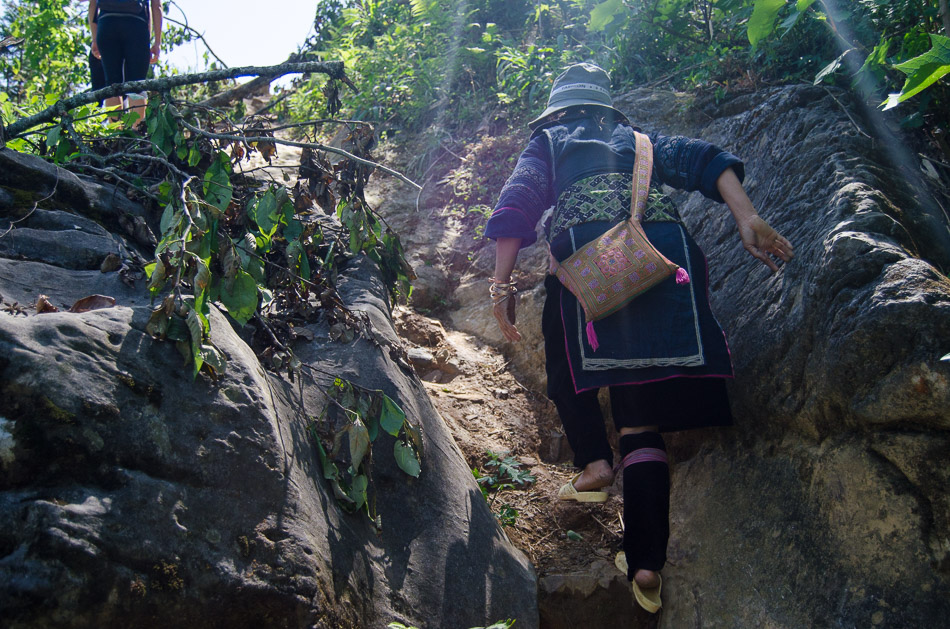
Full day trek expenses
Full day trek: 11€
Motorbike taxi: 2€
Water bottle: 0.60€
If you’re planning a trekking tour on Sapa we still have Mama Mae’s, Mama Bau’s and Mama Susu’s phone numbers and will gladly share them with you. Leave a reply down here or at any of our social media outlets and we’ll send it to you via email or PM.
Here’s a photo of Mama Mae taken in September 2018 by Cristelle — one of our readers. Cristelle reached out to us and asked for Mama Mae’s phone number. Two days later she was trekking with her in Sapa!
We’re super glad to contribute (even if in a small way) to your adventures, and by doing so helping Mama Mae on the other side of the world.
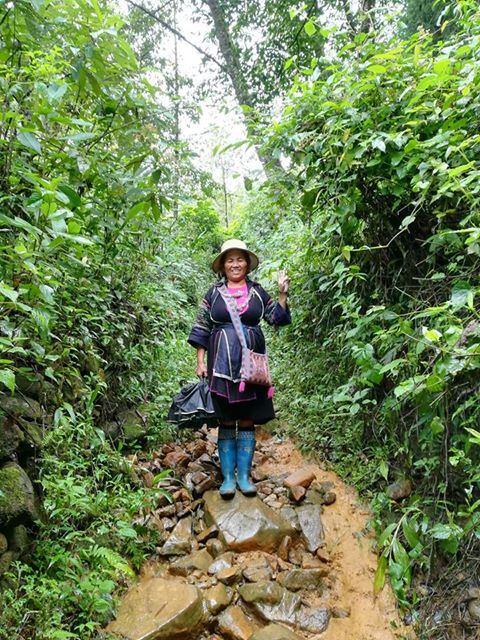
Mui Ne and the Police
After more than 5 hours on a bus, we arrived in Mui Ne at dinner time. The bus company we traveled on (Futa), conveniently dropped everybody at their accommodations—don’t know if it’s company policy or because all hotels are on that main road.
It was weird to travel on a sleeping bus during the day, luckily the WiFi worked just fine.
Looking for transportation to Mui Ne? Check out www.bookaway.com.
To get 5% off the ticket price use the code “gravy5″ at checkout.
As soon as we got our room at the 247 a/c Guesthouse we dropped the backpack on the floor and headed out to hunt for some dinner. Starving and not being fans of seafood, we needed some alternatives.
As we walked along Mui Ne’s main road a nice Vietnamese lady selling kitesurf packages and boat excursions invited us to see her menu. We were hungry and the photos on the menu looked good, so we said ‘yes’.
Let’s just say that we learned something that night: travel agencies are not restaurants.
Two days later we found an open-air food court named Dong Vui Square. A really cool place with a great selection of foods: from noodles to paella.
Mui Ne Beach
The next morning, after a bowl of fruit and muesli—which reminded us of our breakfasts in Ayutthaya—we went off to the beach. Or tried to at least.
From the terrace where we had breakfast, we could see the water peeking from between the houses. Even though it was right there in front of us, reaching it was a pain in the ass. Here’s why: along that main road we mentioned before, all sorts of buildings and private properties form a barrier between people and the beach.
To reach it we had to trespass private property, and like Bonnie & Clyde, we did. Later that day we found a “legal” crossing near the local market.
Mui Ne is a fishing village and the small round boats that look like plastic kiddie pools anchored in the open sea prove it.
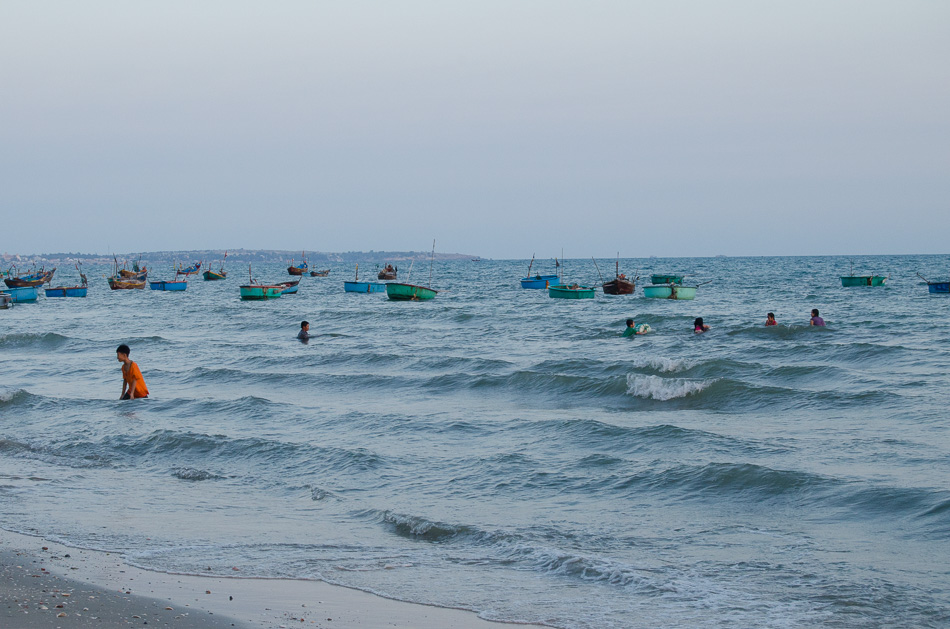
The coastal strip of sand stretches for several kilometers and is lined with tall coconut trees. The water is blue and the sun shines all year round. The beach has the potential to be in any travel catalog if it wasn’t for all the garbage scattered everywhere. So after a chat in the sand, we left.
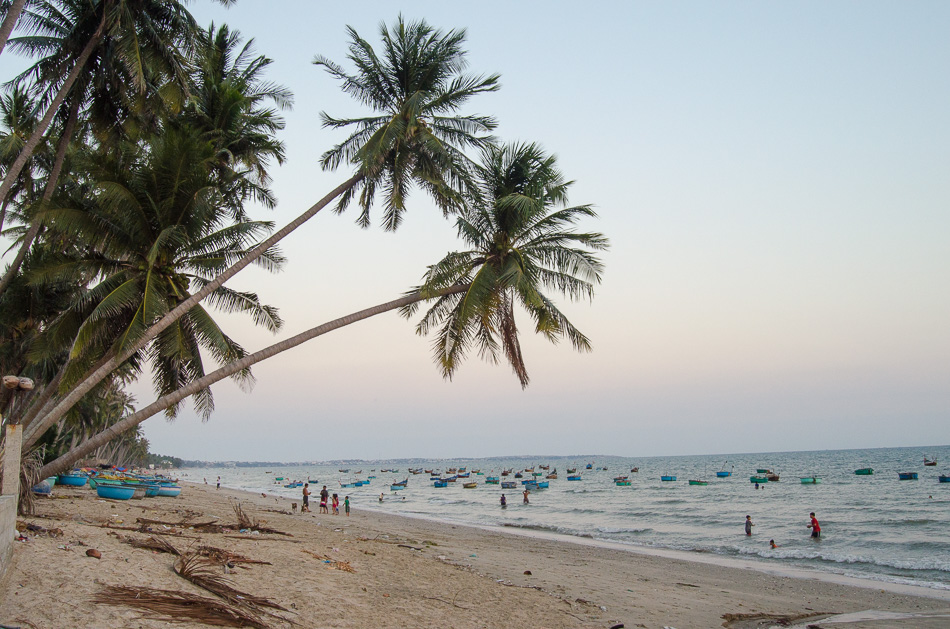
To explore more of Mui Ne, we rented a scooter.
The more west we got, the cleaner the beaches and the ocean.
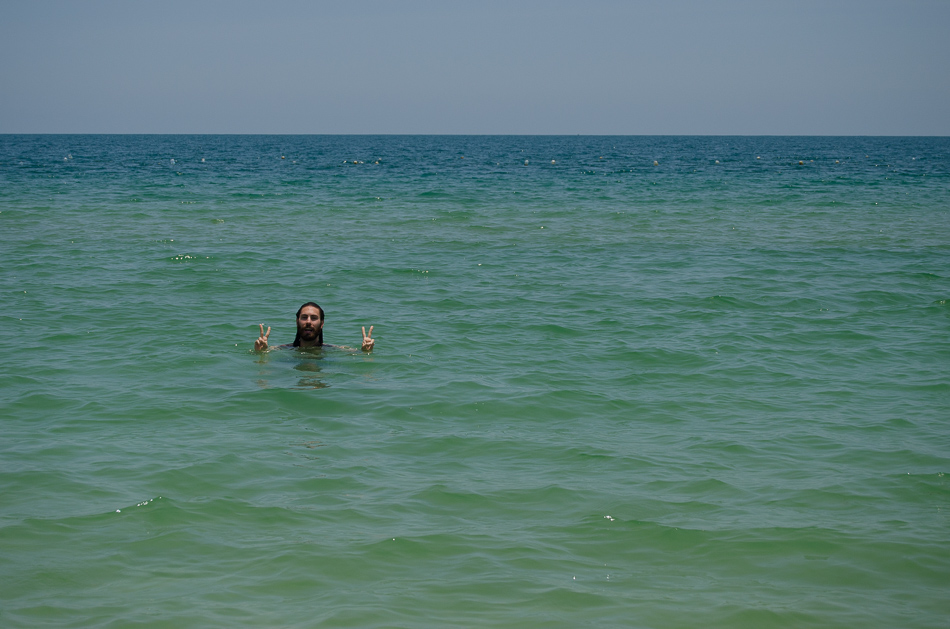
Learning to ride bikes in Kampot and understanding the convenience of driving, gave us the audacity to think that ‘from now on scooters are the way to go‘. So we rented one directly from our guesthouse for 80,000 Dongs (€ 3,20) for a whole day.
We rode to the actual fishing village of Mui Ne that appeared to have more boats than people. Unfortunately, besides a beautiful view from the high points, there’s not much to do around here. We stopped for lunch and took some photos.
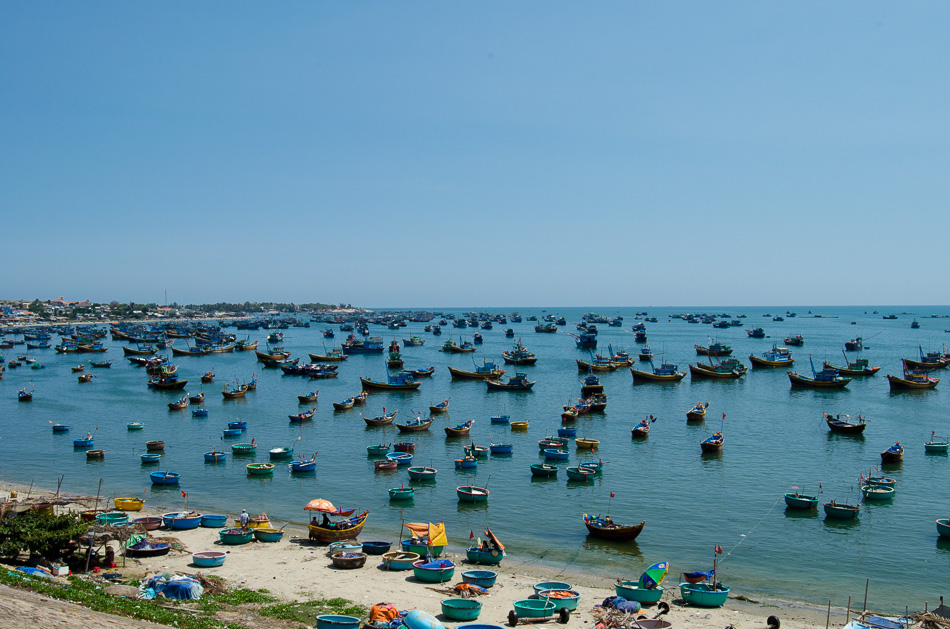
Running on the floor of the restaurant was a big rat looking for food, completely unfazed by humans—we named it Bertha.
Bertha looked strong and healthy, so the food had to be good.
Problems with the po-po
After lunch, we hopped on the bike and headed towards the White Sand Dunes of Mui Ne. Halfway through, two police officers pulled us over.
A very friendly officer holding a booklet approached us and asked for our international driver’s license, which we didn’t have. However, we anxiously flaunted our regular Portuguese ones, but by now, we knew we were in trouble.
He looked at us, frowned condescendingly, and flipped through the booklet showing us a bunch of gore illustrative images of what can happen to tourists driving without an international driver’s license. His portfolio included:
• Amputee tourist
• Tourist blood
• Reckless tourist speeding
• Tourist in a wheelchair
• Drunk tourist getting drunker planning to drive afterward
• A WordArt clock representing the short life of tourists that drive outside their country
Finally, he pointed to the page where the traffic fines were. According to him, it said we had to pay 1,200,000 Dongs or he would have to arrest us.
We didn’t have that amount of money, so he flipped the page again to a clause saying we had to pay 800,000 Dongs—which we didn’t have either.
Nuno and I were frantically searching for money in our wallets, pockets, and backpack. All we managed to put together was 300,000 Dongs and a pre-diarrhea feeling.
Seeing how upset we were, he grabbed the money from our hands, smiled, and said:
– Shhh. Ok, ok. I am your friend… You can go now. No more police ahead.
That was the moment we realized what had happened: we got scammed by a police officer. How nice!
We turned around and headed back to our guesthouse.
Getting over it
After doing the conversion from Dongs to Euros we realized that he ‘confiscated’ just €12, but it could have been much more.
To take our minds off what had happened, we went hiking in the Fairy Stream near the Mui Ne main road—as you may have noticed, almost everything extends along this road.
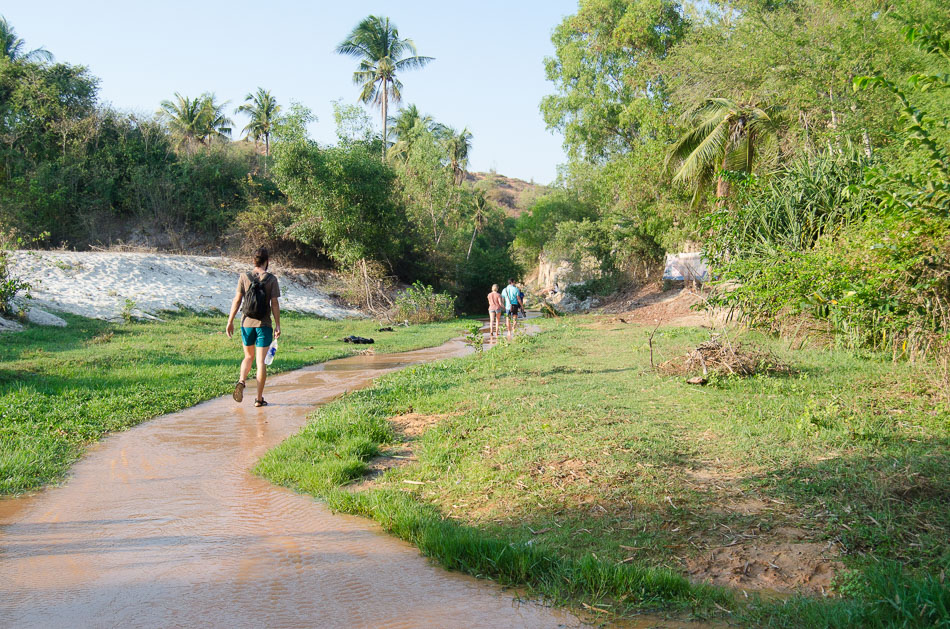
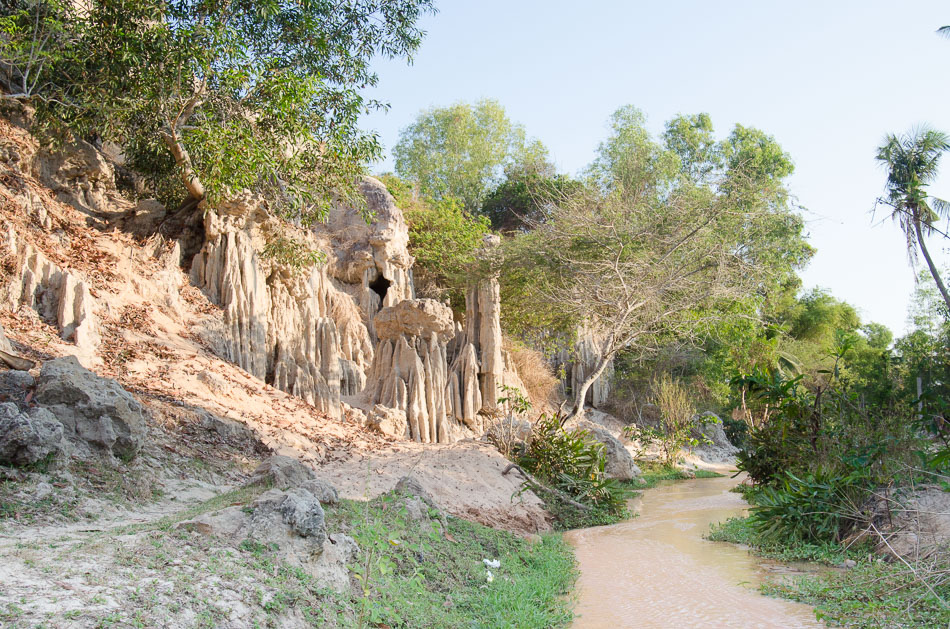
It is a small stream of freshwater where you can walk on and enjoy the surroundings. There are red dunes, rock formations, trees, ducks, and cows walking around.
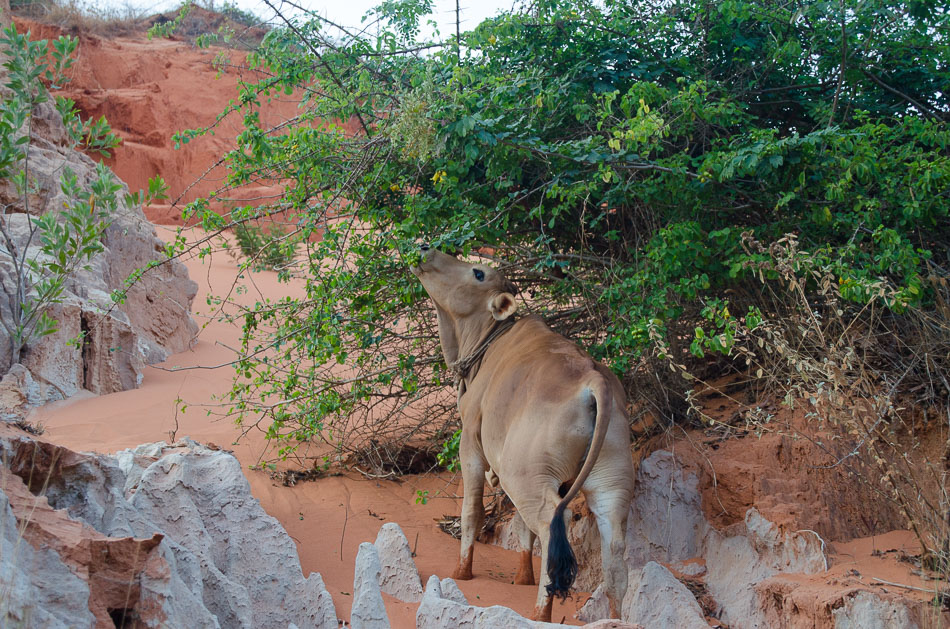
There’s no entrance fee around here, but rumor has it that some crafty locals might try to charge you for it. Also, if you get there by bike you will be charged for parking. To avoid it, park further from the entrance and walk there.
As a maritime zone, Mui Ne is slowly attracting upscale tourists to all the fancy resorts by the sea. It might not have much to explore, but it offers you good weather and a relaxed environment. Especially if you don’t find any police.
Mui Ne travel expenses (Daily average for 1 person)
Breakfast: € 1,85
Lunch: € 1,64
Dinner: € 3,31
Water: € 0,19
Coffee: € 0,57
Accommodation: € 3,50
Scooter: € 3,20
Half tank of fuel: € 1,18
If you have any questions or some extra info everybody can benefit from, please leave it down in the comments!
Must-see guide to Hue
Hue was made the capital of Vietnam in 1802 during the feudal dynasties that ruled the country. Nowadays, hundreds of historical relic sites remain in the city and are well worth our visit.
It was a very hot and rainy day when we got there, so we spent a big part of it in a cafe by the river waiting for a thunder storm to pass. There was a distinctive earthy scent from the rainfall and the view was stunning: a bridge over Perfume river with the Imperial City as the background.
For a Vietnamese standard, Hue can be considered somewhat of a “calmer city”.
For quite a few times we found ourselves walking and eating alone ̶ something that never happened around Hanoi, Saigon or Hoi An.
We stayed at the Ngoc Binh hotel not far from the Imperial City (approximately a 25 minute walk from the main entrance). Our room had a private bathroom, tv and included breakfast. Also, for one more dollar you could have AC in the room.
If you’re interested, check the hotel here.
The Imperial City
The Citadel opening hours are 8:00 to 17:30. For a proper visit, you’ll need at least 4 hours.
The entrance fee was 6.05€ for each of us.
You’ll find two different prices: one for locals and other for foreign tourists. Locals pay less of course. However, it was the first time we saw this price distinction at a Vietnamese monument ̶ at least in a noticeable way.
As we slowly walked through the central entrance in the Ngo Mon Gate to shelter ourselves from the rain that showed up that morning, our heads turned towards a young couple speaking in Portuguese.
– Bom dia!
There’s where we met Adriana and Diogo with whom we spent the rest of the visit.
The Citadel was made a UNESCO site in 1993, and is going through gradual reconstruction and restoration, as many of the buildings were destroyed by bombings from the war against the French (1947), the Americans (1968) and some typhoons.
Built in the 19th century, the complex was divided into 6 areas:
• Palaces compound,
• The forbidden purple city,
• Temple compounds,
• Residences,
• Internal affairs compound,
• The Royal gardens
There are countless walls and gates separating the different areas.
To see a digital reconstruction of the Imperial City in its prime, check the video:
We started the visit by the regal and colorful Thai Hoa Palace where major royal receptions and ceremonies were held. Here’s where you’ll find most tourists hanging out, but also a ton of information on the history and architecture of the citadel.
For the real touristy-tourists, you can dress in kitschy imperial clothes, sit on a throne and get your picture taken.
After walking outside for a while, we reached the Royal Theater. The building was reconstructed and now houses cultural performances like opera and royal dances, as well as a permanent exhibition with traditional theater costumes, masks and instruments.
Even though we didn’t watch any show at the theater, we were lucky enough to listen to a live performance on the Hall of Mandarins, by a group of musicians playing traditional instruments.
The only way out
By now it was lunchtime and inside the complex, we couldn’t find anything to eat besides snacks. Oddly enough, we were told that if we wanted to eat at a restaurant outside the imperial city, we had to buy a new ticket to get in.
Adriana and Diogo suggested to try our luck with one of the guards at a secondary gate:
–He might let us out for lunch and re-enter without having to buy a new ticket…
Reluctantly the guard said yes, but not before snapping a picture of all of us with his phone (just to make sure he wouldn’t confuse us with other western people trying to get in). After all, all of us westerns look the same… 😀
Getting back in
In the afternoon we visited the ruins of the Forbidden Purple City and the Emperor’s Reading room. The Forbidden Purple City is like a citadel within a citadel, where only the Emperor, his family, his concubines, and eunuchs lived.
The entire complex is enormous and well-gardened for the most part. The restored buildings encompassed by ponds, trees, and singing birds create a calm environment where you can walk calmly for hours ̶ and forget the intense fighting that happened there just a few decades ago.
Ceramic and glass dragons are a constant decorative element throughout the architecture, as they are symbols of the monarchy.
The temple complex of To Mieu and the 9 dynastic urns, a tribute and worshiping place to the emperors of past dynasties:
It’s funny how in almost every Southeast Asian country you might leave your shoes behind at the entrance of an empty monument, but when you get out, you find this:
Portuguese synchronism
At the end of the visit, we had to say goodbye to our Portuguese friends Adriana and Diogo.
Coincidently, on our way back to the hotel, we got in a tiny French bakery for an afternoon snack and met a Portuguese girl named Ana. The conversation flowed for hours. Living in Hue for a year and a half, she’d never met other Portuguese people in the city.
Moving on
With so much of Vietnam still to see and our Visa expiration date getting closer, we had to move on from Hue to our next destination: Hanoi.
As a former capital of Vietnam, Hue has much more to offer besides the Imperial City. If you can hang around for a bit more time, these are the other places worth your visit:
• A bicycle ride through the countryside
• Tu Duc Tomb (Entrance fee 3.30€ / closed for lunch: 11:30 to 13:30)
• Hue Temple of Literature
• Thien Mu Pagoda (free entrance)
• The tomb of King Minh Mang (Entrance fee 3.30€)
• The tomb of King Khai Dinh (Entrance fee 3,30€)
• Dong Ba Market (Messy and authentic, with great street food. Be prepared to bargain!)
• Hue Festival of Culture and Arts (Held every 2 years, the next one will be in 2018)
Hue daily expenses (average for 1 person)
Imperial City entrance ticket: 6,05€
Coffee: 0.62€
1.5L Water bottle: 0.30€
Lunch: 2.28€
Dinner: 3.05€
Accommodation: 4,02€
Bus Hoi An > Hue: 3,91€
If you have any questions or some extra info to share, please leave it in the comments below. Thank you!

